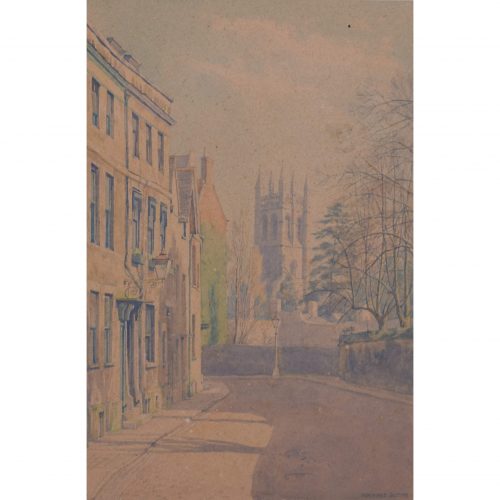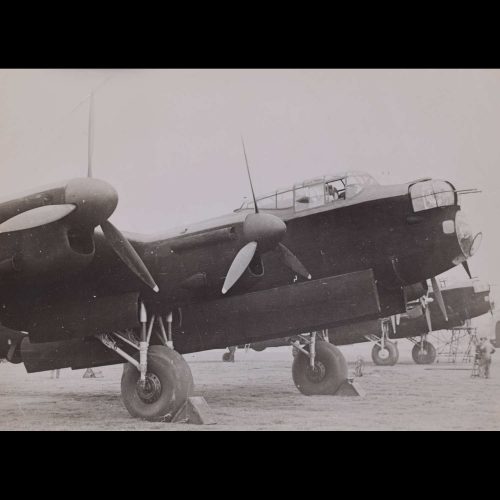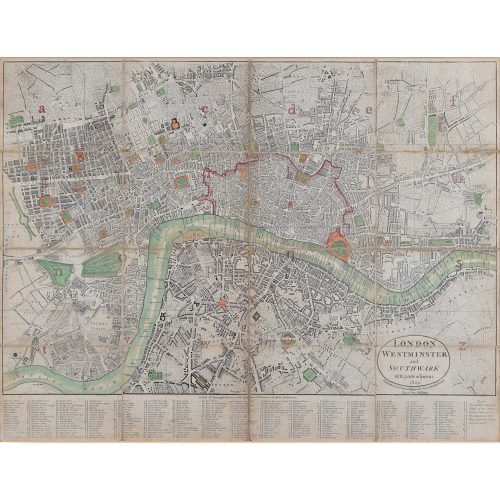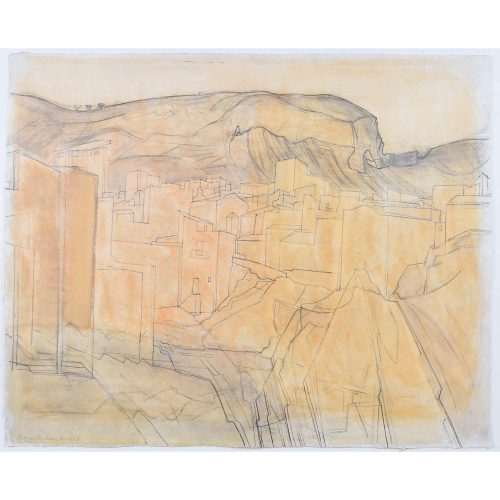-
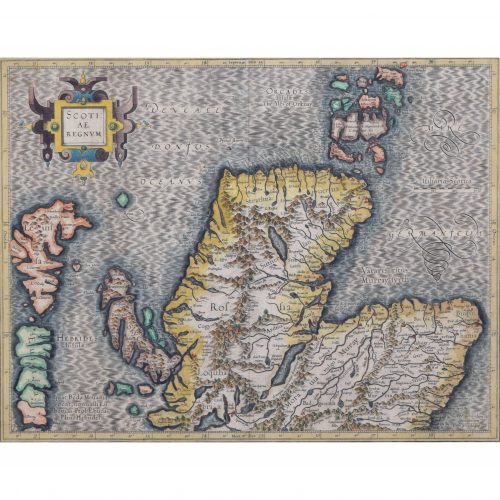
Gerardus Mercator (1512 - 1594)
Map of the North of Scotland (1683)
Engraving with later hand colouring 35 x 45 cm A fantastically characterful and detailed map engraving of the North of Scotland from 1683. The highly detailed and beautifully coloured map is inscribed to the reverse with a description of the parts of Scotland illustrated, called the ''Troisieme Table d''Escosse''. The map comes from the 1683 French edition of Gerardus Mercator''s Atlas Major, which was first published in 1585. Gerardus Mercator was the Flemish father of mapmaking. He was a skilled geographer, cosmographer and cartographer and is most renowned for creating the 1569 world map based on a new projection which represented sailing courses of constant bearing (rhumb lines) as straight lines - an innovation that is still employed in today''s nautical charts. Mercator was a highly influential pioneer in the history of cartography and is generally considered one of the founders of the Netherlandish school of cartography and geography. He is also widely considered the most notable figure of the school. In his own day, he was a notable maker of globes and scientific instruments. In addition, he had interests in theology, philosophy, history, mathematics and geomagnetism. He was also an accomplished engraver and calligrapher. Unlike other great scholars of the age, he travelled little and his knowledge of geography came from his library of over a thousand books and maps, from his visitors and from his vast correspondence (in six languages) with other scholars, statesmen, travellers, merchants and seamen. Mercator''s early maps were in large formats suitable for wall mounting but in the second half of his life, he produced over 100 new regional maps in a smaller format suitable for binding into his Atlas of 1595. This was the first appearance of the word Atlas in reference to a book of maps. However, Mercator used it as a neologism for a treatise (Cosmologia) on the creation, history and description of the universe, not simply a collection of maps. He chose the word as a commemoration of the Titan Atlas, "King of Mauretania", whom he considered to be the first great geographer. Mercator wrote on geography, philosophy, chronology and theology. All of the wall maps were engraved with copious text on the region concerned. As an example, the famous world map of 1569 is inscribed with over five thousand words in fifteen legends. Condition: a little spotting, primarily to margins. If you’d like to know more, please email info@manningfineart.co.uk or call us on 07929 749056. -
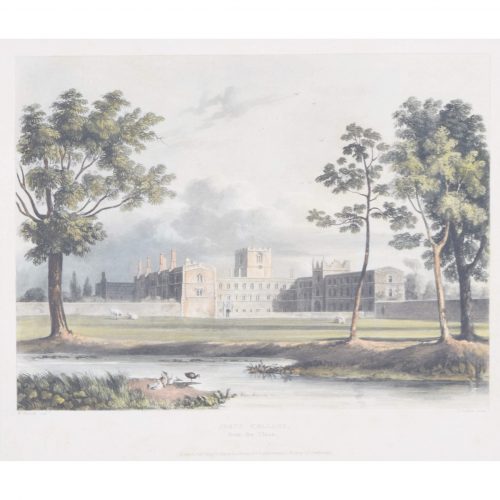
Joseph Constantine Stadler (1755 - 1828) after William Westall (1781 - 1850)
Jesus College, Cambridge, from the Close (1815)
Hand-coloured aquatint 24 x 29.5 cm Published by Rudolph Ackermann (1764 - 1834). An engraving of Jesus College, foregrounded by trees, the River Cam, and grazing cattle. Joseph Constantine Stadler was a prolific German émigré engraver of images after his contemporaries - here, 18th-century English landscape painter and diarist Joseph Farington. Stadler''s engravings are wide-ranging in subject matter and include landscapes, seascapes and portraits, as well as military, sporting and decorative subjects. Stadler was employed by the leading print publisher of the time, John Boydell. Stadler lived in Knightsbridge when he died at the age of 73. William Westall was a British landscape artist. He was born in Hertford and enrolled at the Royal Academy schools in 1799. He later became the draughtsman for a voyage to Australia and the South Seas. After being shipwrecked, he travelled to Canton in China and to India, staying in Bombay for several months. He returned to England in 1805 but later set off for Madeira and Jamaica. He became a member of the Society of Painters in Water Colours (1811) and an associate of the Academy (1812). Following a mental breakdown, he regularly visited the Lake District and published ‘Views of the Valley and Vale of Keswick’ (1820). His series of aquatints of the Thames, the great universities, and England's public schools for Ackermann are among his most popular works. Rudolph Ackermann was an Anglo-German bookseller, inventor, lithographer, publisher and businessman. In 1795 he established a print-shop and drawing-school at 96 Strand. Here Ackermann set up a lithographic press and began a trade in prints. He later began to manufacture colours and thick carton paper for landscape and miniature painters. Within three years the premises had become too small and he moved to 101 Strand, in his own words "four doors nearer to Somerset House", the seat of the Royal Academy of Arts. Between 1797 and 1800 Ackermann rapidly developed his print and book publishing business, encompassing many different genres including topography, caricature, portraits, transparencies and decorative prints. Condition: good. Some age toning. If you’d like to know more, please email info@manningfineart.co.uk or call us on 07929 749056. -
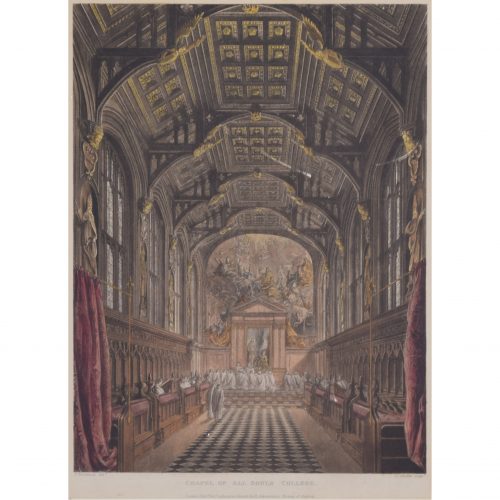
Joseph Constantine Stadler (1755 - 1828) after Frederick Mackenzie (1788 - 1854)
The Chapel of All Souls College, Oxford (1814)
Hand-coloured aquatint 29.5 x 21 cm Published by Rudolph Ackermann (1764 – 1834). An engraving of All Souls' chapel. All Souls College was founded in 1437 by Henry Chichele, Archbishop of Canterbury, to serve as a memorial to Henry V and the English dead in the Hundred Years War. The Front Quad appears virtually unchanged since it was first built in the years 1438-1343, thanks to a sympathetic Victorian restoration. The chapel was modelled after that of New College, where Chichele was a Member. It has a superb hammer-beam roof, excellent mediaeval stained glass, and a large number of original stalls. All services in the chapel are according to the Book of Common Prayer; the King James Bible is also used rather than more modern translations. Frederick Mackenzie (circa 1788 - 1854) was a British watercolourist and architectural draughtsman. He first exhibited at the Royal Academy in 1804, and contributed eleven drawings between that year and 1828. He contributed to the Society of Painters in Water Colours exhibitions from 1813, becoming an associate in 1822, and a full member the following year. From 30 November 1831 until, his death he was treasurer to the society. In later life Mackenzie was no longer commissioned to illustrate books. Joseph Constantine Stadler was a prolific German émigré engraver of images after his contemporaries - here, 18th-century English landscape painter and diarist Joseph Farington. Stadler''s engravings are wide-ranging in subject matter and include landscapes, seascapes and portraits, as well as military, sporting and decorative subjects. Stadler was employed by the leading print publisher of the time, John Boydell. Stadler lived in Knightsbridge when he died at the age of 73. Rudolph Ackermann was an Anglo-German bookseller, inventor, lithographer, publisher and businessman. In 1795 he established a print-shop and drawing-school at 96 Strand. Here Ackermann set up a lithographic press and began a trade in prints. He later began to manufacture colours and thick carton paper for landscape and miniature painters. Within three years the premises had become too small and he moved to 101 Strand, in his own words "four doors nearer to Somerset House", the seat of the Royal Academy of Arts. Between 1797 and 1800 Ackermann rapidly developed his print and book publishing business, encompassing many different genres including topography, caricature, portraits, transparencies and decorative prints. Condition: good. Some age toning. If you’d like to know more, please email info@manningfineart.co.uk or call us on 07929 749056. -
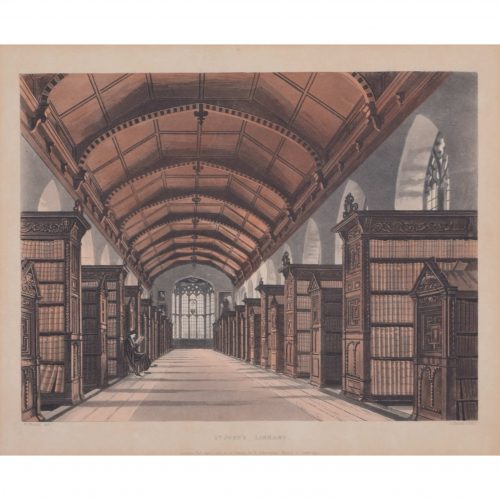
D Havell (1785 - 1822) after William Westall (1781 - 1850)
The Library of St John's College, Cambridge (1815)
Hand-coloured aquatint 24 x 29.5 cm Published by Rudolph Ackermann (1764 - 1834). An engraving of St John's College, Cambridge's marvellous library. It was built between 1623 and 1628, largely through the donations and efforts of two members of the college: Valentine Carey, Bishop of Exeter, and John Williams, Lord-Keeper and Bishop of Lincoln. The building's shell was completed in 1624, a date which appears on the south gable of the western oriel window. The building is constructed in the Jacobean Gothic style, and measures 110 feet by 30 feet wide. The tall two-light windows are a very early example of Gothic Revival, but the façade is Renaissance-inspired. The library contains 42 bookcases arranged at right angles to the north and south walls, and is the home of the College's double-manual harpsichord. William Westall was a British landscape artist. He was born in Hertford and enrolled at the Royal Academy schools in 1799. He later became the draughtsman for a voyage to Australia and the South Seas. After being shipwrecked, he travelled to Canton in China and to India, staying in Bombay for several months. He returned to England in 1805 but later set off for Madeira and Jamaica. He became a member of the Society of Painters in Water Colours (1811) and an associate of the Academy (1812). Following a mental breakdown, he regularly visited the Lake District and published ‘Views of the Valley and Vale of Keswick’ (1820). His series of aquatints of the Thames, the great universities, and England''s public schools for Ackermann are among his most popular works. The Havell family of Reading, Berkshire, England, included a number of notable engravers, etchers and painters, as well as writers, publishers, educators, and musicians. Daniel and Robert Havell set up in partnership as aquatint engravers. Soon Daniel began to work independently, engraving plates for Rudolph Ackermann''s History of Cambridge (1815) and hid history of various public schools including Eton, Winchester, and Rugby (1816), as well as a celebrated views of St Paul''s Cathedral (1818) and various other London landmarks for Ackermann''s Repository of Arts. Rudolph Ackermann was an Anglo-German bookseller, inventor, lithographer, publisher and businessman. In 1795 he established a print-shop and drawing-school at 96 Strand. Here Ackermann set up a lithographic press and began a trade in prints. He later began to manufacture colours and thick carton paper for landscape and miniature painters. Within three years the premises had become too small and he moved to 101 Strand, in his own words "four doors nearer to Somerset House", the seat of the Royal Academy of Arts. Between 1797 and 1800 Ackermann rapidly developed his print and book publishing business, encompassing many different genres including topography, caricature, portraits, transparencies and decorative prints. Condition: good. Some age toning. If you’d like to know more, please email info@manningfineart.co.uk or call us on 07929 749056. -
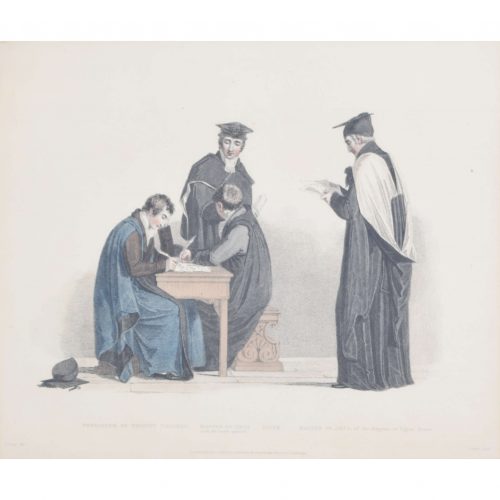
John Samuel Agar (1773 - 1858) after John Uwins (1782 - 1857)
Pensioner of Trinity College, Masters of Arts, and Sizer (1815)
Hand-coloured aquatint 25 x 30 cm Published by Rudolph Ackermann (1764 - 1834). An engraving of a pensioner of Trinity College, Masters of Arts, and a sizer (that is, an undergraduate who receives some form of assistance such as meals, lower fees or lodging during his or her period of study, in some cases in return for doing a defined job) from Ackermann's ''A History of the University of Cambridge, Its Colleges, Halls and Public Buildings''. The four figures walk forward with ceremonial accoutrements, likely to a graduation ceremony. At Cambridge, a sizar was originally an undergraduate student who financed his studies by undertaking more or less menial tasks within his college but, as time went on, was increasingly likely to receive small grants from the college. Certain colleges, including St John's and Trinity, distinguished between two categories of sizar: there were specific endowments for specific numbers of sizars who were called "proper sizars"; those who were not so endowed, but who were maintained by fellow-commoners and fellows were called subsizars. Isaac Newton matriculated as subsizar at Trinity College. Richard S. Westfall noted that sizars were considerably more successful in gaining degrees than the gentlemen who entered Cambridge in the seventeenth century. Thomas Uwins RA RWS was a British painter in watercolour and oil, and a book illustrator. He became a full member of the Old Watercolour Society and a Royal Academician, and held a number of high-profile art appointments including the librarian of the Royal Academy, Surveyor of Pictures to Queen Victoria and the Keeper of the National Gallery. In the late 1790s he began producing work for Ackermann''s collections. John Samuel Agar was an English portrait painter and engraver, who exhibited his works at the Royal Academy from 1796 to 1806 and at the British Institution until 1811. He was at one time president of the Society of Engravers. Rudolph Ackermann published many of his engravings. Rudolph Ackermann was an Anglo-German bookseller, inventor, lithographer, publisher and businessman. In 1795 he established a print-shop and drawing-school at 96 Strand. Here Ackermann set up a lithographic press and began a trade in prints. He later began to manufacture colours and thick carton paper for landscape and miniature painters. Within three years the premises had become too small and he moved to 101 Strand, in his own words "four doors nearer to Somerset House", the seat of the Royal Academy of Arts. Between 1797 and 1800 Ackermann rapidly developed his print and book publishing business, encompassing many different genres including topography, caricature, portraits, transparencies and decorative prints. Condition: good. Some age toning. If you’d like to know more, please email info@manningfineart.co.uk or call us on 07929 749056. -
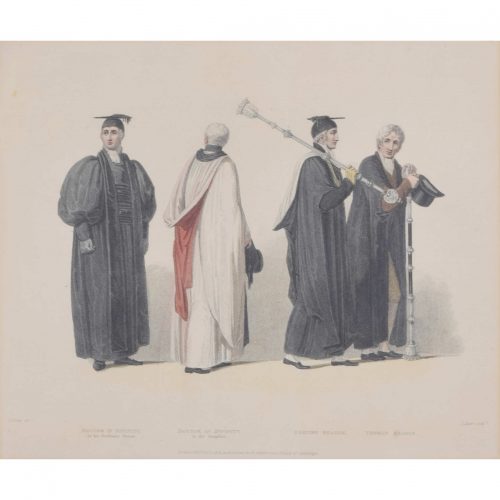
John Samuel Agar (1773 - 1858) after John Uwins (1782 - 1857)
Doctors in Divinity, Esquire Beadle, and Yeoman Beadle (1815)
Hand-coloured aquatint 25 x 30 cm Published by Rudolph Ackermann (1764 - 1834). An engraving of two Doctors in Divinity and two beadles (administrative assistants to the Chancellor and Proctors of the University) from Ackermann's ''A History of the University of Cambridge, Its Colleges, Halls and Public Buildings''. The four figures walk forward with ceremonial accoutrements, likely to a graduation ceremony. Thomas Uwins RA RWS was a British painter in watercolour and oil, and a book illustrator. He became a full member of the Old Watercolour Society and a Royal Academician, and held a number of high-profile art appointments including the librarian of the Royal Academy, Surveyor of Pictures to Queen Victoria and the Keeper of the National Gallery. In the late 1790s he began producing work for Ackermann''s collections. John Samuel Agar was an English portrait painter and engraver, who exhibited his works at the Royal Academy from 1796 to 1806 and at the British Institution until 1811. He was at one time president of the Society of Engravers. Rudolph Ackermann published many of his engravings. Rudolph Ackermann was an Anglo-German bookseller, inventor, lithographer, publisher and businessman. In 1795 he established a print-shop and drawing-school at 96 Strand. Here Ackermann set up a lithographic press and began a trade in prints. He later began to manufacture colours and thick carton paper for landscape and miniature painters. Within three years the premises had become too small and he moved to 101 Strand, in his own words "four doors nearer to Somerset House", the seat of the Royal Academy of Arts. Between 1797 and 1800 Ackermann rapidly developed his print and book publishing business, encompassing many different genres including topography, caricature, portraits, transparencies and decorative prints. Condition: good. Some age toning. If you’d like to know more, please email info@manningfineart.co.uk or call us on 07929 749056. -
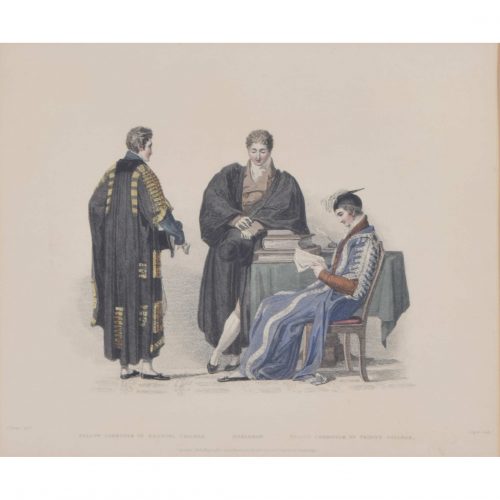
John Samuel Agar (1773 - 1858) after John Uwins (1782 - 1857)
Fellow Commoner of Emanuel College; a Nobleman; Fellow Commoner of Trinity College (1815)
Hand-coloured aquatint 25 x 29.5 cm Published by Rudolph Ackermann (1764 - 1834). An engraving of two students and a nobleman from Ackermann's ''A History of the University of Cambridge, Its Colleges, Halls and Public Buildings''. The three figures dwell over a pile of books and papers, clad in the appropriate academic dress. Thomas Uwins RA RWS was a British painter in watercolour and oil, and a book illustrator. He became a full member of the Old Watercolour Society and a Royal Academician, and held a number of high-profile art appointments including the librarian of the Royal Academy, Surveyor of Pictures to Queen Victoria and the Keeper of the National Gallery. In the late 1790s he began producing work for Ackermann''s collections. John Samuel Agar was an English portrait painter and engraver, who exhibited his works at the Royal Academy from 1796 to 1806 and at the British Institution until 1811. He was at one time president of the Society of Engravers. Rudolph Ackermann published many of his engravings. Rudolph Ackermann was an Anglo-German bookseller, inventor, lithographer, publisher and businessman. In 1795 he established a print-shop and drawing-school at 96 Strand. Here Ackermann set up a lithographic press and began a trade in prints. He later began to manufacture colours and thick carton paper for landscape and miniature painters. Within three years the premises had become too small and he moved to 101 Strand, in his own words "four doors nearer to Somerset House", the seat of the Royal Academy of Arts. Between 1797 and 1800 Ackermann rapidly developed his print and book publishing business, encompassing many different genres including topography, caricature, portraits, transparencies and decorative prints. Condition: good. Some age toning. If you’d like to know more, please email info@manningfineart.co.uk or call us on 07929 749056. -
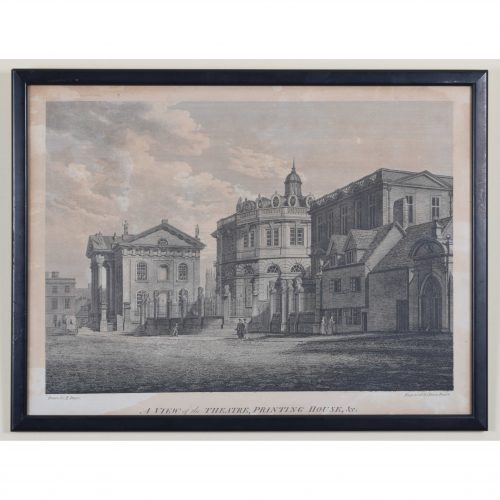
James Basire II (1769 - 1822) after Edward Dayes (1763 - 1804)
A View of the Theatre, Printing House, & c. (1800)
Engraving 36 x 49 cm A view of Broad Street, showing the Clarendon Building, Sheldonian Theatre, and what is now the Museum of the History of Science. Edward Dayes' drawing was reproduced as a lithograph in 1800, to be published in the "Oxford Almanack". The Oxford Almanack was an annual almanack published by the Oxford University Press for the University of Oxford from 1674 through 2019 (when printing sadly ceased due to "dwindling interest"). The almanack traditionally included engravings or lithographs of the University and information about the upcoming year. Other almanack artists have included Michael Burghers, J. M. W. Turner, and John Piper. Basire and Dayes collaborated on several views of Oxford during the courses of their careers. Edward Dayes was a British painter and engraver. He exhibited topographical views at the Royal Academy from 1786 until his death, and is the author of an ''Excursion through Derbyshire and Yorkshire,'' ''Essays on Painting; Instructions for Drawing and Colouring Landscapes'', and ''Professional Sketches of Modem Artists''. James Basire II was a British engraver, son of James Basire I, also a celebrated engraver. In 1802 he became Engraver to the Society of Antiquaries. Condition: some browning, as visible in photograph. If you’d like to know more, please email info@manningfineart.co.uk or call us on 07929 749056. -
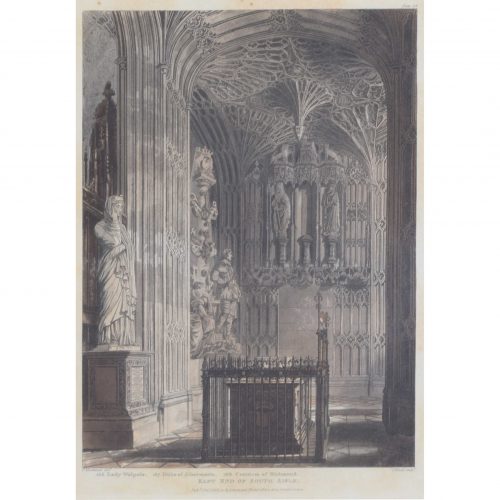
J Black (early 19th century) after Frederick Mackenzie (1788 - 1854)
East End of South Aisle, Westminster Abbey (1812)
Hand-coloured aquatint 31 x 24 cm Published by Rudolph Ackermann (1764 - 1834). An engraving of the East End of Westminster Abbey's south aisle. Mackenzie's drawing was engraved by Black and published by Ackermann in his 1812 "History of Westminster Abbey". Charles II, Queen Anne, Queen Mary II and her husband King William III, and Mary, Queen of Scots are all buried in the south aisle. The Abbey is an historic, mainly Gothic church in the City of Westminster, London, just to the west of the Palace of Westminster. It is one of the United Kingdom's most notable religious buildings and since Edward the Confessor, a burial site for English and, later, British monarchs. Since the coronation of William the Conqueror in 1066, all coronations of English and British monarchs have occurred in Westminster Abbey. Sixteen royal weddings have occurred at the abbey since 1100. According to a tradition first reported circa 1080, a church was founded at the site (then known as Thorney Island) in the seventh century, in the time of Mellitus, Bishop of London. Construction of the present church began in 1245 on the orders of Henry III. Frederick Mackenzie (1788 - 1854) was a British watercolourist and architectural draughtsman. He first exhibited at the Royal Academy in 1804, and contributed eleven drawings between that year and 1828. He contributed to the Society of Painters in Water Colours exhibitions from 1813, becoming an associate in 1822, and a full member the following year. From 30 November 1831 till his death he was treasurer to the society. In later life Mackenzie was no longer commissioned to illustrate books. Rudolph Ackermann was an Anglo-German bookseller, inventor, lithographer, publisher and businessman. In 1795 he established a print-shop and drawing-school at 96 Strand. Here Ackermann set up a lithographic press and began a trade in prints. He later began to manufacture colours and thick carton paper for landscape and miniature painters. Within three years the premises had become too small and he moved to 101 Strand, in his own words "four doors nearer to Somerset House", the seat of the Royal Academy of Arts. Between 1797 and 1800 Ackermann rapidly developed his print and book publishing business, encompassing many different genres including topography, caricature, portraits, transparencies and decorative prints. Condition: good. Some age toning. If you’d like to know more, please email info@manningfineart.co.uk or call us on 07929 749056. -
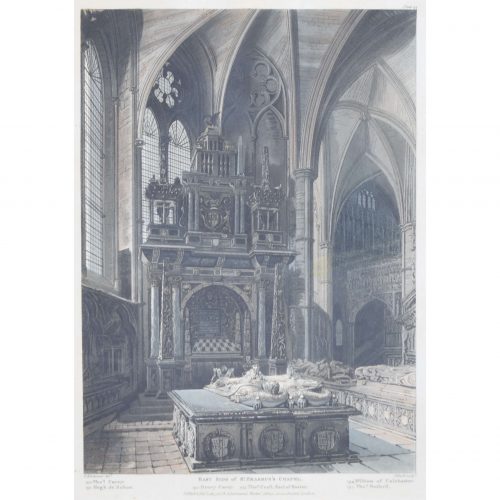
J Black (early 19th century) after Frederick Mackenzie (1788 - 1854)
East Side of St Erasmus' Chapel, Westminster Abbey (1812)
Hand-coloured aquatint 28 x 19 cm Published by Rudolph Ackermann (1764 - 1834). An engraving of the east side of the chapel of St Erasmus in Westminster Abbey. Mackenzie's drawing was engraved by Black and published by Ackermann in his 1812 "History of Westminster Abbey". The chapel was built in the late 15th century by order of Edward IV's wife, Elizabeth Woodville. It would have been used to worship St Erasmus, also known as St Elmo (a Christian saint and martyr venerated as the patron saint of sailors and abdominal pain). The Abbey is an historic, mainly Gothic church in the City of Westminster, London, just to the west of the Palace of Westminster. It is one of the United Kingdom's most notable religious buildings and since Edward the Confessor, a burial site for English and, later, British monarchs. Since the coronation of William the Conqueror in 1066, all coronations of English and British monarchs have occurred in Westminster Abbey. Sixteen royal weddings have occurred at the abbey since 1100. According to a tradition first reported circa 1080, a church was founded at the site (then known as Thorney Island) in the seventh century, in the time of Mellitus, Bishop of London. Construction of the present church began in 1245 on the orders of Henry III. Frederick Mackenzie (1788 - 1854) was a British watercolourist and architectural draughtsman. He first exhibited at the Royal Academy in 1804, and contributed eleven drawings between that year and 1828. He contributed to the Society of Painters in Water Colours exhibitions from 1813, becoming an associate in 1822, and a full member the following year. From 30 November 1831 till his death he was treasurer to the society. In later life Mackenzie was no longer commissioned to illustrate books. Rudolph Ackermann was an Anglo-German bookseller, inventor, lithographer, publisher and businessman. In 1795 he established a print-shop and drawing-school at 96 Strand. Here Ackermann set up a lithographic press and began a trade in prints. He later began to manufacture colours and thick carton paper for landscape and miniature painters. Within three years the premises had become too small and he moved to 101 Strand, in his own words "four doors nearer to Somerset House", the seat of the Royal Academy of Arts. Between 1797 and 1800 Ackermann rapidly developed his print and book publishing business, encompassing many different genres including topography, caricature, portraits, transparencies and decorative prints. Condition: good. Some age toning. If you’d like to know more, please email info@manningfineart.co.uk or call us on 07929 749056. -
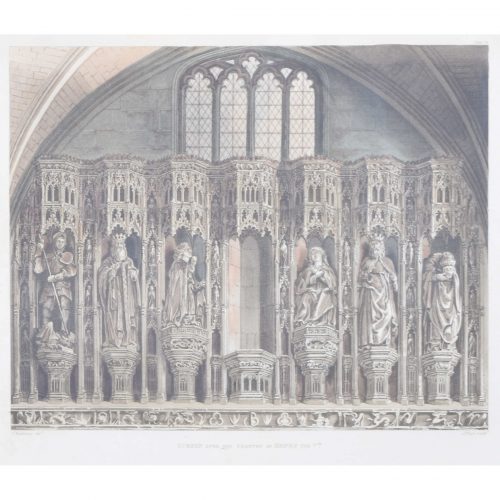
J Black (early 19th century) after Frederick Mackenzie (1788 - 1854)
Screen Over the Chantry of Henry V, Westminster Abbey (1812)
Hand-coloured aquatint 26 x 31 cm Published by Rudolph Ackermann (1764 - 1834). An engraving of the gothic screen of the elaborately carved chantry chapel dedicated to Henry V, and below which lies his tomb, in Westminster Abbey. Mackenzie's drawing was engraved by Black and published by Ackermann in his 1812 "History of Westminster Abbey". The Abbey is an historic, mainly Gothic church in the City of Westminster, London, just to the west of the Palace of Westminster. It is one of the United Kingdom''s most notable religious buildings and since Edward the Confessor, a burial site for English and, later, British monarchs. Since the coronation of William the Conqueror in 1066, all coronations of English and British monarchs have occurred in Westminster Abbey. Sixteen royal weddings have occurred at the abbey since 1100. According to a tradition first reported circa 1080, a church was founded at the site (then known as Thorney Island) in the seventh century, in the time of Mellitus, Bishop of London. Construction of the present church began in 1245 on the orders of Henry III. Frederick Mackenzie (1788 - 1854) was a British watercolourist and architectural draughtsman. He first exhibited at the Royal Academy in 1804, and contributed eleven drawings between that year and 1828. He contributed to the Society of Painters in Water Colours exhibitions from 1813, becoming an associate in 1822, and a full member the following year. From 30 November 1831 till his death he was treasurer to the society. In later life Mackenzie was no longer commissioned to illustrate books. Rudolph Ackermann was an Anglo-German bookseller, inventor, lithographer, publisher and businessman. In 1795 he established a print-shop and drawing-school at 96 Strand. Here Ackermann set up a lithographic press and began a trade in prints. He later began to manufacture colours and thick carton paper for landscape and miniature painters. Within three years the premises had become too small and he moved to 101 Strand, in his own words "four doors nearer to Somerset House", the seat of the Royal Academy of Arts. Between 1797 and 1800 Ackermann rapidly developed his print and book publishing business, encompassing many different genres including topography, caricature, portraits, transparencies and decorative prints. Condition: good. Some age toning. If you’d like to know more, please email info@manningfineart.co.uk or call us on 07929 749056. -
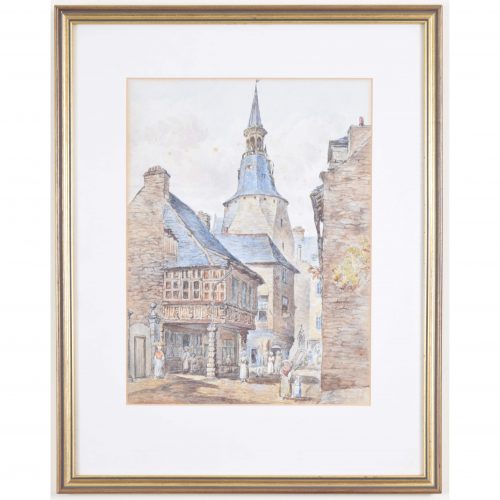
Attributed to Antony Vandyke Copley Fielding (1787 - 1855)
Dinan Tour de l’Horloge (Dinan Clock Tower)
Watercolour 28 x 21 cm A spirited watercolour of Dinan, Brittany. Dinan's famous clock tower looks over a French street scene: men, women, and children weave through the town's half-timbered houses, shops, and ateliers. The characterful mediaeval stonework and architecture of the town are paramount, and the artist adds a bright blue hue to his depiction of Dinan's roofs. Dinan is a walled medieval Breton town and commune in the Côtes-d'Armor department of northwestern France. Enclosed by nearly three kilometres of ramparts, the town and its 14th-century castle proudly overlook the Rance river. Anthony Vandyke Copley Fielding, commonly called Copley Fielding, was an English painter famous for his watercolour landscapes. At an early age Fielding became a pupil of John Varley. In 1810 he became an associate exhibitor in the Old Watercolour Society (later known as the Royal Society of Watercolours), in 1813 a full member, and in 1831 the Society's President. In 1824 he won a gold medal at the Paris Salon, alongside Richard Parkes Bonington and John Constable. Examples of his work are held by the Victoria and Albert Museum and other major museums in Britain. Condition: good. Some spotting to sky; handsomely framed. If you’d like to know more, please email info@manningfineart.co.uk or call us on 07929 749056. -
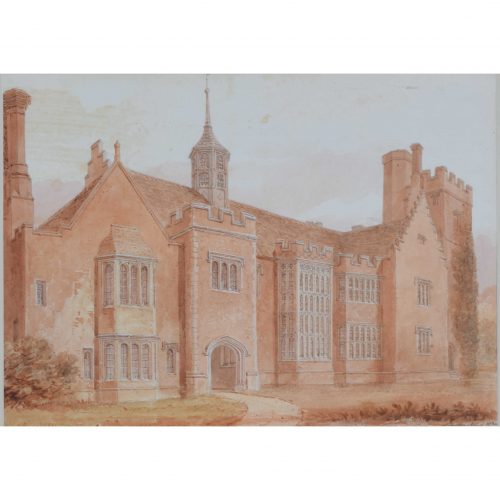
John Chessell Buckler (1793 - 1894)
Horham Hall, Essex (1830)
Watercolour 25 x 34 cm Signed and dated lower right; titled below. Horham Hall was built in Thaxted, Essex by Sir John Cutte in the early sixteenth century. The original hall was a timber-framed moated manor house built circa 1470, but it was largely demolished by Cutte, who built the present house between 1510 and 1515. Cutte was under-treasurer in the households of Henry VII and Henry VIII. The mansion was built in brick in two storeys in a quadrilateral layout with a gatehouse and incorporated some elements of the former building. The house was visited three times by Elizabeth I as the guest of Sir John Cutte. It is believed that the Tower was built for her to watch the local hunt. It was while staying at Horham in 1578 that the Queen received the envoy of the Duke of Alençon proposing marriage. John Chessell Buckler was a British architect, the eldest son of the architect John Buckler. His work included restorations of country houses and at the University of Oxford. Buckler received art lessons from the painter Francis Nicholson. He began working for his father's architectural practice in 1810, and ran it from 1830 onwards with his younger brother George. They worked in partnership until 1842. Buckler did a lot of work in Oxford, carrying out repairs and additions to St. Mary's Church, and Oriel, Brasenose, Magdalen, and Jesus Colleges. He also restored Oxburgh Hall, Norfolk, and Hengrave Hall, Suffolk, and designed Dunston Hall, Norfolk, and Butleigh Court in Somerset. In 1836 he came second, behind Charles Barry, in the competition to rebuild the Palace of Westminster following its destruction by fire. Buckler's writings included the text accompanying his father's engravings of Views of the Cathedral Churches of England and Wales (1822). In 1823 he published 'Observations on the Original Architecture of St. Mary Magdalen College, Oxford', in which he expressed his hostility towards changes in the quadrangle of Magdalen College. Some of his later writings, such as 'A History of the Architecture of the Abbey Church of St Alban' (1847), were written in collaboration with his own son, Charles Alban Buckler. He wrote a further polemical work, 'A Description And Defense Of The Restorations Of The Exterior Of Lincoln Cathedral' (1866), a scathing response to accusations that, in capacity as honorary architect to Lincoln Cathedral, he had overseen a damaging restoration involving the 'scraping' of the cathedral fabric. He died at the grand old age of 100 in 1894. Condition: good. Some spots to the sky, as visible in photograph. If you’d like to know more, please email info@manningfineart.co.uk or call us on 07929 749056. -
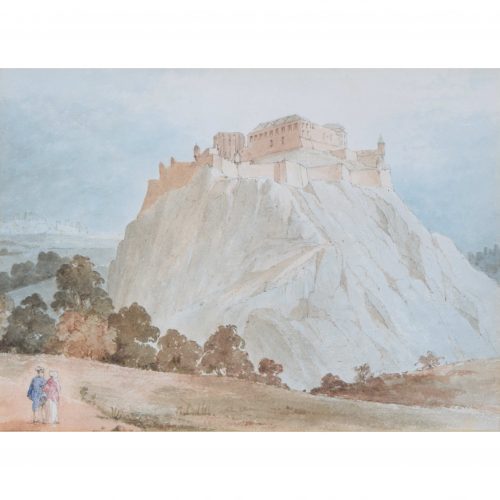
Richard Westmacott (1775 - 1856)
Edinburgh Castle (1800)
Watercolour 29 x 41 cm A watercolour depicting Edinburgh Castle. A Georgian couple gaze up at the immensity of Castle Rock, and the 11th-century fortress perched upon it. Richard Westmacott was British artist who primarily worked as a sculptor. Westmacott studied with his father, also named Richard Westmacott, at his studio in Mount Street, off Grosvenor Square in London, before going to Rome in 1793 to study under Antonio Canova. Upon his return to London in 1797, he established his own studio. He exhibited at the Royal Academy between 1797 and 1839 and was elected an associate of the Royal Academy in 1805, and a full academician in 1811. Condition: very good; handsomely framed. If you’d like to know more, please email info@manningfineart.co.uk or call us on 07929 749056. -
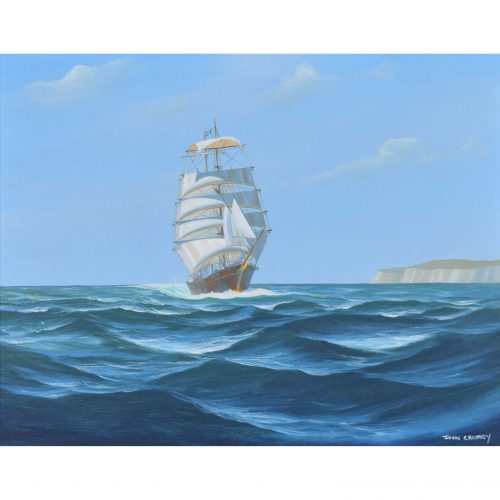
John Cromby (20th century)
Berean
Oil on board 38 x 49 cm Signed lower right. The Berean emerges from the horizon between a choppy sea and blue sky studded with clouds. The Berean was built by William Pile of Sunderland for Thomas B Walker of London in 1869, and was one of the fastest ships on the London-Tasmania run. The Berean was inward-bound from Langesund, Norway, with a cargo of ice, when she was struck by a foreign steamship and foundered on the 8th April 1910. In Cromby's painting, a grey-green headland emerges from the right of the picture. Cromby was a Liverpool-based artist, renowned for his paintings of Liverpool docks. Condition: excellent. If you’d like to know more, please email info@manningfineart.co.uk or call us on 07929 749056. -

J Black (early 19th century) after Frederick Mackenzie (1788 - 1854)
The Choir, Westminster Abbey (1812)
Hand-coloured aquatint 28 x 19 cm Published by Rudolph Ackermann (1764 - 1834). An engraving of the vast and soaring interior of Westminster Abbey. Mackenzie's drawing was engraved by Black and published by Ackermann in his 1812 "History of Westminster Abbey". The Abbey is an historic, mainly Gothic church in the City of Westminster, London, just to the west of the Palace of Westminster. It is one of the United Kingdom's most notable religious buildings and since Edward the Confessor, a burial site for English and, later, British monarchs. Since the coronation of William the Conqueror in 1066, all coronations of English and British monarchs have occurred in Westminster Abbey. Sixteen royal weddings have occurred at the abbey since 1100. According to a tradition first reported circa 1080, a church was founded at the site (then known as Thorney Island) in the seventh century, in the time of Mellitus, Bishop of London. Construction of the present church began in 1245 on the orders of Henry III. Frederick Mackenzie (1788 - 1854) was a British watercolourist and architectural draughtsman. He first exhibited at the Royal Academy in 1804, and contributed eleven drawings between that year and 1828. He contributed to the Society of Painters in Water Colours exhibitions from 1813, becoming an associate in 1822, and a full member the following year. From 30 November 1831 till his death he was treasurer to the society. In later life Mackenzie was no longer commissioned to illustrate books. Rudolph Ackermann was an Anglo-German bookseller, inventor, lithographer, publisher and businessman. In 1795 he established a print-shop and drawing-school at 96 Strand. Here Ackermann set up a lithographic press and began a trade in prints. He later began to manufacture colours and thick carton paper for landscape and miniature painters. Within three years the premises had become too small and he moved to 101 Strand, in his own words "four doors nearer to Somerset House", the seat of the Royal Academy of Arts. Between 1797 and 1800 Ackermann rapidly developed his print and book publishing business, encompassing many different genres including topography, caricature, portraits, transparencies and decorative prints. Condition: good. Some age toning. If you’d like to know more, please email info@manningfineart.co.uk or call us on 07929 749056. -
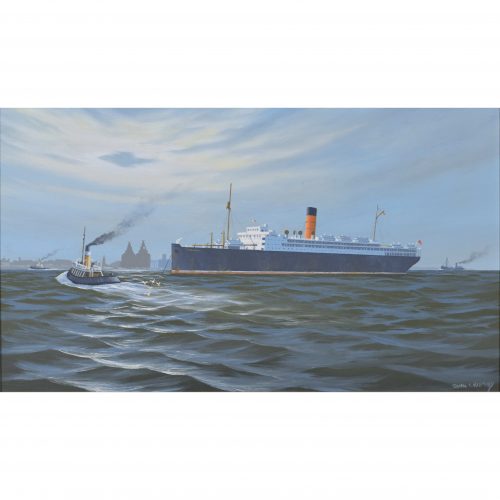
John Cromby (20th century)
A Passenger Ship in Liverpool Harbour
Oil on board 34 x 59 cm Signed lower right. A liner steers between a bright blue sky and a deep blue sea. Small steamships sail nearby, and seagulls wind their way among the various vessels. In the background, Liverpool's skyline is silhouetted. Cromby was a Liverpool-based artist, renowned for his paintings of Liverpool docks. Condition: excellent. If you’d like to know more, please email info@manningfineart.co.uk or call us on 07929 749056. -
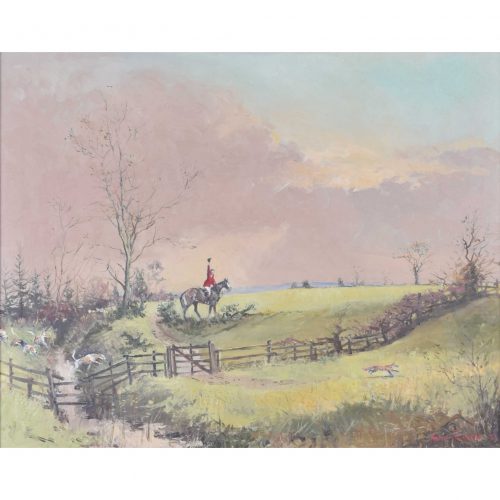
Robin Furness (born 1933)
The Three O'Clock Fox - Dobinson's Covert (1972)
Oil on canvas 40 x 50 cm Signed lower right. A delightful oil painting of the Raby Hunt at Bedburn by Robin Furness, former MFH of the Bedale Hunt and noted painter of hunting scenes. Condition: very good. If you’d like to know more, please email info@manningfineart.co.uk or call us on 07929 749056. -

John Appleyard (1908 - 1960)
The Middleton Hunt at Sherriff Hutton
Watercolour 28 x 37 cm Signed lower right. The Huntsman and hounds of North Yorkshire's Middleton Hunt. Condition: very good. If you’d like to know more, please email info@manningfineart.co.uk or call us on 07929 749056. -

Bernard Cecil Gotch (1876-1964)
Queen's College, Oxford
Watercolour 28 x 39 cm (51 x 64 cm framed) Signed lower right. Queen's College in all its leafy glory. The dreaming spires of the University Church of St Mary the Virgin, the Radcliffe Camera, and All Souls peep over the quad. Bernard Cecil Gotch was a Winchester-born artist who is best known for his atmospheric watercolours of Britain's towns and cities (most notably Oxford). He moved to Oxford in 1927, painting many watercolours of the interiors and exteriors of Oxford’s many buildings. His works concentrate on the grand exteriors and interiors of the University's colleges, and he exhibited frequently - including an exhibition every term at Oriel College. His first notable commission was for the publisher Methuen, illustrating 'A Shepherd’s Life' by W H Hudson. Whilst in London he was invited to illustrate a book on the Public Schools of England (which was sadly never completed). He exhibited watercolours at the Fine Art Society and Lincolns Inn, and also exhibited at the Royal Academy. In 1952 Gotch was given an Honorary MA by the University of Oxford, and, after his death in 1963, a memorial was held for him at Oriel. Condition: very good; original frame & mount (some ageing to the latter). If you’d like to know more, please email info@manningfineart.co.uk or call us on 07929 749056. Click here for other views of Queen's College, Oxford. -
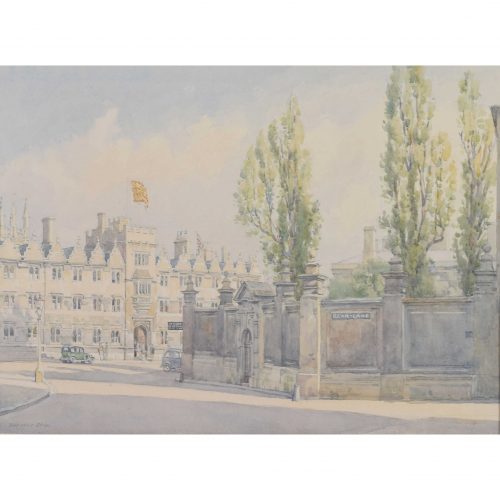
Bernard Cecil Gotch (1876-1964)
Oriel Square, Oxford, at the entrance to Bear Lane
Watercolour 27 x 36.5 cm Signed in pencil lower left. Oriel Square in the afternoon. Two undergraduates lean against the walls of Oriel College, talking, and another group make their way inside. Vintage cars (dating the picture to the 1920s, or 1930s?) are parked outside its gates, and the Oriel flag flies high. Bernard Cecil Gotch was a Winchester-born artist who is best known for his atmospheric watercolours of Britain's towns and cities (most notably Oxford). He moved to Oxford in 1927, painting many watercolours of the interiors and exteriors of Oxford’s many buildings. His works concentrate on the grand exteriors and interiors of the University's colleges, and he exhibited frequently - including an exhibition every term at Oriel College. His first notable commission was for the publisher Methuen, illustrating 'A Shepherd’s Life' by W H Hudson. Whilst in London he was invited to illustrate a book on the Public Schools of England (which was sadly never completed). He exhibited watercolours at the Fine Art Society and Lincolns Inn, and also exhibited at the Royal Academy. In 1952 Gotch was given an Honorary MA by the University of Oxford, and, after his death in 1963, a memorial was held for him at Oriel. Condition: very good. If you’d like to know more, please email info@manningfineart.co.uk or call us on 07929 749056. -
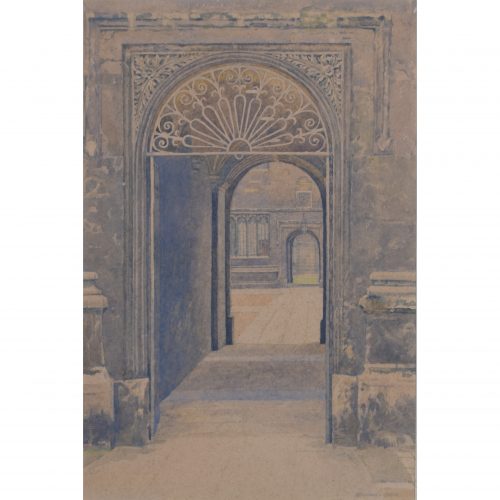
Bernard Cecil Gotch (1876-1964)
The Bodleian Library, Oxford: Passageway into the Old Schools Quandrangle
Watercolour 49 x 35 cm Signed in pencil lower right. An enticing view of the passageway leading into the Old Schools Quad of the Bodleian Library. Through the gateway, we see the passageway leading out of the Quad onto the other side, into Radcliffe Square. A glimpse of the Radcliffe Camera, surrounded by its green lawn, is visible through the two passages. Bernard Cecil Gotch was a Winchester-born artist who is best known for his atmospheric watercolours of Britain's towns and cities (most notably Oxford). He moved to Oxford in 1927, painting many watercolours of the interiors and exteriors of Oxford’s many buildings. His works concentrate on the grand exteriors and interiors of the University's colleges, and he exhibited frequently - including an exhibition every term at Oriel College. His first notable commission was for the publisher Methuen, illustrating 'A Shepherd’s Life' by W H Hudson. Whilst in London he was invited to illustrate a book on the Public Schools of England (which was sadly never completed). He exhibited watercolours at the Fine Art Society and Lincolns Inn, and also exhibited at the Royal Academy. In 1952 Gotch was given an Honorary MA by the University of Oxford, and, after his death in 1963, a memorial was held for him at Oriel. Condition: very good. Framed, with washline mount. If you’d like to know more, please email info@manningfineart.co.uk or call us on 07929 749056. -
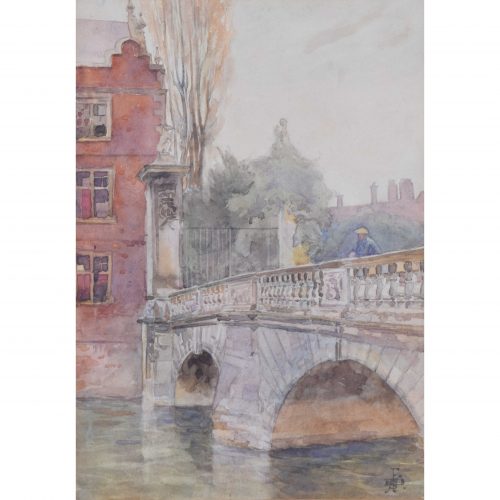
The Wren Bridge, St John's College, Cambridge
Engraving 35 x 24 cm Signed as a cypher lower right. A 1911 watercolour of St John's College's Wren Bridge, also known as the Kitchen Bridge. There had been a wooden bridge in this location since the early days of the medieval Hospital of St John the Evangelist. Christopher Wren had submitted designs to St John’s for a stone bridge in the 1690s, but building work did not commence until 1709. The Wren Bridge was completed in 1713. Its construction was overseen by Robert Grumbold, a local master stonemason and architect who was also responsible for building the Wren Library at Trinity College. The bridge reflects Wren's design, although in his original drawings he had suggested urns and pyramids, which were never added. In this view, a lone figure gazes down from the bridge into the muddy waters of the River Cam. Condition: very good. If you’d like to know more, please email info@manningfineart.co.uk or call us on 07929 749056. -

Gordon House (1932 - 2004)
Triangle E
Lithograph 86 x 45 cm Signed and titled in pencil below the plate. An excellent example of Gordon House's work: a modern design in several tones of blue. Gordon House was born in Pontardawe, South Wales in 1932 and studied at Luton and St. Albans Schools of Art. He began working for advertising agencies in the 1950s and became a full-time artist in 1961, exhibiting several solo shoes. He designed for several leading London galleries, the Ashmolean Museum in Oxford, and popular bands such as the Beatles and the Rolling Stones. Several dozen Gordon House prints are held by the Tate. Condition: very good. Mounted to board. If you’d like to know more, please email info@manningfineart.co.uk or call us on 07929 749056. -
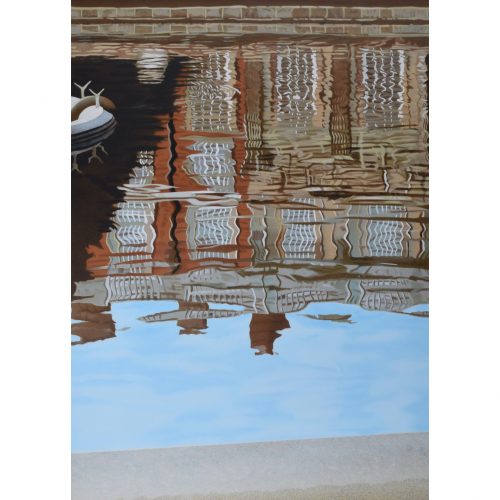
Brendan Neiland (b.1941) R.A. (Expelled)
Hampton Court (1984)
Screenprint 74 x 51 cm Signed, dated, titled, and numbered 152/250 in pencil. A print of one of Hampton Court's magnificent facades, reflected in its fountain. Reflected architecture is one of Neiland's most recurring themes. The Fountain Court was designed by Sir Christopher Wren; he began remodelled the palace in the baroque style for William III and Mary II in 1689. It held private and state apartments for both the King and Queen. Wren’s other works at Hampton Court Palace include the Lower Orangery and the grand colonnade in Clock Court, providing a grand entrance to the King's Apartments. The architectural historian Sir John Summerson described Fountain Court as 'Startling, as of simultaneous exposure to a great many eyes with raised eyebrows'. Brendan Neiland (born 23 October 1941 in Lichfield, Staffordshire) is an English artist best known for his paintings of reflections in modern city buildings. In 1992 he was elected to the Royal Academy (RA). Neiland is known for his interpretations of city life. His work is widely exhibited in major museums and galleries worldwide including, in Britain, the Victoria and Albert Museum, The Tate Gallery London, The Collections of the British Council and the Arts Council of Great Britain. He is represented by the Redfern Gallery and has had numerous shows internationally, including at the Galerie Belvedere in Singapore, who represent him in Singapore and the Far East. Condition: very good. If you’d like to know more, please email info@manningfineart.co.uk or call us on 07929 749056. -
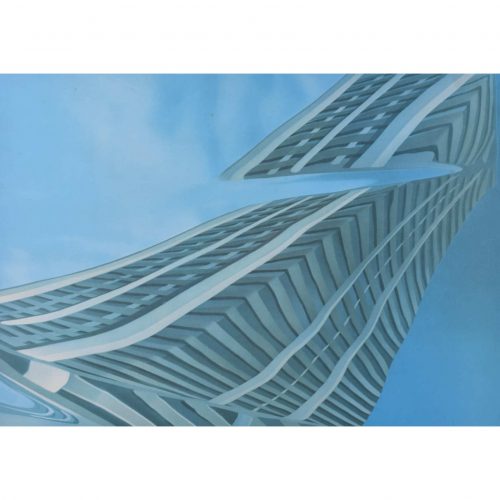
Brendan Neiland (b.1941) R.A. (Expelled)
Hyde Park Barracks, Knightsbridge (1979)
Screenprint 35 x 51 cm Signed, titled, dated and numbered 153/300 in pencil. A print of the facade of Hyde Park Barracks, reflected in still water and backed by a bright blue sky. Reflected architecture is one of Neiland's most recurring themes. The Hyde Park Barracks (often known as Knightsbridge Barracks) on the southern edge of Hyde Park. The barracks are 3⁄4 mile from Buckingham Palace, enabling the officers and soldiers of the Household Cavalry to be available to respond speedily to any emergency at the Palace, practice drills on the Horse Guards Parade, and conduct their ceremonial duties. Neiland is known for his interpretations of city life. His work is widely exhibited in major museums and galleries worldwide including, in Britain, the Victoria and Albert Museum, The Tate Gallery London, The Collections of the British Council and the Arts Council of Great Britain. He is represented by the Redfern Gallery and has had numerous shows internationally, including at the Galerie Belvedere in Singapore, who represent him in Singapore and the Far East. Condition: slight browning to sheet; small stain to top right corner. When mounted this will not be perceptible. If you’d like to know more, please email info@manningfineart.co.uk or call us on 07929 749056. -
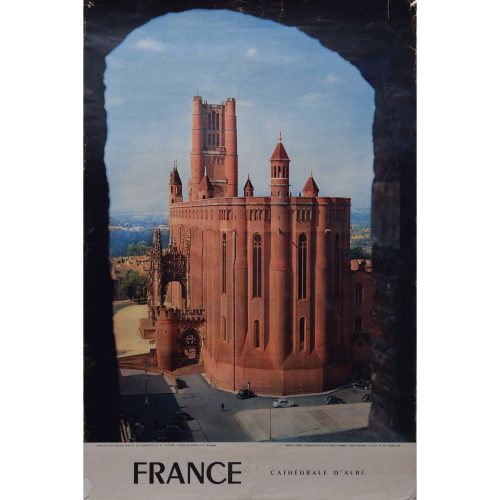
France - Cathedrale d'Albi, Toulouse
Original vintage poster 60 x 40 cm The Basilique Cathédrale Sainte-Cécile d'Albi (Cathedral Basilica of Saint Cecilia), also known as Albi Cathedral, is the seat of the Catholic Archbishop of Albi. First built in the aftermath of the Albigensian Crusade, the grim exterior resembles a fortress, but the interior is lavishly decorated with art and sculpture, a very ornate choir screen, and walls in bright blues and golds, in the Toulousian or Southern French Gothic. It was begun in 1282 and was under construction for 200 years. It is claimed to be the largest brick building in the world. In 2010 the cathedral, along with its episcopal buildings, was designated a UNESCO World Heritage Site because of its unique architecture and the remarkable consistency in its design. Condition: small tear to lower left corner; some wear to corners. If you’d like to know more, please email info@manningfineart.co.uk or call us on 07929 749056. -
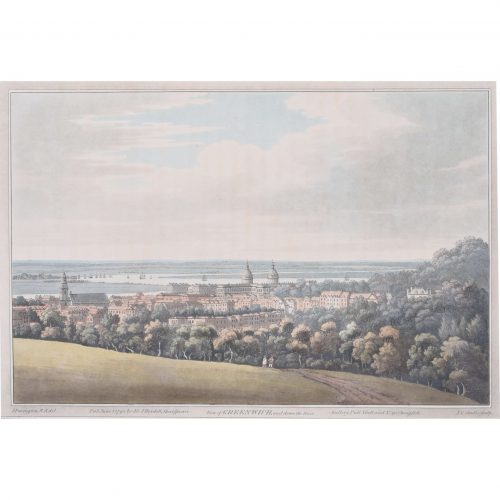
Joseph Constantine Stadler (1755 - 1828) after Joseph Farington (1747 - 1821)
View of Greenwich and Down the River (1795)
Hand-coloured engraving 23 x 33 cm Joseph Constantine Stadler was a prolific German émigré engraver of images after his contemporaries - here, 18th-century English landscape painter and diarist Joseph Farington. Stadler's engravings are wide-ranging in subject matter and include landscapes, seascapes and portraits, as well as military, sporting and decorative subjects. Stadler was employed by the leading print publisher of the time, John Boydell. Stadler lived in Knightsbridge when he died at the age of 73. Joseph Farington was born in Lancashire and went to study with Richard Wilson in London in 1763. In 1764, 1765, and 1766 he won "premiums" from the Society of Artists for his landscape drawing; he became a member in 1765. He joined the Royal Academy when it was founded in 1769 and was elected an ARA in 1783 and an RA in 1785. Farington contributed works to the Academy's exhibitions every year until 1801, but only occasionally between 1801 and 1813. He was an active member of the Academy and sat on several important committees, including the one which determined where artworks would be hung during the exhibitions. In 1793 he became a fellow of the Society of Antiquaries and helped establish the British Institution. Condition: very good. If you’d like to know more, please email info@manningfineart.co.uk or call us on 07929 749056. -
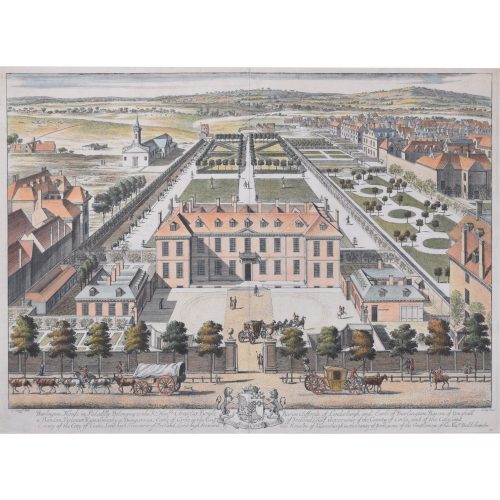
Johannes Kip (1652 - 1722) and Leonard Knyff (1650 - 1722)
Burlington House (1707)
Engraving with later hand-colouring 36 x 50 cm The linked careers of Jan Kip and Leonard Knyff made a specialty of engraved views of English country houses, represented in detail from the bird's-eye view, a pictorial convention for topography. Their major work was Britannia Illustrata: Or Views of Several of the Queens Palaces, as Also of the Principal seats of the Nobility and Gentry of Great Britain, Curiously Engraven on 80 Copper Plates, London (1707, published in the winter of 1708-9). The volume is among the most important English topographical publications of the 18th century. Architecture is rendered with care, and the settings of parterres and radiating avenues driven through woods or planted across fields, garden paths, gates and toolsheds are illustrated in detail. The images are staffed with figures and horses, coaches pulling into forecourts, water-craft on rivers, in line with the traditions of the Low Countries. The inscription in the plate reads: Burlington House in Pickadilly Belonging to the R.t Honble Charles Boyle Baron Clifforde of Londesburgh, and Earle of Burlington Baron of younghall & Bandon, Viscount Kynalmeaky & Dungarvan, Earle of Corke in the Kingdom of Ireland, Chief Governour of the County of Corke, and the Citty, and County of the Citty of Corke, Lord high Treasurer of Ireland, Lord high Steward of the Royalty of Knaresburgh in the County of Yorke, & one of the Gentlemen of his Majties Beddchamber. Condition: recent hand colouring, with wash-lined mount. If you’d like to know more, please email info@manningfineart.co.uk or call us on 07929 749056. -
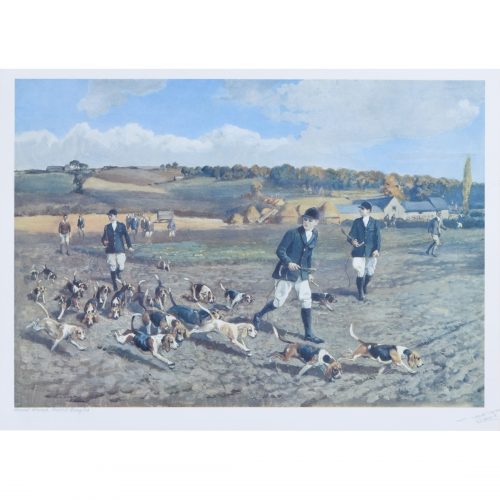
John Ivester Lloyd (1873 - 1942)
Christ Church Beagles
Lithograph 31 x 42 cm Thomas Ivester Lloyd (1873 - 1942) was born in Liverpool. During the First World War, he served with the Remount Service, in common with many other equine artists. He was later commissioned into the Royal Artillery. From childhood he hunted, and he became Master of the Sherington Foot Beagles. As well as his equine portraits, he illustrated some books. The pony books he illustrated were all written by his son, John Ivester-Lloyd. Condition: colours excellent. Original frame. If you’d like to know more, please email info@manningfineart.co.uk or call us on 07929 749056. Click here for other hunting pictures. -
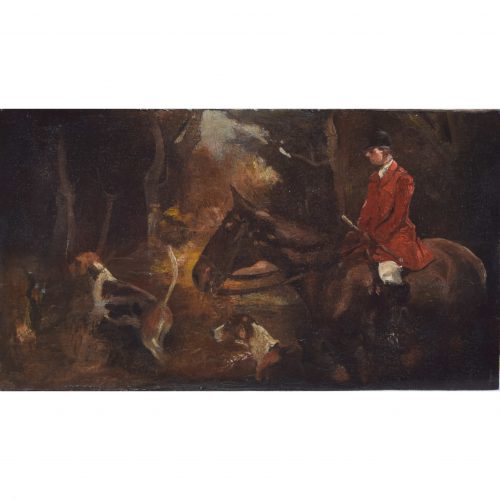
attr. John Ivester Lloyd (1873 - 1942)
Foxhunting
Oil on board 20 x 36 cm A huntsman and hounds pass through a dark wood. Thomas Ivester Lloyd (1873 - 1942) was born in Liverpool. During the First World War, he served with the Remount Service, in common with many other equine artists. He was later commissioned into the Royal Artillery. From childhood he hunted, and he became Master of the Sherington Foot Beagles. As well as his equine portraits, he illustrated some books. The pony books he illustrated were all written by his son, John Ivester-Lloyd. Condition: good; some craquelure. If you’d like to know more, please email info@manningfineart.co.uk or call us on 07929 749056. -
Out of stock
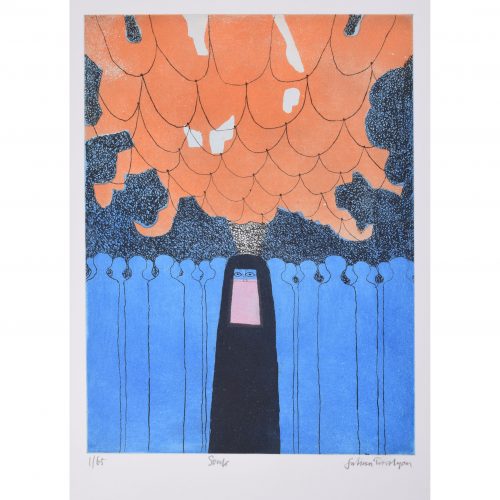
Julian Trevelyan (1910 - 1988)
Souk (1972)
Etching and aquatint 71 x 56 cm Signed, titled, and numbered 1/65 in pencil outside of the plate. The Tate Collection holds number 25/65. An Arab bazaar. Tall, nameless blue figures surround a veiled and staring woman. Nephew of the historian G M Trevelyan, Julian Trevelyan was educated at Bedales and then at Trinity College, Cambridge, where he read English. After moving to Paris, Trevelyan studied engraving at Stanley William Hayter’s school, working alongside artists such as Max Ernst, Joan Miro and Pablo Picasso. He married the potter Ursula Darwin in 1934, and in 1935 they moved to Hammersmith, buying Durham Wharf beside the River Thames which was Trevelyan’s studio – and home – for the rest of his life. His wartime service was – like so many artists – as a camoufleur. A Royal Engineer from 1940-43, he served in North Africa and Palestine, forcing the German Afrika Korps to use resources against a dummy army whilst real tanks were disguised as more harmless equipment. In the desert, nothing could be hidden - but it could be disguised. Following the dissolution of his marriage in 1950, he married the painter Mary Fedden. Teaching at Chelsea School of Art, Trevelyan eventually became head of the Etching Department and his pupils included David Hockney and Peter Ackroyd. Condition: mounted to board, small scuff to very bottom of margin, otherwise very good. If you’d like to know more, please email info@manningfineart.co.uk or call us on 07929 749056. -
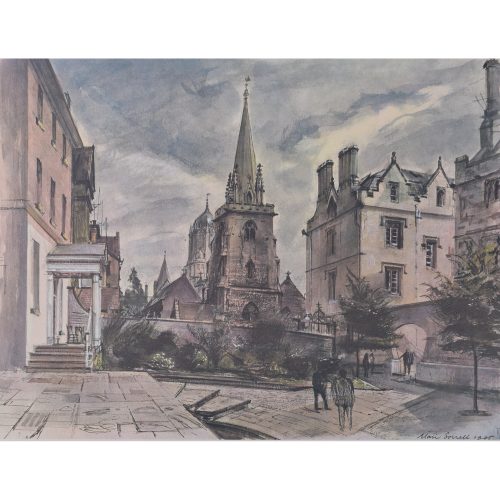
Alan Sorrell (1904 - 1974)
Pembroke College, View from the North Quadrangle (1966)
Lithograph 36 x 50 cm A lithograph of Pembroke's North Quad, from a drawing by Alan Sorrell. The artist's striking use of perspective and nebulously sketched figures make it a good example of Sorrell's style. Sorrell's 1965 etching was reproduced as a lithograph a year later, to be published in the "Oxford Almanack". The Oxford Almanack was an annual almanac published by the Oxford University Press for the University of Oxford from 1674 through 2019 (when printing sadly ceased due to "dwindling interest"). The almanac traditionally included engravings or lithographs of the University and information about the upcoming year. Other almanac artists have included James Basire, Michael Burghers, J. M. W. Turner, and John Piper. Alan Ernest Sorrell was an English artist and writer best remembered for his archaeological illustrations, particularly his detailed reconstructions of Roman Britain. Sorrell trained at the Southend municipal school of art and, after a brief spell as a commercial artist in London, he attended the Royal College of Art between 1924 and 1927. He was a Senior Assistant Instructor of Drawing there between 1931 and 1939, and again between 1946 and 1948. In 1937 he had been elected a member of the Royal Watercolour Society, and during the war served as a camofleur. After the war, Sorrell's archaeological and architectural work became their focus. Condition: very good. If you’d like to know more, please email info@manningfineart.co.uk or call us on 07929 749056. -
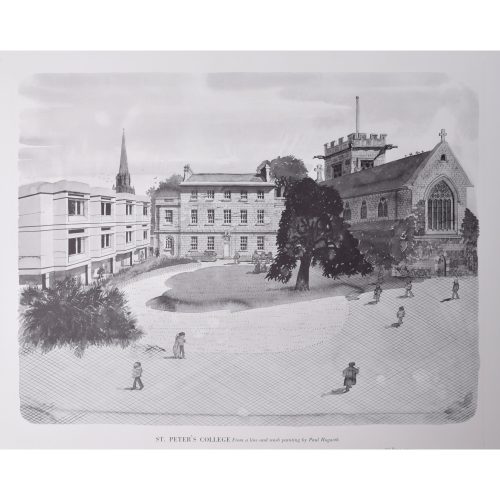
Paul Hogarth
St Peter's College, Oxford (1982)
Lithograph 33 x 46 cm A lithograph of St Peter's, from a line and wash painting by Paul Hogarth. Hogarth's view shows Linton Quad, with the chapel on the right; the chapel was built in 1874 and incorporated some of the stone of an earlier church on the site. Dons and undergraduates pace across the quad, and birds fly over the Latter Building and past the city's dreaming spires. Hogarth's line and wash painting was reproduced as a lithograph in 1982, to be published in the "Oxford Almanack". The Oxford Almanack was an annual almanac published by the Oxford University Press for the University of Oxford from 1674 through 2019 (when printing sadly ceased due to "dwindling interest"). The almanac traditionally included engravings or lithographs of the University and information about the upcoming year. Other almanac artists have included James Basire, Michael Burghers, J. M. W. Turner, and John Piper. Condition: very good. If you’d like to know more, please email info@manningfineart.co.uk or call us on 07929 749056. -
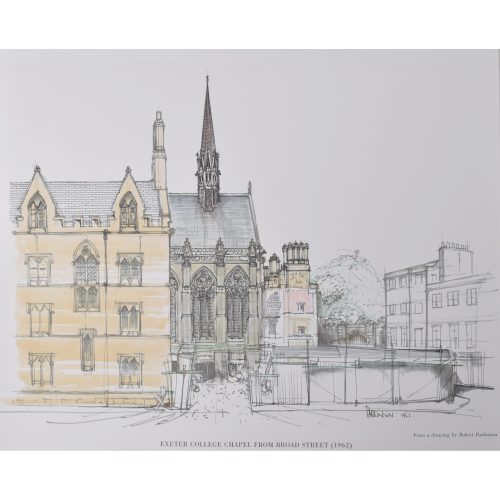
Robert Parkinson
Exeter College Chapel from Broad Street (1964)
Lithograph 33 x 46 cm A lithograph of Exeter's chapel, viewed from Broad Street, from a drawing by Robert Parkinson. Parkinson's depiction of the chapel centres around its architecture; markedly inspired by the Sainte-Chapelle in Paris and designed by Sir George Gilbert Scott, the chapel was built between 1856 and 1860. Here, Parkinson has its spire reach upward into a blank sky. Parkinson's 1962 etching was reproduced as a lithograph in 1964, to be published in the "Oxford Almanack". The Oxford Almanack was an annual almanac published by the Oxford University Press for the University of Oxford from 1674 through 2019 (when printing sadly ceased due to "dwindling interest"). The almanac traditionally included engravings or lithographs of the University and information about the upcoming year. Other almanac artists have included James Basire, Michael Burghers, J. M. W. Turner, and John Piper. Condition: very good, save for crease to top left corner (tear to margin which will be hidden under the mount). If you’d like to know more, please email info@manningfineart.co.uk or call us on 07929 749056. -
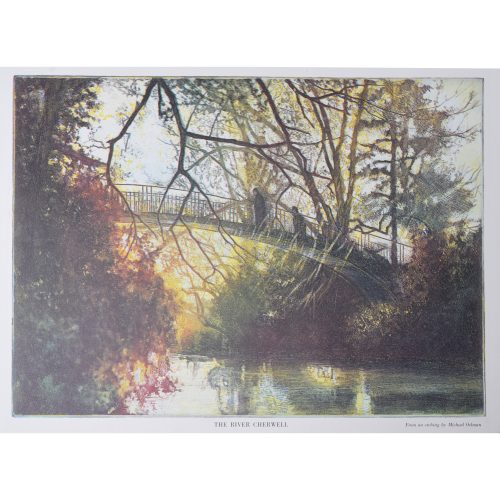
Michael Oelman (born 1941)
The River Cherwell
Lithograph 33 x 46 cm A lithograph of Oxford's wondrous River Cherwell in University Parks, from an etching by Michael Oelman. A setting sun casts its gold light over the glassy surface of the river and its surrounding trees; two figures cross the Cherwell via the famous Rainbow Bridge. The curved footbridge was built in the early 1920s by the University a project for the unemployed. Oelman's etching was reproduced as a lithograph in 1981, to be published in the "Oxford Almanack". The Oxford Almanack was an annual almanac published by the Oxford University Press for the University of Oxford from 1674 through 2019 (when printing sadly ceased due to "dwindling interest"). The almanac traditionally included engravings or lithographs of the University and information about the upcoming year. Other almanac artists have included James Basire, Michael Burghers, J. M. W. Turner, and John Piper. Michael Oelman was born in Llandudno, Wales, in 1941. He studied fine art at Reading University and then etching and lithography at the Central and Slade Schools of Art. In the 1960s he studied with S. W. Hayter in Paris, and then became a lecturer in Printmaking at Doncaster College of Art, Yorkshire. His studio is in Suffolk. Condition: very good. If you’d like to know more, please email info@manningfineart.co.uk or call us on 07929 749056. -
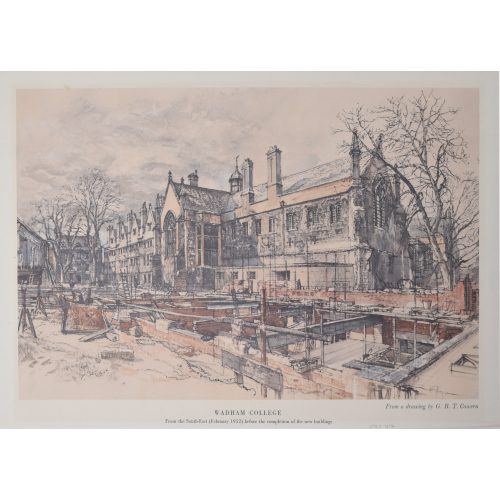
G R T (Raymond Teane) Cowern (1913 - 1986)
Wadham College, Oxford from the South East before the completion of the new buildings (1952)
Lithograph 33 x 46 cm A 1953 lithograph of Wadham during the construction of the college's mid-century buildings. Cowern made his drawing of the quad in 1952 and it was reproduced a year later as a lithograph to be published in the "Oxford Almanack". The Oxford Almanack was an annual almanac published by the Oxford University Press for the University of Oxford from 1674 through 2019 (when printing sadly ceased due to "dwindling interest"). The almanac traditionally included engravings or lithographs of the University and information about the upcoming year. Other almanac artists have included James Basire, Michael Burghers, J. M. W. Turner, and John Piper. G R T Cowern was a British painter, illustrator, and accomplished draughtsman. He was elected a full member of the Royal Academy in 1968. Cowern joined the British Army during the Second World War and served as an intelligence officer and then as a Field Security Officer. Throughout his Army service, Cowern made numerous drawings of his experiences during training and in the Netherlands and Belgium. Several of these works were purchased by the War Artists' Advisory Committee and are now held by the Imperial War Museum in London. Cowern also worked for the Recording Britain project, painting and etching images of historic buildings at risk of destruction in Suffolk, Worcestershire, and Herefordshire. A number of these drawings are now in the collection of the Victoria and Albert Museum. Condition: generally very good, a little discolouration to the paper, and a tear to the margin (which will be hidden under the mount). If you’d like to know more, please email info@manningfineart.co.uk or call us on 07929 749056. -
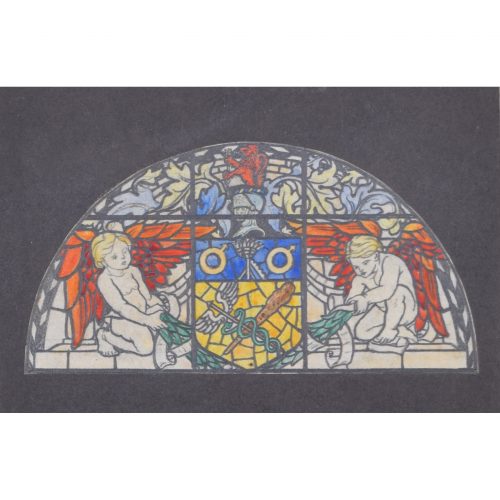
Thomas William Camm (1839 – 1912)
Stained glass window design for an arched panel
Watercolour 7 x 13 cm Design for TW Camm & Co., Smethwick, Birmingham. Numbered 13080. From the Camm studio sale. The Camms were stained glass designers who exhibited 48 times at the Royal Academy and also exhibited at The Walker Art Gallery in Liverpool, The Royal Scottish Academy, and the Royal Birmingham Society of Artists. Thomas William Camm's work was widely acclaimed, with his studio winning medals in Paris in 1878, in Sydney in 1879 and in Turin in 1911. In 1915, the American architect Ralph Adams Cram wrote that 'at the present moment a large number of artists in England are producing work of most singular beauty and perfection. Amongst these I have no hesitation in placing Mr. Camm easily as the first'. Following the death of her father, Florence Camm became the chief designer at TW Camm. Condition: very good; in oak frame. If you’d like to know more, please email info@manningfineart.co.uk or call us on 07929 749056. -
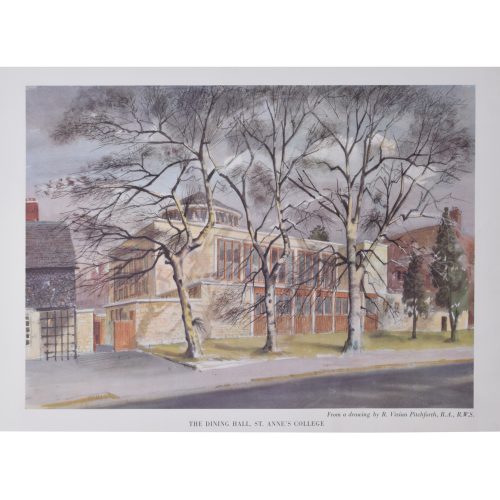
Roland Vivian Pitchforth RA ARWS (1895 - 1982)
The Dining Hall, St Anne's College
Lithograph 33 x 46 cm A lithograph of St Anne's, from a drawing by Roland Vivian Pitchforth. The artist captures the Dining Hall of the college on a blustery day. The modernist dining hall was built in 1959. Pitchforth's drawing was reproduced as a lithograph in 1962, to be published in the "Oxford Almanack". The Oxford Almanack was an annual almanac published by the Oxford University Press for the University of Oxford from 1674 through 2019 (when printing sadly ceased due to "dwindling interest"). The almanac traditionally included engravings or lithographs of the University and information about the upcoming year. Other almanac artists have included James Basire, Michael Burghers, J. M. W. Turner, and John Piper. Roland Vivian Pitchforth was an English painter, teacher and an official British war artist during the Second World War. Condition: very good. If you’d like to know more, please email info@manningfineart.co.uk or call us on 07929 749056. -
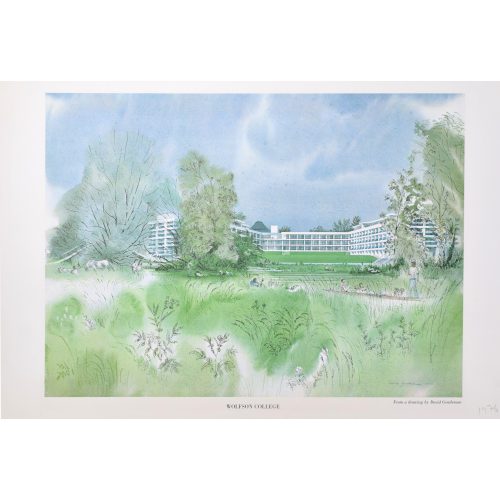
David Gentleman (born 1930)
Wolfson College, Oxford (1976)
Lithograph 33 x 46 cm A view of Wolfson College by David Gentleman. The modernist college emerges from between lush greenery and a bright blue sky. Gentleman produced this view in 1975, and it was published a year later in the "Oxford Almanack". The Oxford Almanack was an annual almanac published by the Oxford University Press for the University of Oxford from 1674 through 2019 (when printing sadly ceased due to "dwindling interest"). The almanac traditionally included engravings or lithographs of the University and information about the upcoming year. Other almanac artists have included James Basire, Michael Burghers, J. M. W. Turner, and John Piper. David Gentleman is an English artist. He studied art and painting at the Royal College of Art under Edward Bawden and John Nash, and produced several views of Oxford colleges for the Oxford Almanac. Condition: very good. If you’d like to know more, please email info@manningfineart.co.uk or call us on 07929 749056. -
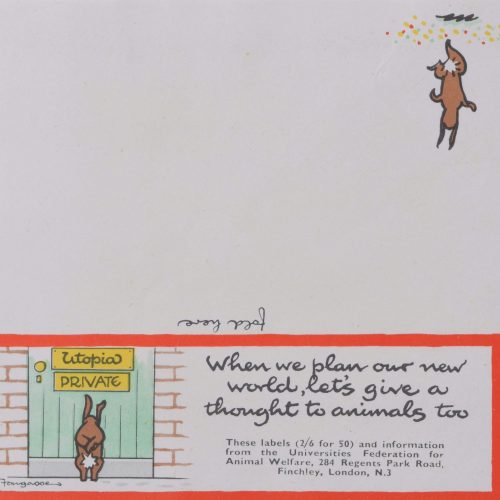
Fougasse (Cyril Kenneth Bird, 1887 - 1965)
'When we plan our new world, let's give a thought to animals too'
Lithograph 11 x 11 cm Cyril Kenneth Bird, under the name Fougasse, was a British cartoonist. He was art editor of Punch 1937 - 1949, and subsequently editor until 1953. He is best known for his ‘Careless Talk Costs Lives’ series of posters, and produced many other posters for the Ministry of Information and London Underground. His pen and ink cartoons for Punch are some of his gentlest and funniest works. What is less widely known about Fougasse is that he was a keen animal welfare activist. He became the chairman of the Universities' Federation for Animal Welfare after the war, and illustrated many of the Federation's campaigns. This label is one such illustration, and encourages the post-war re-evaluation of society to take into account the welfare of animals as well as that of humans. Condition: good. Small soft crease to top right corner. If you’d like to know more, please email info@manningfineart.co.uk or call us on 07929 749056. -
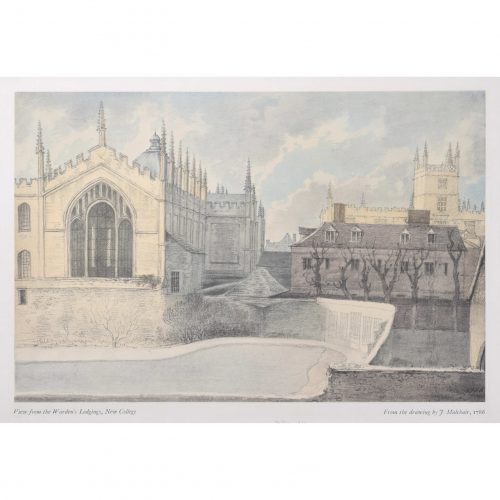
John Baptist Malchair (1730 – 1812)
View from the Master's Lodgings, New College, Oxford (1929)
Lithograph 33 x 46 cm A 1929 lithograph from a 1767 watercolour of New College by John Malchair. The artist's composition highlights the pale stone of New College on a winter's day. The chapel's spires stretch upward into a cold, cloud-filled sky, as do the bare branches of the trees. Malchair's watercolour (which is held by the Ashmolean museum) was reproduced as a lithograph in 1929, to be published in the "Oxford Almanack". The Oxford Almanack was an annual almanac published by the Oxford University Press for the University of Oxford from 1674 through 2019 (when printing sadly ceased due to "dwindling interest"). The almanac traditionally included engravings or lithographs of the University and information about the upcoming year. Other almanac artists have included James Basire, Michael Burghers, J. M. W. Turner, and John Piper. Malchair was a German-born watercolourist, violinist, drawing master, and collector of traditional European music. He is described as “one of the most distinctive figures of eighteenth century Oxford”, and is recognised as having been an influence on later landscape artists, including John Constable. Malchair was a talented artist, producing hundreds of paintings of English landscapes. His legacy is the collection of hundreds of sketches and watercolours of historical, architectural and topographical interest, particularly of Oxford's medieval buildings. Condition: very good. If you’d like to know more, please email info@manningfineart.co.uk or call us on 07929 749056. -
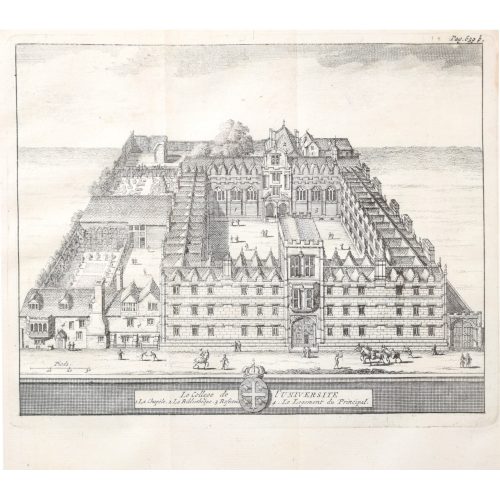
Pieter van der Aa (1659-1733), after David Loggan (1634–1692)
University College, Oxford (1727)
Engraving 12 x 16 cm An eighteenth-century view of University College, Oxford, engraved by Pieter van der Aa after David Loggan, the noted engraver, draughtsman, and painter. Pieter van der Aa of Leiden was a Dutch publisher best known for preparing maps and atlases, though he also printed editions of foreign bestsellers and illustrated volumes. He is noted for the many engravings he produced after David Loggan's series of Oxford and Cambridge colleges and costumes. In 1727 Van Der Aa illustrated "Les Delices de la Grande Bretagne & de L'Irelande" by James Beeverell, the book in which this engraving appears. Condition: a good impression. If you’d like to know more, please email info@manningfineart.co.uk or call us on 07929 749056. -
Out of stock
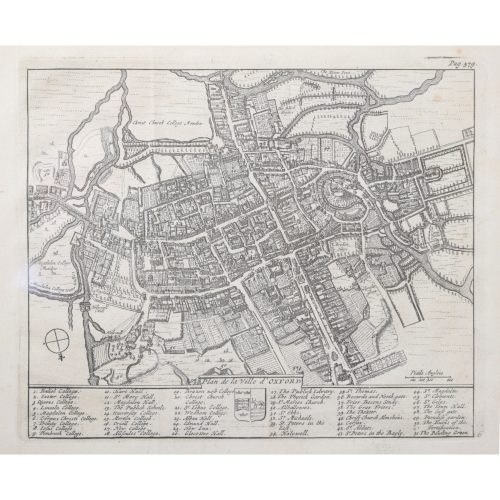
Pieter van der Aa (1659-1733), after David Loggan (1634–1692)
Map of Oxford (1727)
Engraving 12 x 16 cm An eighteenth-century map of Oxford, engraved by Pieter van der Aa after David Loggan, the noted engraver, draughtsman, and painter. The aerial view shows the city and its university buildings in all their glory. Pieter van der Aa of Leiden was a Dutch publisher best known for preparing maps and atlases, though he also printed editions of foreign bestsellers and illustrated volumes. He is noted for the many engravings he produced after David Loggan's series of Oxford and Cambridge colleges and costumes. In 1727 Van Der Aa illustrated "Les Delices de la Grande Bretagne & de L'Irelande" by James Beeverell, the book in which this engraving appears. Condition: a good impression. If you’d like to know more, please email info@manningfineart.co.uk or call us on 07929 749056. -

Pieter van der Aa (1659-1733), after David Loggan (1634–1692)
Oxford from the East (1727)
Engraving 12 x 16 cm An eighteenth-century view of Oxford from the east, engraved by Pieter van der Aa after David Loggan, the noted engraver, draughtsman, and painter. The skies are wide and full of the University's dreaming spires. Pieter van der Aa of Leiden was a Dutch publisher best known for preparing maps and atlases, though he also printed editions of foreign bestsellers and illustrated volumes. He is noted for the many engravings he produced after David Loggan's series of Oxford and Cambridge colleges and costumes. In 1727 Van Der Aa illustrated "Les Delices de la Grande Bretagne & de L'Irelande" by James Beeverell, the book in which this engraving appears. Condition: a good impression. If you’d like to know more, please email info@manningfineart.co.uk or call us on 07929 749056. -
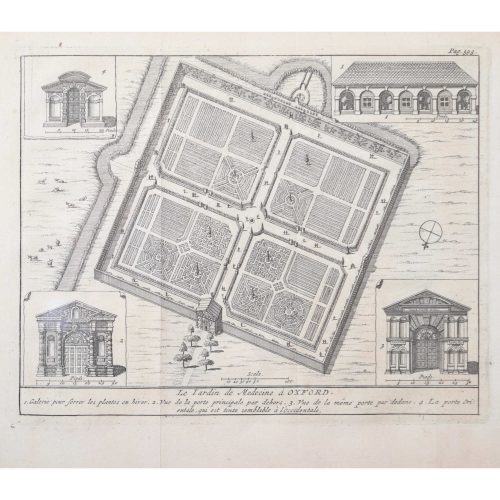
Pieter van der Aa (1659-1733), after David Loggan (1634–1692)
The University of Oxford Botanic Garden (1727)
Engraving 12 x 16 cm An eighteenth-century view of one of Oxford's dreamiest spaces: the Botanic Garden, engraved by Pieter van der Aa after David Loggan, the noted engraver, draughtsman, and painter. The University of Oxford Botanic Garden was founded in 1621 and is the oldest botanical garden in Great Britain. van der Aa's engraving focuses on its architectural qualities, with four features of the garden highlighted for their beauty, symmetry, and prowess of design. Of particular interest in this etching are the four trompe l'oeil pieces of gently curling paper which frame the gates of the garden. The Danby Gate (bottom left) at the front entrance to the garden is one of the three entrances designed by Nicholas Stone between 1632 and 1633. The gateway consists of three bays, each with a pediment; the niches contain statues of Charles I and Charles II in classical pose, and the niche in the the central pediment contains a bust of the Earl of Danby (hence the gate's name). Pieter van der Aa of Leiden was a Dutch publisher best known for preparing maps and atlases, though he also printed editions of foreign bestsellers and illustrated volumes. He is noted for the many engravings he produced after David Loggan's series of Oxford and Cambridge colleges and costumes. In 1727 Van Der Aa illustrated "Les Delices de la Grande Bretagne & de L'Irelande" by James Beeverell, the book in which this engraving appears. Condition: a good impression. If you’d like to know more, please email info@manningfineart.co.uk or call us on 07929 749056. -
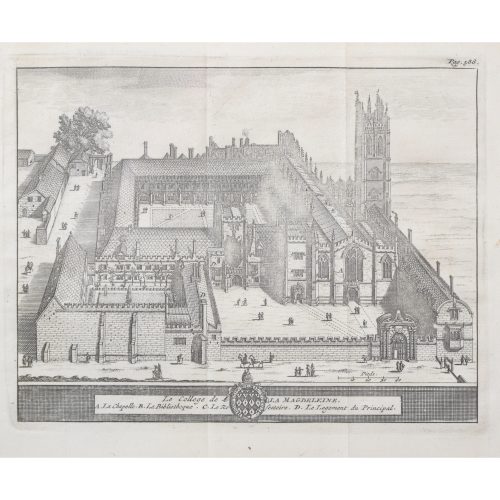
Pieter van der Aa (1659-1733), after David Loggan (1634–1692)
Magdalen College, Oxford (1727)
Engraving 12 x 16 cm A magnificent eighteenth-century view of Magdalen, engraved by Pieter van der Aa after David Loggan, the noted engraver, draughtsman, and painter. Magdalen was founded in 1458 by William of Waynflete, and is considered by many to be Oxford's most beautiful college. The college is organised around five quads; the irregularly shaped St John's Quad is the first on entering the college, and connects to the Great Quad (the Cloister) via the Perpendicular Gothic Founders Tower, which is richly decorated with carvings and pinnacles and has carved bosses in its vault. Chaplain's Quad runs along the side of the Chapel and Hall, to the foot of the Great Tower. St Swithun's Quad and Longwall Quad (which contains the Library) date from the late 19th and early 20th centuries, and make up the southwest corner of the college. Pieter van der Aa of Leiden was a Dutch publisher best known for preparing maps and atlases, though he also printed editions of foreign bestsellers and illustrated volumes. He is noted for the many engravings he produced after David Loggan's series of Oxford and Cambridge colleges and costumes. In 1727 Van Der Aa illustrated "Les Delices de la Grande Bretagne & de L'Irelande" by James Beeverell, the book in which this engraving appears. Condition: a small area slightly lacking in ink. If you’d like to know more, please email info@manningfineart.co.uk or call us on 07929 749056. -
Out of stock
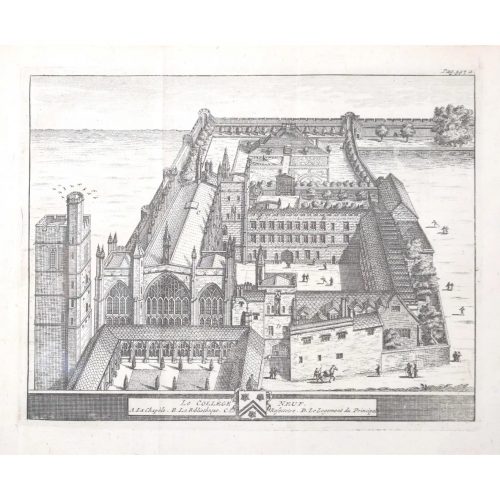
Pieter van der Aa (1659-1733), after David Loggan (1634–1692)
New College, Oxford (1727)
Engraving 12 x 16 cm An eighteenth-century view of Le College Neuf (New College), engraved by Pieter van der Aa after David Loggan, the noted engraver, draughtsman, and painter. Founded in 1379 by William of Wykeham, New College is one of the oldest colleges at the university and was the first to admit undergraduate students. Architecturally, New College was innovative in its design, in that it was all planned around an enclosed quadrangle (finished 1386). This was the first quadrangle of its type, though it has since become one of the defining features of colleges across Oxford and Cambridge. Pieter van der Aa of Leiden was a Dutch publisher best known for preparing maps and atlases, though he also printed editions of foreign bestsellers and illustrated volumes. He is noted for the many engravings he produced after David Loggan's series of Oxford and Cambridge colleges and costumes. In 1727 Van Der Aa illustrated "Les Delices de la Grande Bretagne & de L'Irelande" by James Beeverell, the book in which this engraving appears. Condition: a good impression. If you’d like to know more, please email info@manningfineart.co.uk or call us on 07929 749056. -
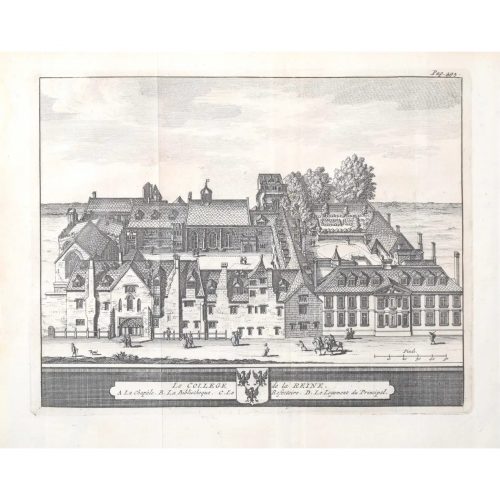
Pieter van der Aa (1659-1733), after David Loggan (1634–1692)
Queen's College, Oxford (1727)
Engraving 12 x 16 cm An eighteenth-century view of Le College de la Reine (Queen's College), engraved by Pieter van der Aa after David Loggan, the noted engraver, draughtsman, and painter. The college was founded in 1341 by Robert de Eglesfield in honour of Philippa of Hainault (the wife of King Edward III). Queen's is known for its predominantly neoclassical architecture, which includes buildings designed by Sir Christopher Wren and Nicholas Hawksmoor. Pieter van der Aa of Leiden was a Dutch publisher best known for preparing maps and atlases, though he also printed editions of foreign bestsellers and illustrated volumes. He is noted for the many engravings he produced after David Loggan's series of Oxford and Cambridge colleges and costumes. In 1727 Van Der Aa illustrated "Les Delices de la Grande Bretagne & de L'Irelande" by James Beeverell, the book in which this engraving appears. Condition: a good impression. If you’d like to know more, please email info@manningfineart.co.uk or call us on 07929 749056. -

Pieter van der Aa (1659-1733), after David Loggan (1634–1692)
All Souls College, Oxford (1727)
Engraving 12 x 16 cm An eighteenth-century view of Le College de Toutre les Ames (All Souls), engraved by Pieter van der Aa after David Loggan, the noted engraver, draughtsman, and painter. The college was founded by Henry VI of England and Henry Chichele (fellow of New College and Archbishop of Canterbury), in 1438, to commemorate the victims of the Hundred Years' War. Pieter van der Aa of Leiden was a Dutch publisher best known for preparing maps and atlases, though he also printed editions of foreign bestsellers and illustrated volumes. He is noted for the many engravings he produced after David Loggan's series of Oxford and Cambridge colleges and costumes. In 1727 Van Der Aa illustrated "Les Delices de la Grande Bretagne & de L'Irelande" by James Beeverell, the book in which this engraving appears. Condition: a good impression. If you’d like to know more, please email info@manningfineart.co.uk or call us on 07929 749056. -
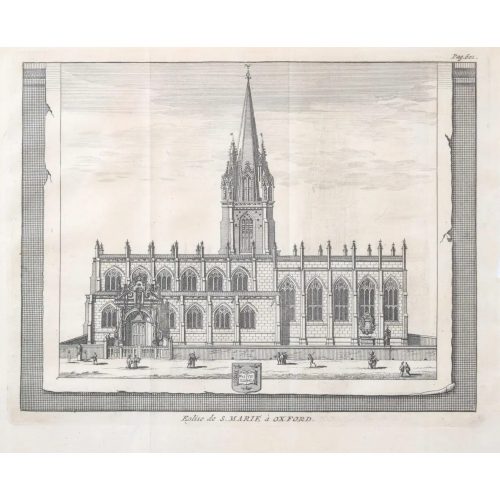
Pieter van der Aa (1659-1733), after David Loggan (1634–1692)
The University Church of St Mary the Virgin, University of Oxford (1727)
Engraving 12 x 16 cm An eighteenth-century view of the University Church, engraved by Pieter van der Aa after David Loggan, the noted engraver, draughtsman, and painter. St Mary's was the first building of the University of Oxford and its parish consists almost exclusively of university and college buildings. Its eccentric Baroque porch, designed by Nicholas Stone, faces the High Street, and it boasts a spire which is claimed by some church historians to be one of the most beautiful in England. Radcliffe Square lies to the north and to the east is Catte Street. The 13th-century tower is open to the public and provides magnificent views across the heart of the historic university city, especially Radcliffe Square, the Radcliffe Camera, Brasenose College, and All Souls College. Of particular interest here is the trompe l'oeil piece of gently torn paper which frames the view of the church. Pieter van der Aa of Leiden was a Dutch publisher best known for preparing maps and atlases, though he also printed editions of foreign bestsellers and illustrated volumes. He is noted for the many engravings he produced after David Loggan's series of Oxford and Cambridge colleges and costumes. In 1727 Van Der Aa illustrated "Les Delices de la Grande Bretagne & de L'Irelande" by James Beeverell, the book in which this engraving appears. Condition: a good impression. If you’d like to know more, please email info@manningfineart.co.uk or call us on 07929 749056. -
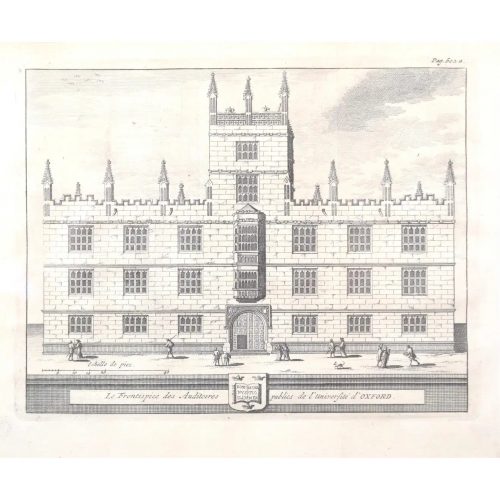
Pieter van der Aa (1659-1733), after David Loggan (1634–1692)
The Public Schools, University of Oxford (1727)
Engraving 12 x 16 cm An eighteenth-century view of the facade of Oxford's Public Schools, engraved by Pieter van der Aa after David Loggan, the noted engraver, draughtsman, and painter. Pieter van der Aa of Leiden was a Dutch publisher best known for preparing maps and atlases, though he also printed editions of foreign bestsellers and illustrated volumes. He is noted for the many engravings he produced after David Loggan's series of Oxford and Cambridge colleges and costumes. In 1727 Van Der Aa illustrated "Les Delices de la Grande Bretagne & de L'Irelande" by James Beeverell, the book in which this engraving appears. Condition: a good impression. If you’d like to know more, please email info@manningfineart.co.uk or call us on 07929 749056. -
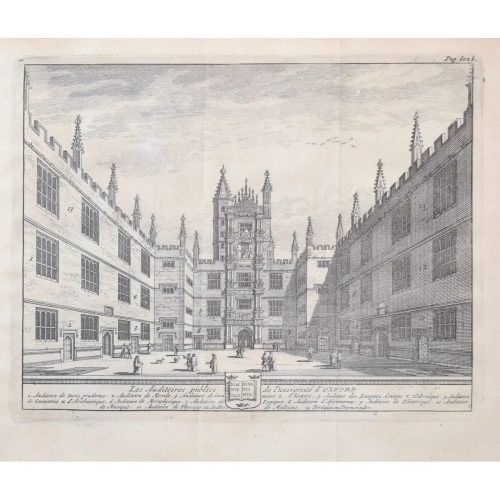
Pieter van der Aa (1659-1733), after David Loggan (1634–1692)
The Public Schools, University of Oxford (1727)
Engraving 12 x 16 cm An eighteenth-century view of the interior of the Public Schools, engraved by Pieter van der Aa after David Loggan, the noted engraver, draughtsman, and painter. Pieter van der Aa of Leiden was a Dutch publisher best known for preparing maps and atlases, though he also printed editions of foreign bestsellers and illustrated volumes. He is noted for the many engravings he produced after David Loggan's series of Oxford and Cambridge colleges and costumes. In 1727 Van Der Aa illustrated "Les Delices de la Grande Bretagne & de L'Irelande" by James Beeverell, the book in which this engraving appears. Condition: a good impression. If you’d like to know more, please email info@manningfineart.co.uk or call us on 07929 749056. -
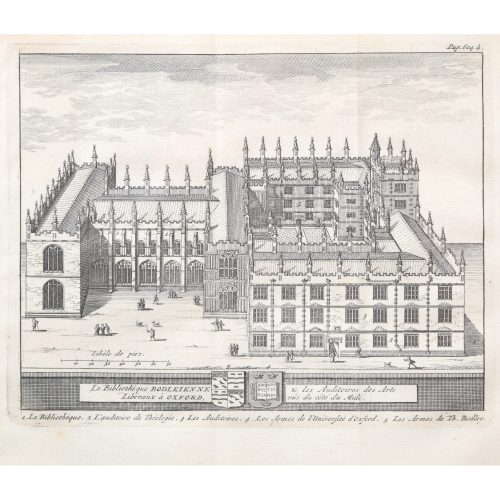
Pieter van der Aa (1659-1733), after David Loggan (1634–1692)
The Bodleian Library, Oxford (1727)
Engraving 12 x 16 cm An eighteenth-century view of the beautiful Bodleian Library, engraved by Pieter van der Aa after David Loggan, the noted engraver, draughtsman, and painter. Pieter van der Aa of Leiden was a Dutch publisher best known for preparing maps and atlases, though he also printed editions of foreign bestsellers and illustrated volumes. He is noted for the many engravings he produced after David Loggan's series of Oxford and Cambridge colleges and costumes. In 1727 Van Der Aa illustrated "Les Delices de la Grande Bretagne & de L'Irelande" by James Beeverell, the book in which this engraving appears. Condition: a good impression. If you’d like to know more, please email info@manningfineart.co.uk or call us on 07929 749056. -
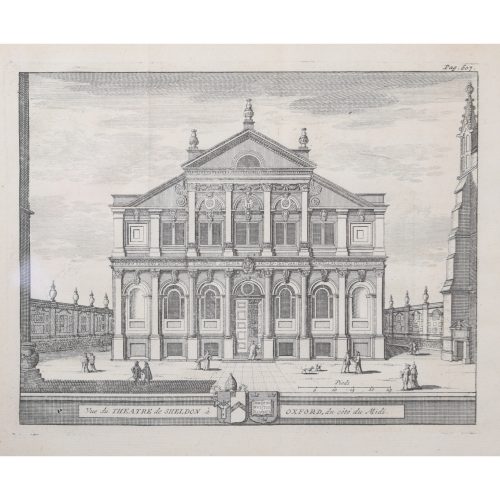
Pieter van der Aa (1659-1733), after David Loggan (1634–1692)
The Sheldonian Theatre, University of Oxford (1727)
Engraving 12 x 16 cm An eighteenth-century view of Oxford's marvellous Sheldonian Theatre, engraved by Pieter van der Aa after David Loggan, the noted engraver, draughtsman, and painter. Christopher Wren designed the building and it was constructed between 1664 and 1669; it takes its name from Gilbert Sheldon, chancellor of the University at the time and the Theatre's main financial backer. Pieter van der Aa of Leiden was a Dutch publisher best known for preparing maps and atlases, though he also printed editions of foreign bestsellers and illustrated volumes. He is noted for the many engravings he produced after David Loggan's series of Oxford and Cambridge colleges and costumes. In 1727 Van Der Aa illustrated "Les Delices de la Grande Bretagne & de L'Irelande" by James Beeverell, the book in which this engraving appears. Condition: a good impression. If you’d like to know more, please email info@manningfineart.co.uk or call us on 07929 749056. -
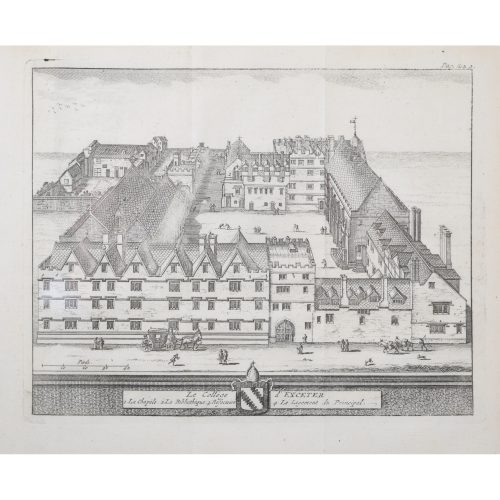
Pieter van der Aa (1659-1733), after David Loggan (1634–1692)
Exeter College, Oxford (1727)
Engraving 12 x 16 cm An eighteenth-century view of Exeter, engraved by Pieter van der Aa after David Loggan, the noted engraver, draughtsman, and painter. Pieter van der Aa of Leiden was a Dutch publisher best known for preparing maps and atlases, though he also printed editions of foreign bestsellers and illustrated volumes. He is noted for the many engravings he produced after David Loggan's series of Oxford and Cambridge colleges and costumes. In 1727 Van Der Aa illustrated "Les Delices de la Grande Bretagne & de L'Irelande" by James Beeverell, the book in which this engraving appears. Condition: a good impression. If you’d like to know more, please email info@manningfineart.co.uk or call us on 07929 749056. -
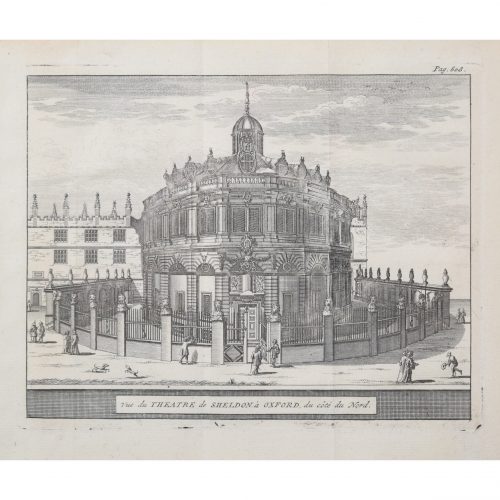
Pieter van der Aa (1659-1733), after David Loggan (1634–1692)
The Sheldonian Theatre, University of Oxford (1727)
Engraving 12 x 16 cm An eighteenth-century view of Oxford's marvellous Sheldonian Theatre, engraved by Pieter van der Aa after David Loggan, the noted engraver, draughtsman, and painter. Christopher Wren designed the building and it was constructed between 1664 and 1669; it takes its name from Gilbert Sheldon, chancellor of the University at the time and the Theatre's main financial backer. Pieter van der Aa of Leiden was a Dutch publisher best known for preparing maps and atlases, though he also printed editions of foreign bestsellers and illustrated volumes. He is noted for the many engravings he produced after David Loggan's series of Oxford and Cambridge colleges and costumes. In 1727 Van Der Aa illustrated "Les Delices de la Grande Bretagne & de L'Irelande" by James Beeverell, the book in which this engraving appears. Condition: a good impression. If you’d like to know more, please email info@manningfineart.co.uk or call us on 07929 749056. -
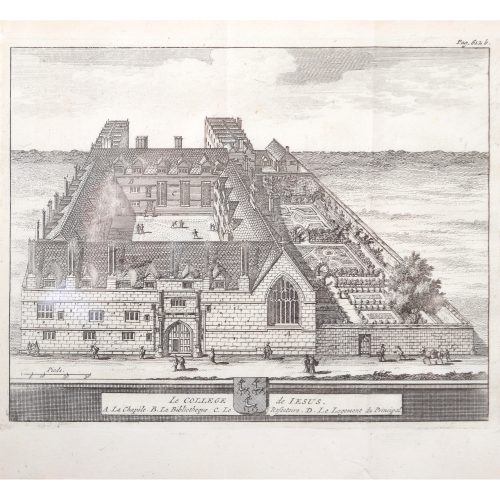
Pieter van der Aa (1659-1733), after David Loggan (1634–1692)
Jesus College, Oxford (1727)
Engraving 12 x 16 cm An eighteenth-century view of Jesus College, engraved by Pieter van der Aa after David Loggan, the noted engraver, draughtsman, and painter. Pieter van der Aa of Leiden was a Dutch publisher best known for preparing maps and atlases, though he also printed editions of foreign bestsellers and illustrated volumes. He is noted for the many engravings he produced after David Loggan's series of Oxford and Cambridge colleges and costumes. In 1727 Van Der Aa illustrated "Les Delices de la Grande Bretagne & de L'Irelande" by James Beeverell, the book in which this engraving appears. Condition: a good impression. If you’d like to know more, please email info@manningfineart.co.uk or call us on 07929 749056. -
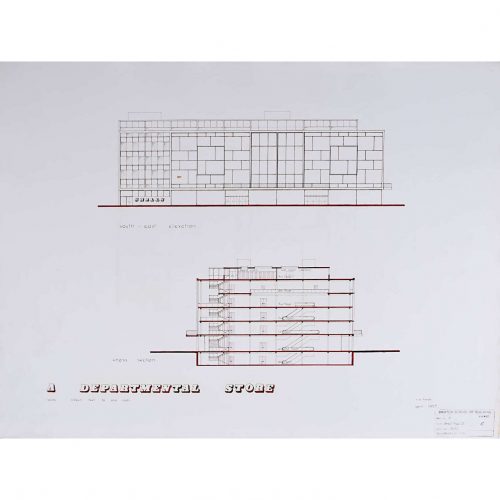
V A Hards (British, c. 1930-c. 2012) Design for a Departmental Store (1956)
Watercolour on wove 77 x 55 cm Signed and dated 1956. Hards was educated at Brixton School of Building and Woolwich Polytechnic between 1948 and 1956, during which period he produced some very competent work, including this architectural design for a modernist department store. Brixton School of Building was incorporated into the Polytechnic of the South Bank - now London South Bank University. Condition: some edge wear and isolated spots - see photographs. Stamped and marked with 'Brixton School of Building' stamp. If you’d like to know more, please email info@manningfineart.co.uk or call us on 07929 749056. -
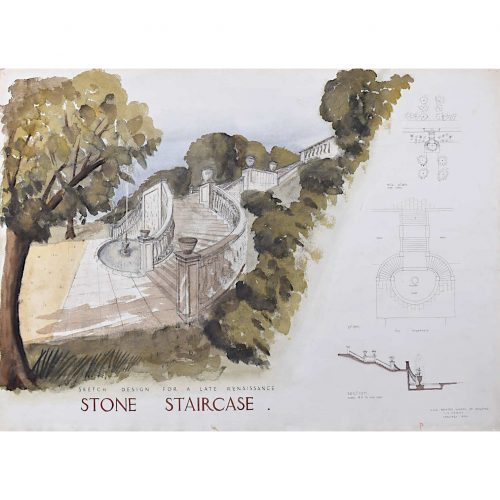
V A Hards (British, c. 1930-c. 2012) Design for a late Renaissance stone staircase (1956)
Watercolour on wove 77 x 55 cm Signed and dated 1956. Hards was educated at Brixton School of Building and Woolwich Polytechnic between 1948 and 1956, during which period he produced some very competent work, including this architectural design for a late Renaissance stone staircase. Brixton School of Building was incorporated into the Polytechnic of the South Bank - now London South Bank University. Condition: some edge wear and isolated spots - see photographs. Stamped and marked with 'Brixton School of Building' stamp. If you’d like to know more, please email info@manningfineart.co.uk or call us on 07929 749056. -
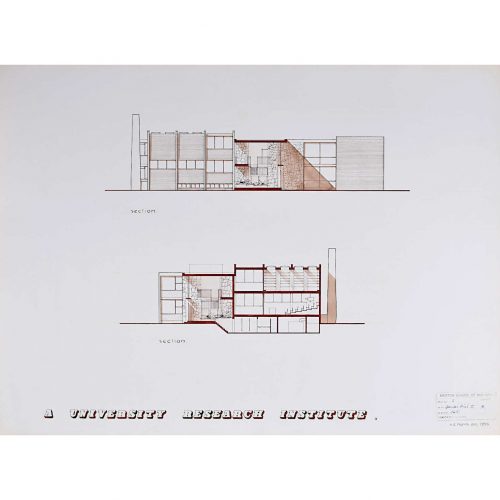
V A Hards (British, c. 1930-c. 2012) Design for Modernist Brutalist University Institute III (1956)
Watercolour on wove 77 x 55 cm Signed and dated 1956. Hards was educated at Brixton School of Building and Woolwich Polytechnic between 1948 and 1956, during which period he produced some very competent work, including this design for a university's brutalist building. Brixton School of Building was incorporated into the Polytechnic of the South Bank - now London South Bank University. Condition: some edge wear and isolated spots - see photographs. Stamped and marked with 'Brixton School of Building' stamp. If you’d like to know more, please email info@manningfineart.co.uk or call us on 07929 749056. -
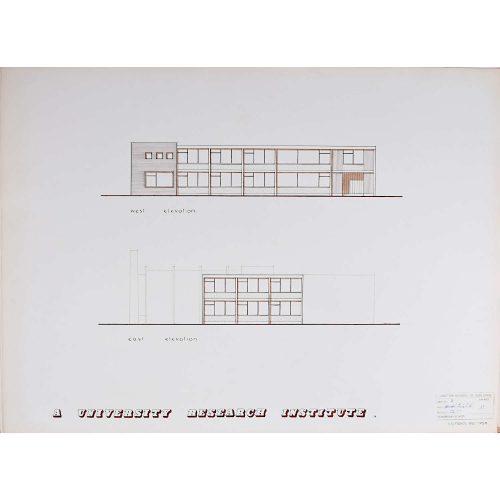
V A Hards (British, c. 1930-c. 2012) Design for Modernist Brutalist University Institute II (1956)
Watercolour on wove 77 x 55 cm Signed and dated 1956. Hards was educated at Brixton School of Building and Woolwich Polytechnic between 1948 and 1956, during which period he produced some very competent work, including this design for a university's brutalist building. Brixton School of Building was incorporated into the Polytechnic of the South Bank - now London South Bank University. Condition: some edge wear and isolated spots - see photographs. Stamped and marked with 'Brixton School of Building' stamp. If you’d like to know more, please email info@manningfineart.co.uk or call us on 07929 749056. -
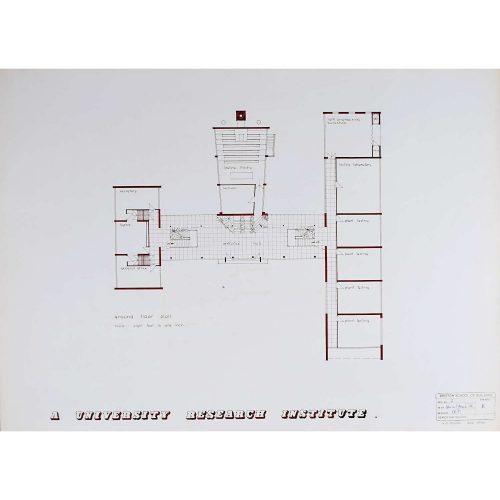
V A Hards (British, c. 1930-c. 2012) Design for Modernist Brutalist University Institute I (1956)
Watercolour on wove 77 x 55 cm Signed and dated 1956. Hards was educated at Brixton School of Building and Woolwich Polytechnic between 1948 and 1956, during which period he produced some very competent work, including this design for a university's brutalist building. Brixton School of Building was incorporated into the Polytechnic of the South Bank - now London South Bank University. Condition: some edge wear and isolated spots - see photographs. Stamped and marked with 'Brixton School of Building' stamp. If you’d like to know more, please email info@manningfineart.co.uk or call us on 07929 749056. -
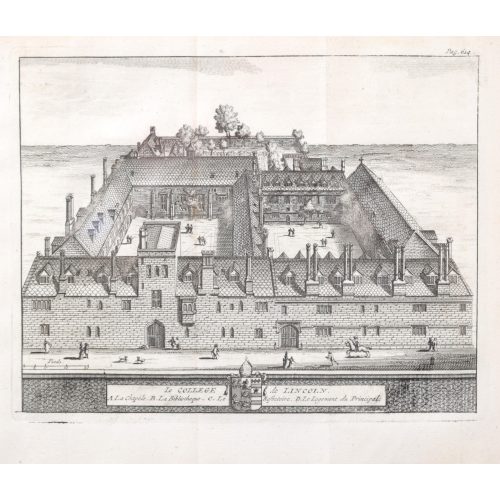
Pieter van der Aa (1659-1733), after David Loggan (1634–1692)
Lincoln College, Oxford (1727)
Engraving 12 x 16 cm An eighteenth-century view of Lincoln, engraved by Pieter van der Aa after David Loggan, the noted engraver, draughtsman, and painter. Pieter van der Aa of Leiden was a Dutch publisher best known for preparing maps and atlases, though he also printed editions of foreign bestsellers and illustrated volumes. He is noted for the many engravings he produced after David Loggan's series of Oxford and Cambridge colleges and costumes. In 1727 Van Der Aa illustrated "Les Delices de la Grande Bretagne & de L'Irelande" by James Beeverell, the book in which this engraving appears. Condition: a good impression. If you’d like to know more, please email info@manningfineart.co.uk or call us on 07929 749056. -

Pieter van der Aa (1659-1733), after David Loggan (1634–1692)
Brasenose College, Oxford (1727)
Engraving 12 x 16 cm An eighteenth-century view of 'Le Nez de Bronze', or Brasenose, engraved by Pieter van der Aa after David Loggan, the noted engraver, draughtsman, and painter. Pieter van der Aa of Leiden was a Dutch publisher best known for preparing maps and atlases, though he also printed editions of foreign bestsellers and illustrated volumes. He is noted for the many engravings he produced after David Loggan's series of Oxford and Cambridge colleges and costumes. In 1727 Van Der Aa illustrated "Les Delices de la Grande Bretagne & de L'Irelande" by James Beeverell, the book in which this engraving appears. Condition: a good impression. If you’d like to know more, please email info@manningfineart.co.uk or call us on 07929 749056. -
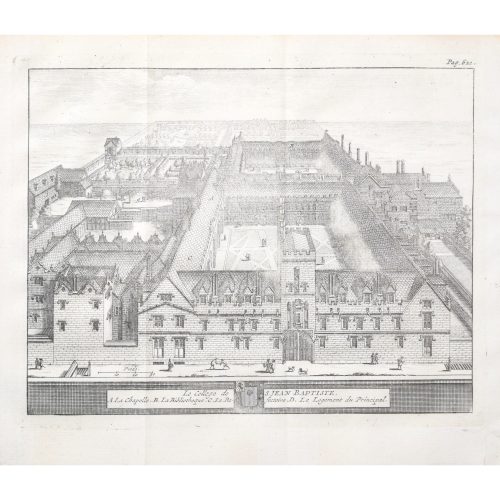
Pieter van der Aa (1659-1733), after David Loggan (1634–1692)
St John's College, Oxford (1727)
Engraving 12 x 16 cm An eighteenth-century view of St John's, engraved by Pieter van der Aa after David Loggan, the noted engraver, draughtsman, and painter. Pieter van der Aa of Leiden was a Dutch publisher best known for preparing maps and atlases, though he also printed editions of foreign bestsellers and illustrated volumes. He is noted for the many engravings he produced after David Loggan's series of Oxford and Cambridge colleges and costumes. In 1727 Van Der Aa illustrated "Les Delices de la Grande Bretagne & de L'Irelande" by James Beeverell, the book in which this engraving appears. Condition: a good impression. If you’d like to know more, please email info@manningfineart.co.uk or call us on 07929 749056. -
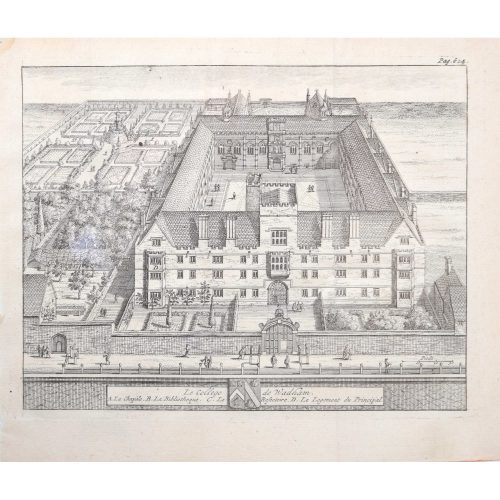
Pieter van der Aa (1659-1733), after David Loggan (1634–1692)
Wadham College, Oxford (1727)
Engraving 12 x 16 cm An eighteenth-century view of Wadham, engraved by Pieter van der Aa after David Loggan, the noted engraver, draughtsman, and painter. Pieter van der Aa of Leiden was a Dutch publisher best known for preparing maps and atlases, though he also printed editions of foreign bestsellers and illustrated volumes. He is noted for the many engravings he produced after David Loggan's series of Oxford and Cambridge colleges and costumes. In 1727 Van Der Aa illustrated "Les Delices de la Grande Bretagne & de L'Irelande" by James Beeverell, the book in which this engraving appears. Condition: a good impression. If you’d like to know more, please email info@manningfineart.co.uk or call us on 07929 749056. -
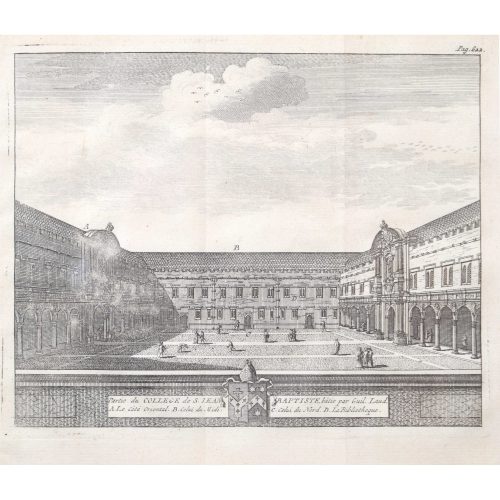
Pieter van der Aa (1659-1733), after David Loggan (1634–1692)
St John's College, Oxford (1727)
Engraving 12 x 16 cm An eighteenth-century view of Canterbury Quad, St John's, engraved by Pieter van der Aa after David Loggan, the noted engraver, draughtsman, and painter. Pieter van der Aa of Leiden was a Dutch publisher best known for preparing maps and atlases, though he also printed editions of foreign bestsellers and illustrated volumes. He is noted for the many engravings he produced after David Loggan's series of Oxford and Cambridge colleges and costumes. In 1727 Van Der Aa illustrated "Les Delices de la Grande Bretagne & de L'Irelande" by James Beeverell, the book in which this engraving appears. Condition: a good impression. If you’d like to know more, please email info@manningfineart.co.uk or call us on 07929 749056. -
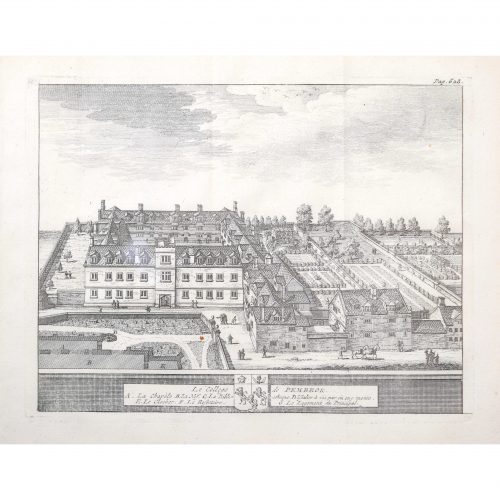
Pieter van der Aa (1659-1733), after David Loggan (1634–1692)
Pembroke College, Oxford (1727)
Engraving 12 x 16 cm An eighteenth-century view of Pembroke College, Oxford, engraved by Pieter van der Aa after an earlier one by David Loggan, the noted engraver, draughtsman, and painter. Pieter van der Aa of Leiden was a Dutch publisher best known for preparing maps and atlases, though he also printed editions of foreign bestsellers and illustrated volumes. He is noted for the many engravings he produced after David Loggan's series of Oxford and Cambridge colleges and costumes. In 1727 Van Der Aa illustrated "Les Delices de la Grande Bretagne & de L'Irelande" by James Beeverell, the book in which this engraving appears. Condition: a good impression. If you’d like to know more, please email info@manningfineart.co.uk or call us on 07929 749056. -
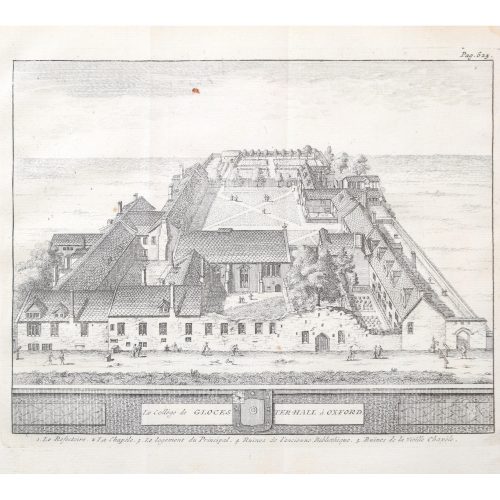
Pieter van der Aa (1659-1733), after David Loggan (1634–1692)
Gloucester College, Oxford (now Worcester College) (1727)
Engraving 12 x 16 cm An eighteenth-century view of Worcester College's predecessor, Gloucester College. Gloucester College was founded in 1283 by the Benedictine Abbey of St Peter at Gloucester as a place of study for 13 monks. The dissolution of the monasteries in the 1530s resulted in the closure of the College, which was eventually re-founded as Worcester College in 1714. Pieter van der Aa's engraving comes after an earlier one by David Loggan, the noted engraver, draughtsman, and painter, when the site was still known as Gloucester. Pieter van der Aa of Leiden was a Dutch publisher best known for preparing maps and atlases, though he also printed editions of foreign bestsellers and illustrated volumes. He is noted for the many engravings he produced after David Loggan's series of Oxford and Cambridge colleges and costumes. In 1727 Van Der Aa illustrated "Les Delices de la Grande Bretagne & de L'Irelande" by James Beeverell, the book in which this engraving appears. Condition: a good impression. If you’d like to know more, please email info@manningfineart.co.uk or call us on 07929 749056. -
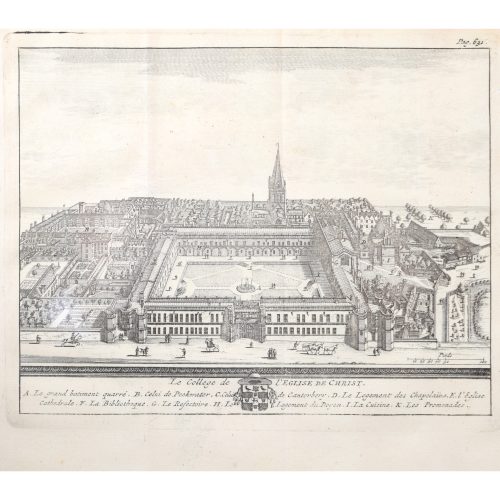
Pieter van der Aa (1659-1733), after David Loggan (1634–1692)
Christ Church, Oxford (1727)
Engraving 12 x 16 cm An eighteenth-century view of Christ Church, engraved by Pieter van der Aa after David Loggan, the noted engraver, draughtsman, and painter. Pieter van der Aa of Leiden was a Dutch publisher best known for preparing maps and atlases, though he also printed editions of foreign bestsellers and illustrated volumes. He is noted for the many engravings he produced after David Loggan's series of Oxford and Cambridge colleges and costumes. In 1727 Van Der Aa illustrated "Les Delices de la Grande Bretagne & de L'Irelande" by James Beeverell, the book in which this engraving appears. Condition: a good impression. If you’d like to know more, please email info@manningfineart.co.uk or call us on 07929 749056. -
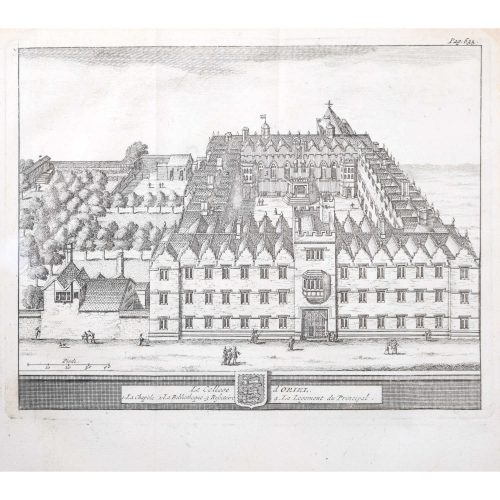
Pieter van der Aa (1659-1733), after David Loggan (1634–1692)
Oriel College, Oxford (1727)
Engraving 12 x 16 cm An eighteenth-century view of Oriel College, engraved by Pieter van der Aa after David Loggan, the noted engraver, draughtsman, and painter. Pieter van der Aa of Leiden was a Dutch publisher best known for preparing maps and atlases, though he also printed editions of foreign bestsellers and illustrated volumes. He is noted for the many engravings he produced after David Loggan's series of Oxford and Cambridge colleges and costumes. In 1727 Van Der Aa illustrated "Les Delices de la Grande Bretagne & de L'Irelande" by James Beeverell, the book in which this engraving appears. Condition: a good impression. If you’d like to know more, please email info@manningfineart.co.uk or call us on 07929 749056. -
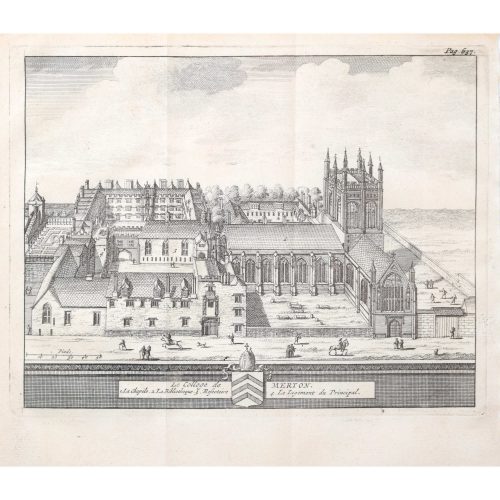
Pieter van der Aa (1659-1733), after David Loggan (1634–1692)
Merton College, Oxford (1727)
Engraving 12 x 16 cm An eighteenth-century view of Merton College, engraved by Pieter van der Aa after David Loggan, the noted engraver, draughtsman, and painter. Pieter van der Aa of Leiden was a Dutch publisher best known for preparing maps and atlases, though he also printed editions of foreign bestsellers and illustrated volumes. He is noted for the many engravings he produced after David Loggan's series of Oxford and Cambridge colleges and costumes. In 1727 Van Der Aa illustrated "Les Delices de la Grande Bretagne & de L'Irelande" by James Beeverell, the book in which this engraving appears. Condition: a good impression. If you’d like to know more, please email info@manningfineart.co.uk or call us on 07929 749056. -
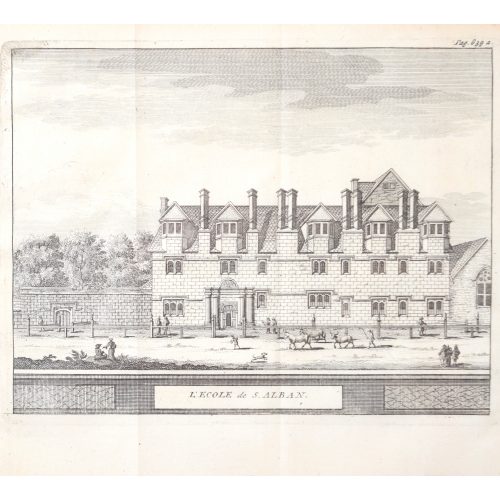
Pieter van der Aa (1659-1733), after David Loggan (1634–1692)
St Alban Hall, Oxford - now Merton College (1727)
Engraving 12 x 16 cm St Alban Hall, sometimes known as St Alban's Hall or Stubbins, was one of the medieval halls of the University of Oxford, and one of the longest-surviving. It was established in the 13th century and was acquired by neighbouring Merton College in the 16th century. The institutions formally merged in the late 19th century. The site in Merton Street, Oxford, is now occupied by Merton's Edwardian St Alban's Quad. Engraved by Pieter van der Aa after David Loggan, the noted engraver, draughtsman, and painter. Pieter van der Aa of Leiden was a Dutch publisher best known for preparing maps and atlases, though he also printed editions of foreign bestsellers and illustrated volumes. He is noted for the many engravings he produced after David Loggan's series of Oxford and Cambridge colleges and costumes. In 1727 Van Der Aa illustrated "Les Delices de la Grande Bretagne & de L'Irelande" by James Beeverell, the book in which this engraving appears. Condition: a good impression. If you’d like to know more, please email info@manningfineart.co.uk or call us on 07929 749056. -
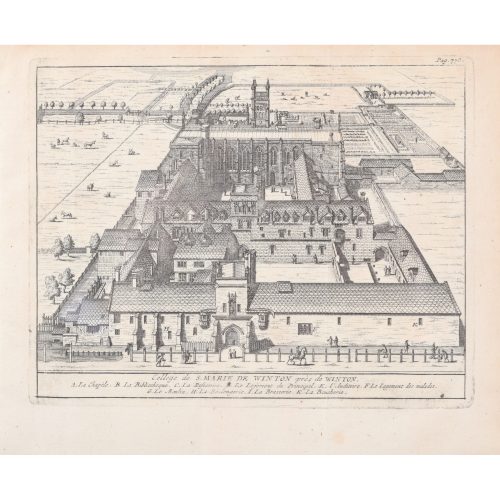
Pieter van der Aa (1659-1733), after David Loggan (1634–1692)
Winchester College, or "Le College de St Marie de Winton" (1727)
Engraving 12 x 16 cm An eighteenth-century view of Winchester College, engraved by Pieter van der Aa after David Loggan, the noted engraver, draughtsman, and painter. Pieter van der Aa of Leiden was a Dutch publisher best known for preparing maps and atlases, though he also printed editions of foreign bestsellers and illustrated volumes. He is noted for the many engravings he produced after David Loggan's series of Oxford and Cambridge colleges and costumes. In 1727 Van Der Aa illustrated "Les Delices de la Grande Bretagne & de L'Irelande" by James Beeverell, the book in which this engraving appears. Condition: a good impression. If you’d like to know more, please email info@manningfineart.co.uk or call us on 07929 749056. -
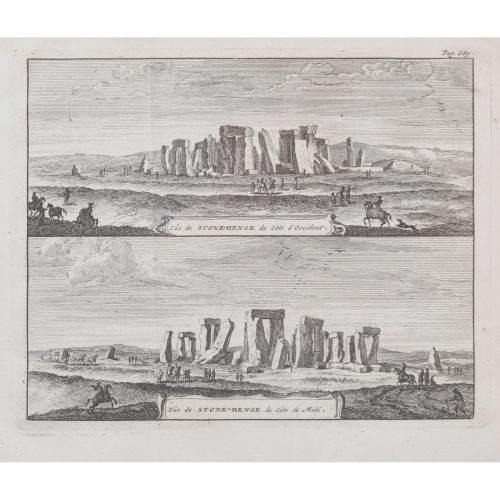
Pieter van der Aa (1659-1733), after David Loggan (1634–1692)
Stonehenge (1727)
Engraving 12 x 16 cm Two eighteenth-century views of the pagan and mystical Stonehenge, engraved by Pieter van der Aa after David Loggan, the noted engraver, draughtsman, and painter. Pieter van der Aa of Leiden was a Dutch publisher best known for preparing maps and atlases, though he also printed editions of foreign bestsellers and illustrated volumes. He is noted for the many engravings he produced after David Loggan's series of Oxford and Cambridge colleges and costumes. In 1727 Van Der Aa illustrated "Les Delices de la Grande Bretagne & de L'Irelande" by James Beeverell, the book in which this engraving appears. Condition: a good impression. If you’d like to know more, please email info@manningfineart.co.uk or call us on 07929 749056. -
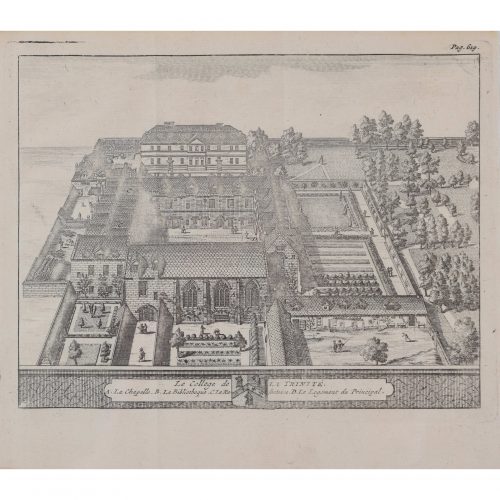
Pieter van der Aa (1659-1733), after David Loggan (1634–1692)
Trinity College, Oxford (1727)
Engraving 12 x 16 cm An eighteenth-century view of Trinity College, engraved by Pieter van der Aa after David Loggan, the noted engraver, draughtsman, and painter who specialised in engravings of Oxford and Cambridge. Pieter van der Aa of Leiden was a Dutch publisher best known for preparing maps and atlases, though he also printed editions of foreign bestsellers and illustrated volumes. He is noted for the many engravings he produced after David Loggan's series of Oxford and Cambridge colleges and costumes. In 1727 Van Der Aa illustrated "Les Delices de la Grande Bretagne & de L'Irelande" by James Beeverell, the book in which this engraving appears. Condition: a good impression. If you’d like to know more, please email info@manningfineart.co.uk or call us on 07929 749056. -

Pieter van der Aa (1659-1733), after David Loggan (1634–1692)
Balliol College, Oxford (1727)
Engraving 12 x 16 cm An eighteenth-century view of Balliol, engraved by Pieter van der Aa after David Loggan, the noted engraver, draughtsman, and painter who specialised in engravings of Oxford and Cambridge. Pieter van der Aa of Leiden was a Dutch publisher best known for preparing maps and atlases, though he also printed editions of foreign bestsellers and illustrated volumes. He is noted for the many engravings he produced after David Loggan's series of Oxford and Cambridge colleges and costumes. In 1727 Van Der Aa illustrated "Les Delices de la Grande Bretagne & de L'Irelande" by James Beeverell, the book in which this engraving appears. Condition: a good impression; trimmed just onto platemark on left side. If you’d like to know more, please email info@manningfineart.co.uk or call us on 07929 749056. -
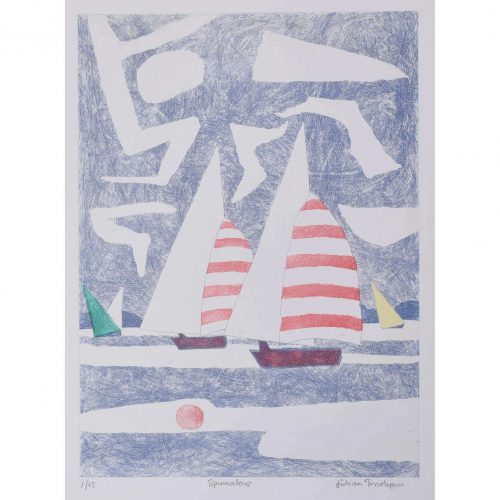
Julian Trevelyan (1910-1988)
Spinnakers (1972)
Etching 48 x 35 cm (sheet size 68 x 55 cm) Signed in pencil and numbered 1/65. The Tate holds number 24/56 - reference P01330. Small vessels weave around two great boats with striped masts, observed by a dark sky full of geometric clouds. A red buoy bobs in the foreground, and the heavily textured sea and sky blend into one. Nephew of the historian G M Trevelyan, Julian Trevelyan was educated at Bedales and then at Trinity College, Cambridge, where he read English. After moving to Paris, Trevelyan studied engraving at Stanley William Hayter’s school, working alongside artists such as Max Ernst, Joan Miro and Pablo Picasso. He married the potter Ursula Darwin in 1934, and in 1935 they moved to Hammersmith, buying Durham Wharf beside the River Thames which was Trevelyan’s studio – and home – for the rest of his life. His wartime service was – like so many artists – as a camoufleur. A Royal Engineer from 1940-43, he served in North Africa and Palestine, forcing the German Afrika Korps to use resources against a dummy army whilst real tanks were disguised as more harmless equipment. In the desert, nothing could be hidden - but it could be disguised. Following the dissolution of his marriage in 1950, he married the painter Mary Fedden. Teaching at Chelsea School of Art, Trevelyan eventually became head of the Etching Department and his pupils included David Hockney and Peter Ackroyd. Condition: generally very good. Mounted to board. If you’d like to know more, please email info@manningfineart.co.uk or call us on 07929 749056. -

Angela Stones (1914 - 1995)
Still Life with Fruit and Flowers
Oil on board 62 x 46 cm A typically stylish mid-century still life. The citrus fruits in the foreground are the painting's focus, with their peel dancing between reds, greens, yellows, and oranges. Stones was educated at the Chelsea School of Art, and was a member of an artistic dynasty. Her mother Dorothy Bradshaw (1893-1983) studied under Jack Merriott – the artist famous for his British Rail posters, and her son, Christopher Assheton-Stones (1947-1999), was arguably the foremost pastel artist of his time. Provenance: the family of the artist. Condition: very good; recently cleaned and varnished. If you’d like to know more, please email info@manningfineart.co.uk or call us on 07929 749056. -
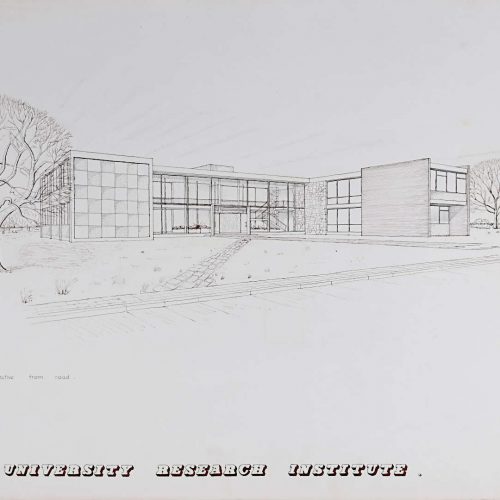
V A Hards (British, c. 1930-c. 2012) Exterior for a University Research Institute (1956)
Watercolour on wove 77 x 55 cm Signed and dated 1956. Hards was educated at Brixton School of Building and Woolwich Polytechnic between 1948 and 1956, during which period he produced some very competent work, including this design for a brutalist University Institute's exterior. Brixton School of Building was incorporated into the Polytechnic of the South Bank - now London South Bank University. Condition: some edge wear and isolated spots - see photographs. Stamped and marked with 'Brixton School of Building' stamp. If you’d like to know more, please email info@manningfineart.co.uk or call us on 07929 749056. -
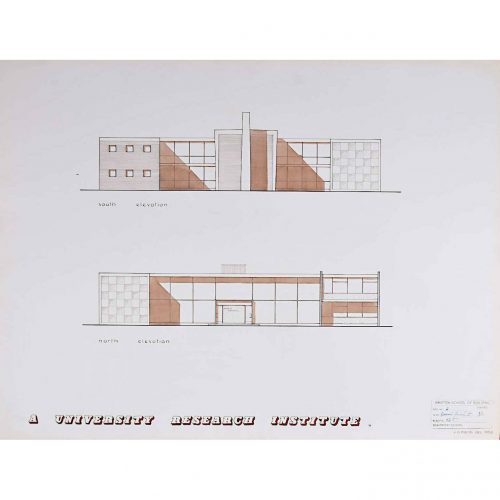
V A Hards (British, c. 1930-c. 2012) Design for Modernist Brutalist University Institute IV (1956)
Watercolour on wove 77 x 55 cm Signed and dated 1956. Hards was educated at Brixton School of Building and Woolwich Polytechnic between 1948 and 1956, during which period he produced some very competent work, including this design for a university's brutalist building. Brixton School of Building was incorporated into the Polytechnic of the South Bank - now London South Bank University. Condition: some edge wear and isolated spots - see photographs. Stamped and marked with 'Brixton School of Building' stamp. If you’d like to know more, please email info@manningfineart.co.uk or call us on 07929 749056. -
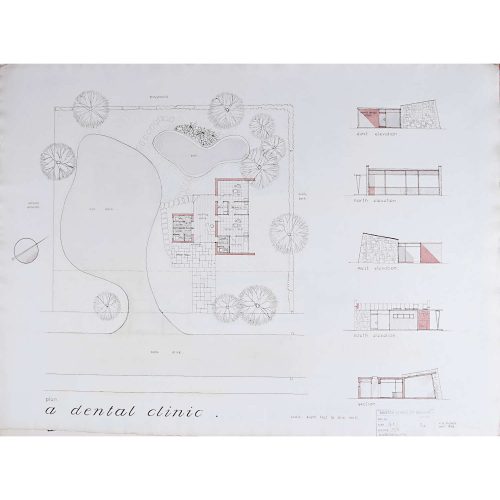
V A Hards (British, c. 1930-c. 2012) Design for Modernist dental surgery (1956)
Watercolour on wove 77 x 55 cm Signed and dated 1956. Hards was educated at Brixton School of Building and Woolwich Polytechnic between 1948 and 1956, during which period he produced some very competent work, including this rather fun modernist design for a dentist's surgery. Brixton School of Building was incorporated into the Polytechnic of the South Bank - now London South Bank University. Condition: some edge wear and isolated spots - see photographs. Stamped and marked with 'Brixton School of Building' stamp. Condition: some edge wear and isolated spots - see photographs. Stamped and marked with 'Brixton School of Building' stamp. If you’d like to know more, please email info@manningfineart.co.uk or call us on 07929 749056. -
Out of stock
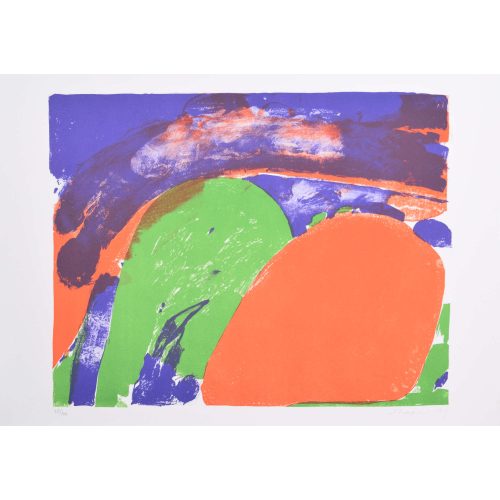
Shmuel Shapiro (1924 - 1983) Two Lovers (1966)
Original lithograph on handmade Barcham Green paper 34 x 44 cm (sheet size 40 x 57 cm) Signed, dated, and numbered 75/100 in pencil. Published and printed at the Curwen Studio, London, in 1966. Shapiro was an American Jewish artist. This typically emotive but unusually colourful work conveys the passion that accompanies true love, with the green and orange forms pressing desperately against one another. An example of this lithograph is held in the Tate Gallery's permanent print collection. Provenance: acquired directly from the Curwen Archive. Condition: excellent. If you’d like to know more, please email info@manningfineart.co.uk or call us on 07929 749056. -
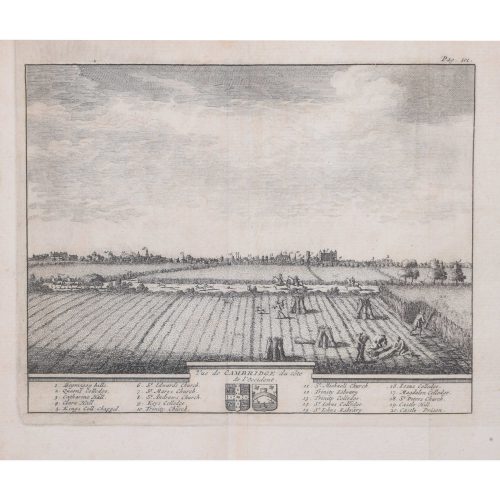
Pieter van der Aa (1659-1733), after David Loggan (1634–1692)
Cambridge from the East (1727)
Engraving 12 x 16 cm An eighteenth-century view of Cambridge from the East, engraved by Pieter van der Aa after David Loggan, the noted engraver, draughtsman, and painter who specialised in engravings of Oxford and Cambridge. A wide Cambridgeshire sky opens out over the harvest scene; in the background, the spires of the city's skyline are numbered, and identified below. A fascinating engraving which muses on the relationship between the city and its University. Pieter van der Aa of Leiden was a Dutch publisher best known for preparing maps and atlases, though he also printed editions of foreign bestsellers and illustrated volumes. He is noted for the many engravings he produced after David Loggan's series of Oxford and Cambridge colleges and costumes. In 1727 Van Der Aa illustrated "Les Delices de la Grande Bretagne & de L'Irelande" by James Beeverell, the book in which this engraving appears. Condition: generally very good. If you’d like to know more, please email info@manningfineart.co.uk or call us on 07929 749056. -
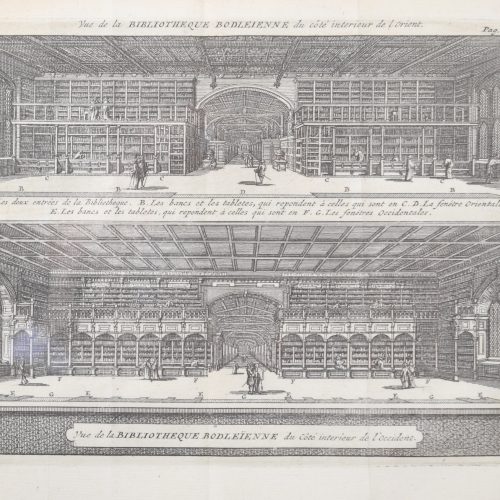
Pieter van der Aa (1659-1733), after David Loggan (1634–1692)
The Bodleian Library, University of Oxford
Engraving (1727) 12 x 16 cm An eighteenth-century view of the interior of the Bodleian Library, engraved by Pieter van der Aa after David Loggan, the noted engraver, draughtsman, and painter. Pieter van der Aa of Leiden was a Dutch publisher best known for preparing maps and atlases, though he also printed editions of foreign bestsellers and illustrated volumes. He is noted for the many engravings he produced after David Loggan's series of Oxford and Cambridge colleges and costumes. In 1727 Van Der Aa illustrated "Les Delices de la Grande Bretagne & de L'Irelande" by James Beeverell, the book in which this engraving appears. Condition: a good impression. If you are interested, please email info@manningfineart.co.uk or call us on 07929 749056. -
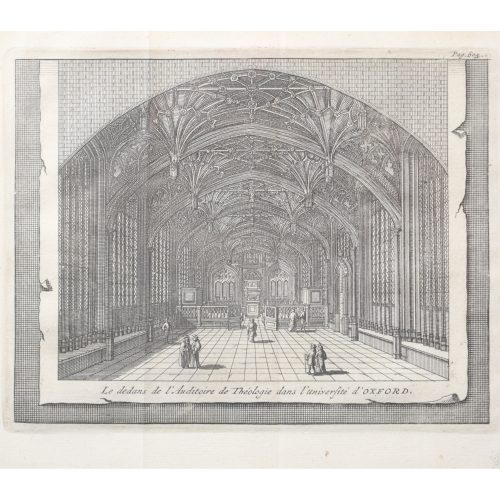
Pieter van der Aa (1659-1733), after David Loggan (1634–1692)
The Divinity School, University of Oxford
Engraving (1727) 12 x 16 cm An eighteenth-century view of Oxford's medieval Divinity School, which was once the beating heart of theological studies at the University. The scene is engraved by Pieter van der Aa after David Loggan, the noted engraver, draughtsman, and painter. Of particular interest here is the trompe l'oeil piece of torn paper which frames the Divinity School view. Pieter van der Aa of Leiden was a Dutch publisher best known for preparing maps and atlases, though he also printed editions of foreign bestsellers and illustrated volumes. He is noted for the many engravings he produced after David Loggan's series of Oxford and Cambridge colleges and costumes. In 1727 Van Der Aa illustrated "Les Delices de la Grande Bretagne & de L'Irelande" by James Beeverell, the book in which this engraving appears. Condition: a good impression. If you are interested, please email info@manningfineart.co.uk or call us on 07929 749056. -
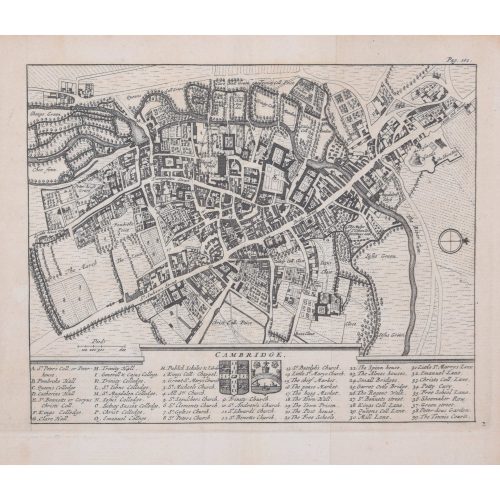
Pieter van der Aa (1659-1733), after David Loggan (1634–1692)
Map of Cambridge
Engraving (1727) 12 x 16 cm An eighteenth-century map of Cambridge engraved by Pieter van der Aa after David Loggan, the noted engraver, draughtsman, and painter who specialised in engravings of Oxford and Cambridge. Loggan's vision illustrates the inimitable layout of Cambridge; the River Cam, Bridge Street, and Trumpington Street bend across the map like arteries. Pieter van der Aa of Leiden was a Dutch publisher best known for preparing maps and atlases, though he also printed editions of foreign bestsellers and illustrated volumes. He is noted for the many engravings he produced after David Loggan's series of Oxford and Cambridge colleges and costumes. In 1727 Van Der Aa illustrated "Les Delices de la Grande Bretagne & de L'Irelande" by James Beeverell, the book in which this engraving appears. If you are interested, please email info@manningfineart.co.uk or call us on 07929 749056. -
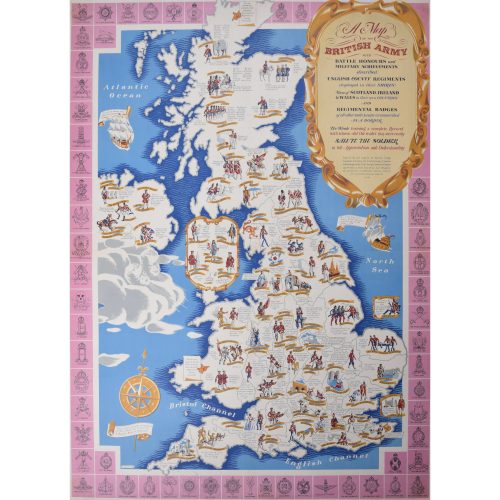
Charles Paine (1895-1967)
Army Map of England (1944)
Lithograph 99 x 75 cm Published for the National Savings Committee in London, the Scottish Savings Committee in Edinburgh, and the Ulster Savings Committee in Belfast. Printed at Field Sons & Co. Ltd., Bradford, for His Majesty's Stationery Office, London. Signed lower left in the plate. Charles Paine was a versatile and prolific designer, who drew on his training in stained glass to create bold, structured and highly stylised lithographs for a variety of companies. This decorative and brightly-coloured map illustrates the various county regiments of Great Britain, with a border of regimental badges. If you’d like to know more, please email info@manningfineart.co.uk or call us on 07929 749056. -
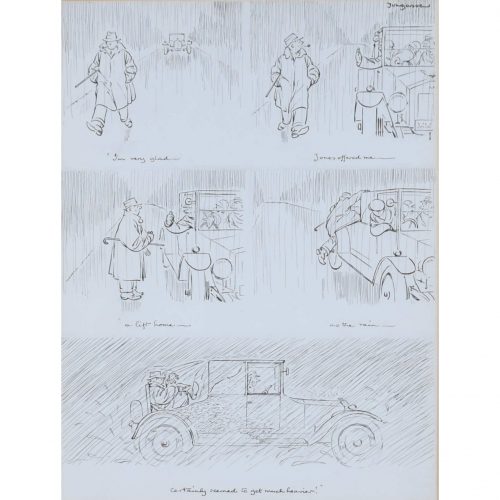
Fougasse (Cyril Kenneth Bird, 1887 - 1965)
'I'm very glad Jones offered me a lift home as the rain certainly seemed to get much heavier!' (1966)
Pen and ink 32 x 24 cm Signed upper right. Cyril Kenneth Bird, under the name Fougasse, was a British cartoonist. He was art editor of Punch 1937 - 1949, and subsequently editor until 1953. He is best known for his ‘Careless Talk Costs Lives’ series of posters, and produced many other posters for the Ministry of Information and London Underground. His pen and ink cartoons for Punch are some of his gentlest and funniest works. Provenance: The Fine Art Society Ltd., 148 New Bond Street, June 1966. If you’d like to know more, please email info@manningfineart.co.uk or call us on 07929 749056. -
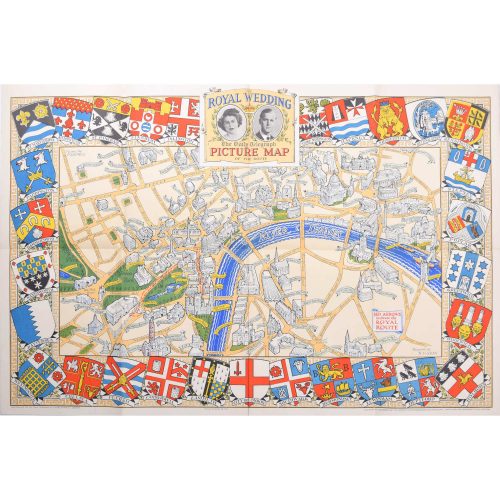
N. V. Gray
The Royal Wedding: Picture Map of the Route through London (1947)
Lithograph 50 x 76 cm Produced by H.A. & W.L. Pitkin Ltd for the Daily Telegraph and published by Geographia Ltd., of Hutchinson & Co. Signed in plate lower right. Complete with slip showing the genealogy of the two parties. Princess Elizabeth (later Her Majesty Queen Elizabeth II) and Prince Philip married on Thursday 20th November 1947 at Westminster Abbey in London. This map, commissioned and sold by the Daily Telegraph newspaper, was designed by N. V. Gray. It depicts the route the carriage processions took on the way to the Abbey; Princess Elizabeth and her father King George Vi travelled in the magnificent Irish State Coach. Crests of London's boroughs border this delightfully coloured map. If you’d like to know more, please email info@manningfineart.co.uk or call us on 07929 749056. -
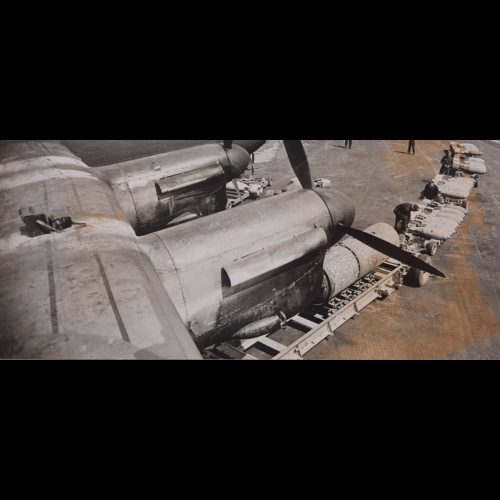
Lancaster Bomber Arming D-Day + 1
Original Silver Gelatin photograph, c. 1944 11 x 25 cm Stamped to reverse "Certified by Fox Photos Ltd as passed by censor, Press and Censorship Bureau" "Thousands of Planes Keep Up the Offensive "Thousands of planes are continuously taking part in the new offensive for the liberation of Europe. "Photograph shows: Ground staff loading up a Lancaster with a cookie and 1,000 lb bombs, ready for the new offensive. The air crew and bomb train are dwarfed when seen on the ground from one of the huge bombers. "Fox June 7 '44." D-Day was 6 June 1944 Provenance: from the collection of Philip J R Moyes, author of many books on the RAF, most notably The Pictorial History which ran to several volumes. Condition: photograph has discoloured in some areas. -
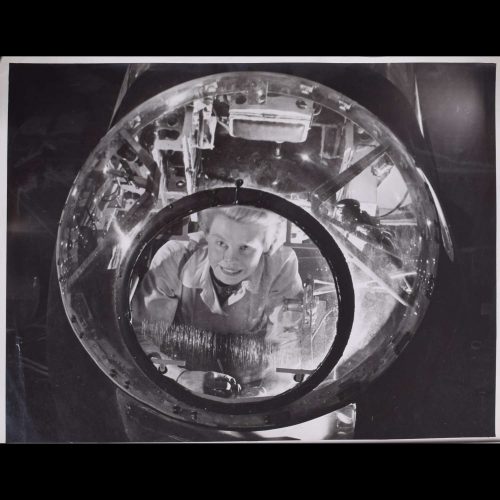
Birth of a Lancaster
Original Silver Gelatin photograph, 1942 19 x 25 cm Stamped to reverse "Topical Press Agency Limited, Red Lion Court, Fleet Street London" and (partially obscured) "Certified by Topical Press Agency as passed by censor" "The Avro Lancaster - the fastest and greatest load carrier of all the world's heavy bombers, and scourge of the Germans from Cologne to Gdynia, Rostock to Augsburg near Munich, is now being produced so speedily that fresh squadrons are being equipped weekly, and nightly spread terror and destruction through the German industrial centres. "Photo shown: a girl inspector goes over every detail of fitting work in the bomber's nose. She is occupying the position that the bomb aimer will take on operational work. Every small part of the plane has undergone stringent inspection. "Ref number Y7119 Topical Press 2/9/42" There is nothing new in the world, a pretty girl always captures the attention of the photographer. In war-torn Britain, of course, the contribution of women to the war effort was hugely important, replacing men in factories so that the men could go off to war. Provenance: from the collection of Philip J R Moyes, author of many books on the RAF, most notably The Pictorial History which ran to several volumes. Condition: mostly good. -
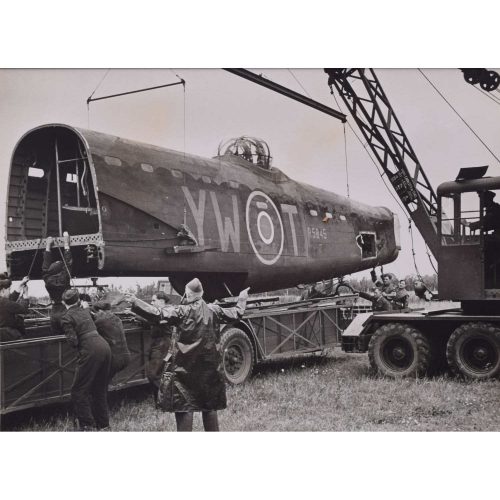
Lancaster Bomber R5845 YW-T
Original Silver Gelatin photograph 19 x 25 cm Stamped to reverse "Copyright Hulton Press Ltd" The RAF Maintenance Unit are recovering R5845 which was on the strength of 1660 Heavy Conversion Unit Winthorpe in October 1943 from the runway. Newark Air Museum have another photograph - included in the attached photographs, but not available for sale - of the entire aeroplane on a string of Queen Mary trailers. R5845 was finally written off on the night of 18/19 July 1944 on a mission to destroy a railway junction at Revigny in France. With 11 x 1000lb and 3 x 500lb bombs nothing was heard of the aircraft after takeoff and it failed to return to base. Following the war it was established that it was intercepted by a night fighter on its way home. Four of the crew evaded capture, and one was made PoW, the Pilot F/O TEW Davis of RAAF being buried in the churchyard at Heiltz-le-Maurupt, Marne, France. Provenance: from the collection of Philip J R Moyes, author of many books on the RAF, most notably The Pictorial History which ran to several volumes. Condition: mostly good. -
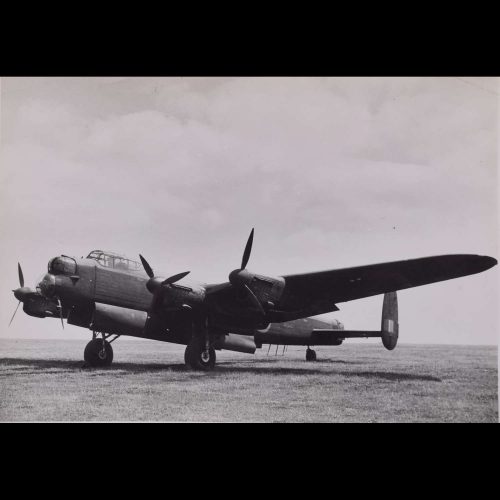
Lancaster HK543
Original Silver Gelatin photograph 19 x 25 cm Stamped to reverse "Copyright 'the Aeroplane'" 23 July 1945 HK543 was a Lancaster III, probably produced in 1943. Here she is shown in July 1945, she was recorded photgraphically on bombing trials from Boscombe Down that month, this photograph may reasonably be assumed to be from that event. Provenance: from the collection of Philip J R Moyes, author of many books on the RAF, most notably The Pictorial History which ran to several volumes. Condition: mostly good. -
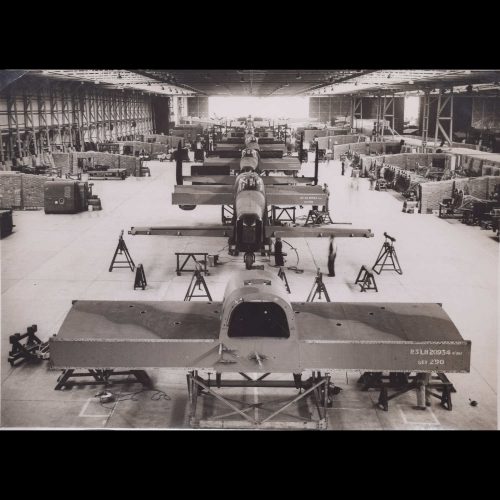
Lancaster Bombers under Construction
Original Silver Gelatin photograph 17 x 21 cm Stamped to reverse 'Certified by Photographic News Agencies Ltd as passed by Censor' '23 Oct 1942' This photograph shows the parts of a Lancaster bomber being assembled. At the back of the photograph, facing away from the viewer, are two nearly or newly completed aircraft, their airscrews visible attached to the wings. The factory buzzes with activity as important war work is undertaken. We have been unable to trace any other copy of this photograph. Provenance: from the collection of Philip J R Moyes, author of many books on the RAF, most notably The Pictorial History which ran to several volumes. -
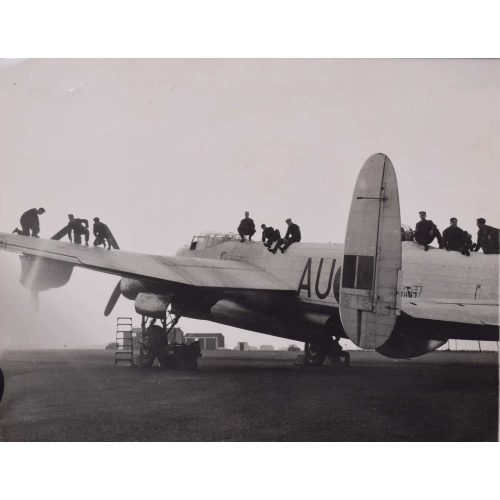
Lancaster Bomber AU-Q loading bombs
Original Silver Gelatin photograph 21 x 25 cm Stamped to reverse 'Copyright Associated Press Photograph' Press release states:LAST MINUTE PREPARATIONS FOR TOMORROW'S ATTACK ON THE FLEET At RAF Station Upwood, Hunts, today, Dec 8th last minute preparations were being carried out for tomorrow's attack on the fleet. Photo shows a Lancaster being made ready for a dawn take off tomorrow photographed this evening against the setting sun. WOR 339889 Associated Press Photo Provenance: from the collection of Philip J R Moyes, author of many books on the RAF, most notably The Pictorial History which ran to several volumes. -
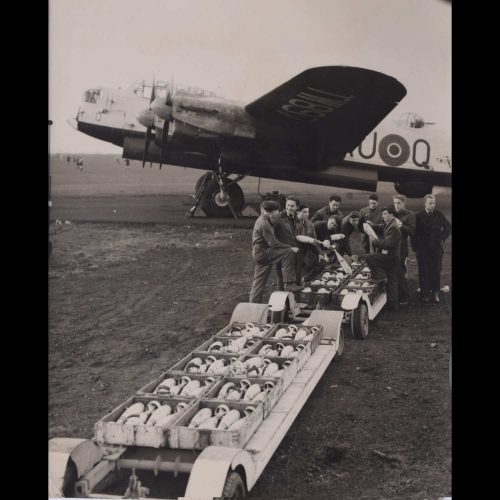
Lancaster Bomber AU-Q loading bombs
Original Silver Gelatin photograph 25 x 20 cm Stamped to reverse 'Copyright Associated Press Photograph' Press release states:LAST MINUTE PREPARATIONS FOR TOMORROW'S ATTACK ON THE FLEET At RAF Station Upwood, Hunts, today, Dec 8th last minute preparations were being carried out for tomorrow's attack on the fleet. Photo shows airmen of 148 Squadron no 3 Bomber Command look over smoke bombs with a Lancaster in background. WOR 339888 Provenance: from the collection of Philip J R Moyes, author of many books on the RAF, most notably The Pictorial History which ran to several volumes. Condition: generally good. -
Out of stock
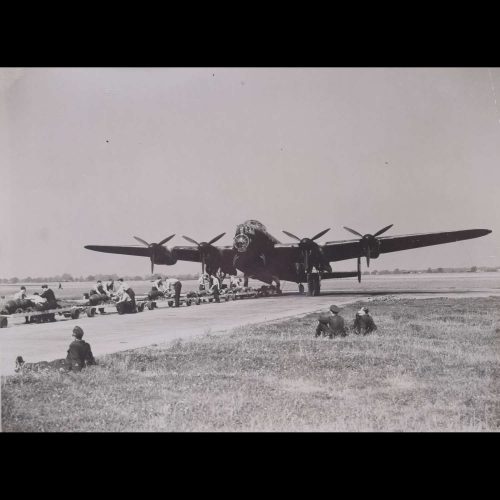
Lancaster Bomber being armed
Original Silver Gelatin photograph, c. 1942 16 x 21 cm Stamped to reverse 'Copyright this photograph must not be reproduced without the permission of Aeroplane' and 'This photograph has been passed by censor'. The photograph of the Swinderby based 50 Sqn - was taken in 1942. Either at the June reopening of the aerodrome with its new concrete runways (replacing grass) or in August when the photographers descended on the aerodrome again to take photographs for aircraft recognition purposes. Everitt survived the war - having flown 56 operations for which he was decorated three times, subsequently he was a bombing instructor, commanded a V-bomber squadron, and played golf into his nineties. He died in 2012 and the Telegraph published an excellent obituary. Provenance: from the collection of Philip J R Moyes, author of many books on the RAF, most notably The Pictorial History which ran to several volumes. -

Lancaster Bomber with 8000lb cookie bomb
Original Silver Gelatin photograph, September 1943 19 x 25 cm Stamped to reverse 'Copyright this photograph must not be reproduced without the written permission of The Aeroplane.' BRITISH OFFICIAL PHOTOGRAPH CH 10939(WK) Air Ministry Photo- Crown Copyright Reserved (Picture issued September 1943) THE RAF's EIGHT THOUSAND POUND BOMB Stamped to reverse 'British Official Photograph, Crown Copyright Reserved, Supplied by BIPPA, Passed for publication by Ministry of Information'. The press release states: First official photographs of the RAF's 8,000 lb and 4,000 lb bombs are now released. Their weight has been felt with devastating effect on enemy targets in Italy and Germany. Picture shows:- Close-up of an 8,000 lb bomb in front of the Lancaster which will carry it on the night's raid. The 8000 lb 'super cookie' was a 'blockbuster' bomb, so-called because it could destroy an entire block of flats on its own. The Germans called these large bombs 'Luftminen' - airmines - as during the Blitz the large bombs used by the Luftwaffe were adapted marine mines. Judging by the length of the hair of the person sitting by the bomb, this is a member of the WAAF. WAAFs were often used to drive tractors on aerodromes during the war. Condition: generally good Provenance: from the collection of Philip J R Moyes, author of many books on the RAF, most notably The Pictorial History which ran to several volumes. -
Out of stock
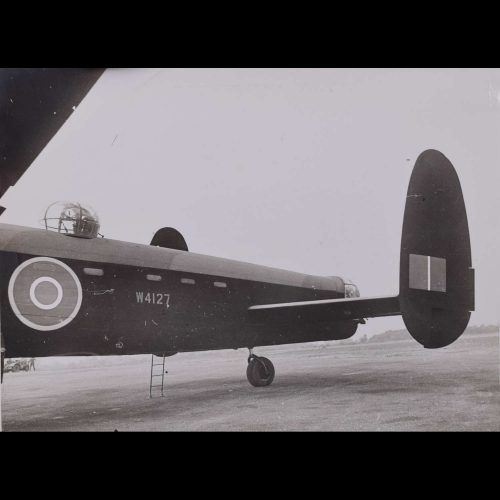
Lancaster Bomber W4127
Original Silver Gelatin photograph 16 x 21 cm Stamped to reverse 'Copyright this photograph must not be reproduced without the written permission of The Aeroplane.' W4127, of Sqn 419 (RCAF) was lost on the night of 20/21 April 1944 whilst returning from a mission to bomb the railway yards at La Chappelle. Having taken off from Dunholme Lodge at 22.07 and completed its bombing raid, it was attacked by a night fighter, suffering a fire in one wing, crashing north of Paris. The yards were badly damaged by the bombing, the mission a success. Six of the crew were killed and are buried in Poix de la Somme churchyard, whilst one, Bob Hortie, evaded escape. The Comet line - the escape line that took downed airmen to Spain whereby they could return to England - found it hard to operate with the destruction of rail and road infrastructure in the period leading up to D-Day and the invasion of Europe. Airey Neave of MI9 therefore set up three camps in isolated forests in Northern France where downed airmen could await the invading allied forces. The camps were supplied - and manned - by the allies through parachute drops. Hortie was one of 152 allied airmen to be in the camp at Fréteval - codenamed 'Sherwood Camp'. Neave went to France in the middle of August, to Le Mans which was controlled by the Americans and was 75 miles from Sherwood Camp. The Americans distrusted Neave and refused to provide him with transport. He managed to come up with some trucks and buses, which - decked out with flowers and French flags and guarded by a civilians armed with rifles and a handful of SAS men - set out to Fréteval on 14 August 1944 returning the same day with 132 airmen. A further 20 were recovered the following day. Most returned to active service and 38 died before the end of the war. A souvenir from the camp is published here on the internet. The camps were due to be set up by a team that included Belgian resistance member Michelle Dumon, who at the age of 22 (with an identity card that showed she was 16) had exfiltrated 250 airmen by this point. However she unmasked a German infiltrator into the Comet line just as the camps were being set up and was therefore sought by the Gestapo and had to flee to England. That seemingly simple journey of course meant a perilous journey across France to Spain, crossing the Pyrenees on foot, and being rescued by the RAF. In this photograph L4127 is without its squadron letters, suggesting that it is fresh out of the factory at the time of the photograph. -
Out of stock
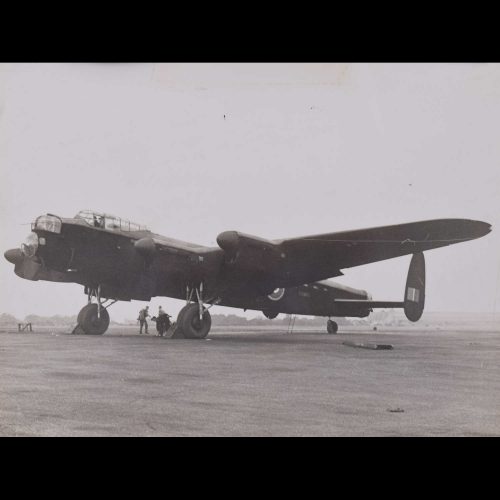
Lancaster Bomber at RAF Waddington
Original Silver Gelatin photograph 16 x 22 cm Stamped to reverse 'Passed by censor' and 'Copyright This photograph must not be reproduced without permission of 'The Aeroplane.' Unfortunately the serial number of the aeroplane is unclear. It may be RAF Waddington-based R5905 of 44 Sqn which crash landed near Madum in Denmark on 24 September 1942. The crew all survived the landing and were taken prisoner, spending the rest of the war in a PoW camp (where one died in March 1945) before returning home. Further details regarding their exploits are here. Alternatively it is R5903 also of 44 Sqn which crashed at Klosterholte on 7 October 1942 having left RAF Waddington; five of the crew survived the crash, with the two airgunners dying. -
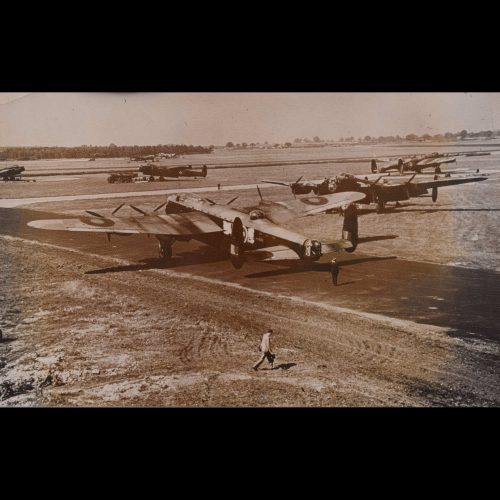
Lancaster Bomber VN-N R5689
Original Silver Gelatin photograph 11 x 16 cm Stamped to reverse 'This TP Copyright illustration from 'The Aeroplane' must not be reproduced without the written permission of Temple Press.' The photograph - and several others of the Swinderby based R5689 of 50 Sqn - was taken on the base open day in June 1942, a week or so after the aerodrome had reopened having been improved with concrete - rather than grass - runways. R5689 was destroyed on the night of 18/19 September that year. It had been on a sea mining mission and crashed on landing when both port engines failed. Four crew members were killed and three further were injured. It is also proposed that R5689 be imortalised by the Bomber Gateway Trust with a lifesize replica spraying poppies across the country, just a short distance from its crash site in Lincolnshire. Further funding is required before the project can be completed. They have 'colourised' a copy of this photograph on their website, see here. Condition: the photograph has discoloured and taken on a sepia hue as may be seen in the image. Provenance: from the collection of Philip J R Moyes, author of many books on the RAF, most notably The Pictorial History which ran to several volumes. -
Out of stock
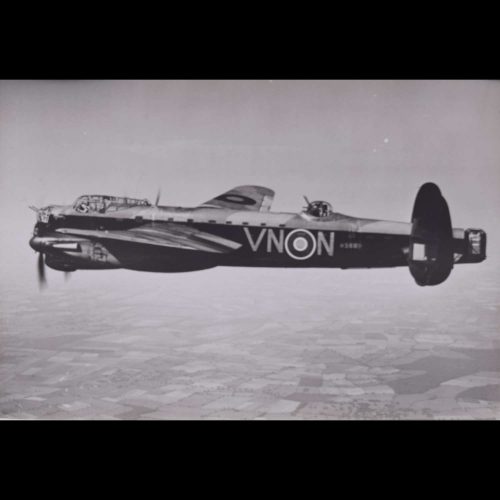
Lancaster Bomber VN-N R5689
Original Silver Gelatin photograph 11 x 16 cm Stamped to reverse 'This TP Copyright illustration from 'The Aeroplane' must not be reproduced without the written permission of Temple Press.' The photograph - and several others of the Swinderby based R5689 of 50 Sqn - was taken on 28 August 1942. The pilot was Sqn Ldr Hugh Everitt. One of the most photographed Lancasters of the RAF's fleet, it was utilised for literature that trained aircrew to recognise the Lancaster. It is also proposed that it be imortalised by the Bomber Gateway Trust with a lifesize replica spraying poppies across the country, just a short distance from its crash site in Lincolnshire. Further funding is required before the project can be completed. R5689 was destroyed on the night of 18/19 September that year. It had been on a sea mining mission and crashed on landing when both port engines failed. Four crew members were killed and three further were injured. Everitt was not flying R5689 on the night it crashed. He survived the war - having flown 56 operations for which he was decorated three times, commanded a V-bomber squadron and played golf into his nineties. He died in 2012 and the Telegraph published an obituary. We have another photograph that includes him sitting on the grass in front of a Lancaster that is being armed. -
Out of stock
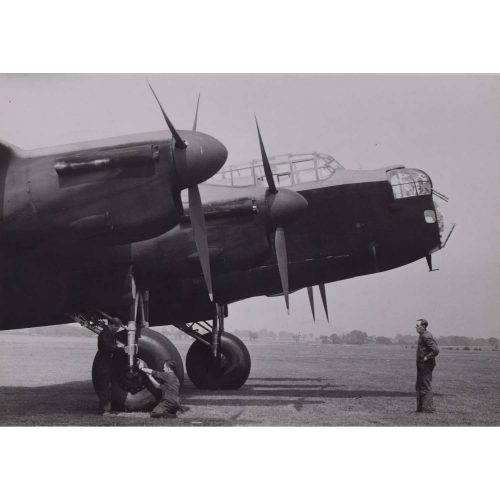
Lancaster Bomber
Original Silver Gelatin photograph, July 1942 11 x 16 cm Stamped to reverse 'Passed for Publication 2 July 1942 Press and Censorship Bureau', 'Public Relations Branch MAP'. A fine photograph; two erks are adjusting the starboard undercarriage of a Lancaster bomber whilst being supervised - the supervisor apparently with his hands in his pockets in very unmilitary fashion! The sun is high in the sky, casting a rather fine shadow under the bomber. -
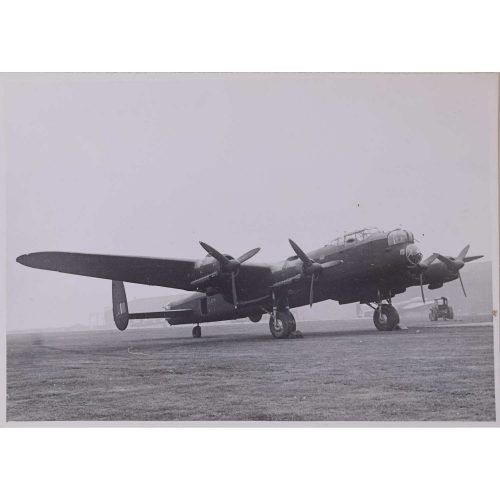
Lancaster LL678 'Lily Mars' - 2
Original Silver Gelatin photograph, December 1943 12 x 16 cm Stamped to reverse 'The Photograph has been passed by Censor' 'Copyright This TP copyright illustration from "The Aeroplane" must not be reproduced without the written permission of Temple Press Ltd'. 'Lancaster II heavy bombers are now flying with RAF BOMBER COMMAND.' 300 Lancaster II aeroplanes were made, fitted with Bristol Hercules radial engines, as there was a worry that there would be a shortage of Merlin engines, reserved for the Spitfire and Hurricane. Lily Mars was named after the 1943 American musical starring Judy Garland and was based at RAF Waterbeach, in Cambridgeshire. A podcast (click) gives details of the final flight on 13 June 1944 which was to be the final raid of the crew's tour. The bombing raid was of 303 Lancasters against the Nordstern synthetic oil plant at Gelsenkichen in the Ruhr, deep inside Germany and the aircraft took off at 23.12 hrs. On the home run LL678 was intercepted and shot down by a night fighter capitained by Oberleutnant Schmidt in a Bf 110 at 01.24 hrs at Zuidloo, a small hamlet, where five of the eight crew are buried; the other three crew members baled out and escaped. A memorial plaque was laid on 4 May 2016 and a Lancaster flypast was arranged. Owing to technical problems a Dakota from the BBMF was sent instead. On 4 May 2022 the Lancaster of the BBMF undertook a flypast which can be seen here. Dietrich Schmidt (1919-?) had 29 confirmed night kills by the time of LL678, achieving 41 kills by the end of the war off 171 missions and was awarded the Ritterkreuz - Knight's Cross. In 1999 the living crewmembers, Dutch resistance, and Schmidt and his wireless operator met in the Netherlands. Provenance: from the collection of Philip J R Moyes, author of many books on the RAF, most notably The Pictorial History which ran to several volumes. -
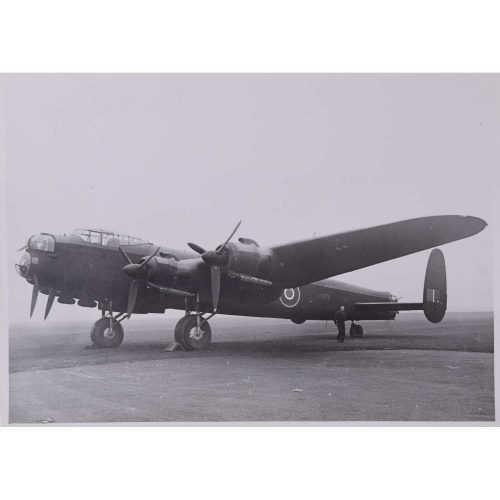
Lancaster LL678 'Lily Mars' - 1
Silver Gelatin photograph, December 1943 12 x 16 cm Stamped to reverse 'The Photograph has been passed by Censor' 'Copyright This TP copyright illustration from "The Aeroplane" must not be reproduced without the written permission of Temple Press Ltd'. 'A general view of an Avro Lancaster II with Hercules radial motors.' 300 Lancaster II aeroplanes were made, fitted with Bristol Hercules radial engines, as there was a worry that there would be a shortage of Merlin engines, reserved for the Spitfire and Hurricane. Lily Mars was named after the 1943 American musical starring Judy Garland and was based at RAF Waterbeach, in Cambridgeshire. An excellent podcast (click) gives details of the final flight on 13 June 1944 which was to be the final raid of the crew's tour. The bombing raid was of 303 Lancasters against the Nordstern synthetic oil plant at Gelsenkichen in the Ruhr, deep inside Germany and the aircraft took off at 23.12 hrs. On the home run LL678 was intercepted and shot down by a night fighter capitained by Oberleutnant Schmidt in a Bf 110 at 01.24 hrs at Zuidloo, a small hamlet, where five of the eight crew are buried; the other three crew members baled out and escaped. A memorial plaque was laid on 4 May 2016 and a Lancaster flypast was arranged. Owing to technical problems a Dakota from the BBMF was sent instead. On 4 May 2022 the Lancaster of the BBMF undertook a flypast which can be seen here. Dietrich Schmidt (1919-?) had 29 confirmed night kills by the time of LL678, achieving 41 kills by the end of the war off 171 missions and was awarded the Ritterkreuz - Knight's Cross. In 1999 the living crewmembers, Dutch resistance and Schmidt and his wireless operator met in the Netherlands. -
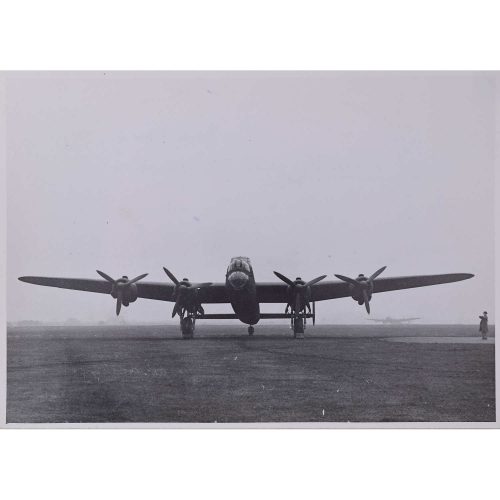
An Avro Lancaster II at its dispersal point
Silver gelatin print 12 x 16 cm Stamped to reverse 'This photograph has been passed by censor' 'Copyright. The TP copyright illustration from 'The Aeroplane' must not be reproduced without the written permission of Temple Press Ltd.' December 1943 The Avro Lancaster II was fitted with the rotary Bristol Hercules engine. There was a fear that there would be a shortage of Rolls-Royce Merlin engines, therefore 300 were produced by Armstrong Whitworth in Coventry with an alternative engine. Here it is pictured at an airfield, coming out of the mist. Somewhere probably in East Anglia, an area prone to fog, this atmospheric shot is enhanced by the second Lancaster bomber that is just about visible in the background and the human figure, dwarfed by the aeroplane, standing on concrete to the right. Condition: good. Provenance: from the collection of Philip J R Moyes, author of many books on the RAF, most notably The Pictorial History which ran to several volumes. -
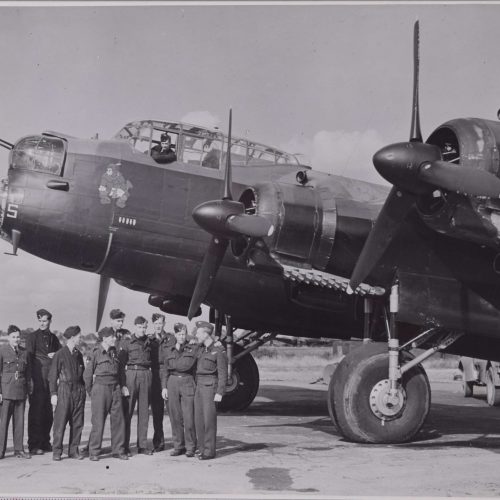
Lancaster Bomber with Crew
Original silver gelatin photograph c. 1943 16 x 21 cm Stamped to reverse 'This Photograph has been Passed by Censor' and 'Copyright Aeroplane [Magazine]' A photograph of the ground- and air-crew of DS689. The engine fitter second from left is Samuel Greisman. That the aeroplane has five operations marked on its nose suggests a date of late August or early September for the photograph. This photograph was published in 'Jews in Uniform' by Michael Greisman, published by Aster Publishing. DS689 OW-S (identified from this photograph on account of the nose art) served with 426 (Thunderbird) Squadron RCAF, based in Linton-on-Ouse (north of York). The Thunderbird featured inthe squadron crest is a North American native symbol signifying disaster and death to anybody who perceives it. The squadron converted to the Hercules-powered Lancaster II on 17 August 1943. Lancaster IIs were fitted with radial Bristol Hercules engines as it was feared there might be a shortage of Rolls-Royce Merlin engines. This particular aircraft was also able to carry 'cookies' with its extended bomb bay. DS689 was shot down by night-fighter on 8 October 1943 - prior to the date of publication of this photograph - near Rachecourt-sur-Blaise. It was on a 323-bomber mission to bomb Stuttgart in Germany, piloted by P/OMB Summers and equipped with the Airborne Cigar jamming system (ABC for short). This was the first operation using the ABC(3) jamming system, and only a small number of aircraft was lost on this raid. ABC jammed the airways and made night-fighter communications almost impossible. The Germans referred to is as 'dudelsack' (bagpipes) owing to the warbling sound. No 101 Squadron was the prime operator of this equipment and as a consequence of not maintaining radio silence suffered very high losses during the war; moreover its aircraft were on almost every bombing raid. A German-speaking operator identified the channels the night fighter operators were using and loud noise was played on that channel. Stuttgart was cloud covered and severe fog set in later, so bombs were dropped over a scattered area, destroying 344 houses and damaging a further 4,568. On its home run DS689 was intercepted by Oblt. Ferdinland Christiner from 5./NJG4at 3,800m and shot down (Christiner himself was shot down on 5/6 July 1944). Two crew members bailed out, the rest of the crew died in the crash and are buried in the local churchyard, click here to see photographs. The funeral was attended by the whole village and residents of the surrounding countryside and La Marsellaise was sung - to the annoyance of the Germans. The funeral was recorded by a photographer (click here) Condition: generally good. Provenance: from the collection of Philip J R Moyes, author of many books on the RAF, most notably The Pictorial History which ran to several volumes. -
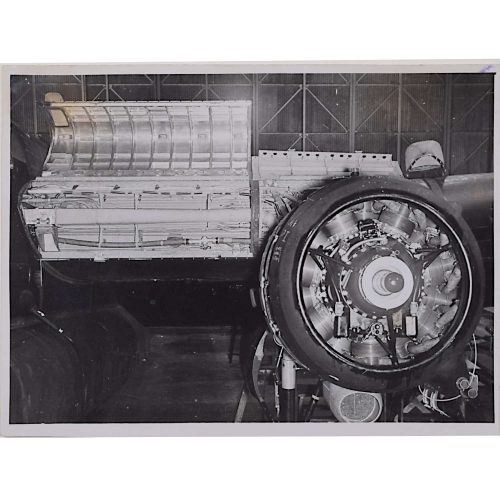
Lancaster Bomber De-icing System
Silver Gelatin photograph 1943 12 x 16 cm Stamped to reverse 'This photograph has been passed by censor. 17 Dec 1943' 'Copyright This TP copyright illustration from "The Aeroplane" must not be reproduced without the written permission of Temple Press Ltd.' 'De-icing system. - Cold air is passed into the flame-trap exhaust and forces hot air into wing leading edge.' Condition: good. Provenance: from the collection of Philip J R Moyes, author of many books on the RAF, most notably The Pictorial History which ran to several volumes. -
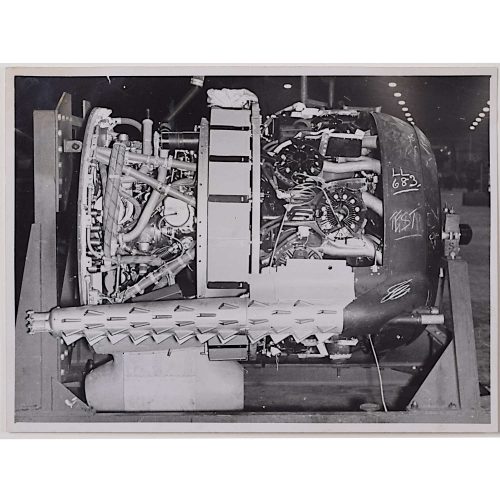
Lancaster bomber LL683 General View of Hercules Power Egg
Silver Gelatin photograph 17 December 1943 12 x 16 cm LL683 JI-P was a Lancaster II and therefore fitted with Bristol Hercules engines rather than the Rolls-Royce Merlin. 350 aircraft were outfitted thus, as a result of fears of shortages of the Merlin. The Hercules came complete as a 'power egg' which is a modular engine installation including ancillary equipment which could be swapped over rapidly for maintenance purposes. LL683 was assigned to 514 Squadron RAF, stationed at Waterbeach from December 1943 with an operational strength of thirty aircraft. The squadron eventually received sixty-seven such Lancasters (fifty-nine of which were destroyed by enemy action or accident). Stationed at Waterbeach from December 1943, the squadron had previously been stationed at RAF Foulsham in Norfolk. Three of the bombers made the move between the two airfields via a bombing raid on Berlin, the crew members' kit - including bicycles - also travelling via Berlin. LL683, serving with 514 Squadron RAF and stationed at Waterbeach had John Clare Gilbertson-Pritchard as pilot for a bombing raid on Stuttgart on the night of 01/02 March 1944. Back in action on 30/31 March for a 795-bomber raid raid on Nurnberg and piloted by W/O WL McGown, the aeroplane suffered a forced landing at Sawbridgeworth; all crew members survived though one broke his back and never flew again. Condition: good. Provenance: from the collection of Philip J R Moyes, author of many books on the RAF, most notably The Pictorial History which ran to several volumes. -
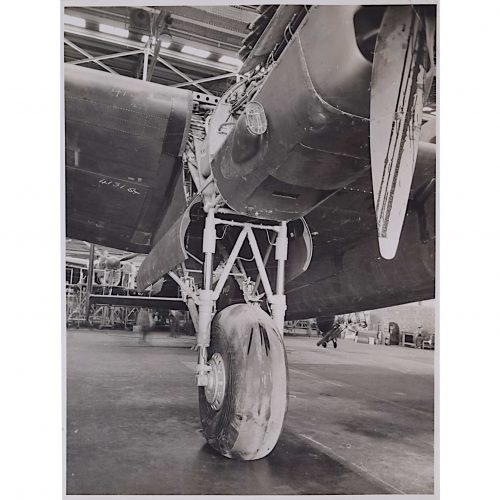
Lancaster Bomber W4131 Undercarriage
Original silver gelatin photograph c. 1943 21 x 16 cm Stamped 'Copyright Aeroplane Magazine' Stamped 'Passed by Censor' Rare; we have been unable to trace another copy of this photograph in any collection. W4131 served with 50 Squadron, based at Swinderby. On 18 August 1942 W4131 crash landed at Swinderby on return from a training flight at 17.15. The wheels were retracted too soon on take-off by pilot SGT PH Blaskey, damaging the undercarriage. The pilot and crew were uninjured. It is possible that this photograph records repairs to the undercarriage following this incident. On 28 March 1943 W4131 was involved in another incident, again at Swinderby. Although the aeroplane landed safely, the airframe was found to have been strained during a fighter affiliation exercise as a result of violent movements. On 1 June 1943 while serving with 1660 HCU (Heavy Conversion Unit) the undercarriage collapsed following an engine failure during take-off from Swinderby. The aircraft was written off on 12 June 1943. Condition: good. Provenance: from the collection of Philip J R Moyes, author of many books on the RAF, most notably The Pictorial History which ran to several volumes. -
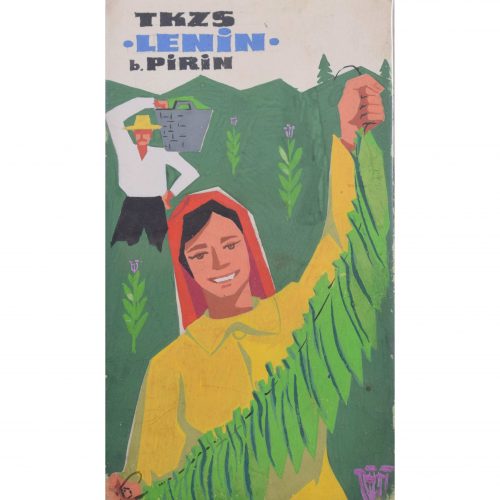
Soviet Union pro-Lenin Marxist Bulgarian propaganda poster design (circa 1950s)
Gouache on board 20 x 11.5 cm After a Communist takeover in 1945, Bulgaria was a Soviet ally during the Cold War, and maintained good relationships with Russia until the Revolutions of 1989. From 1945 to 1948, the country became entrenched within the Soviet sphere of influence under the control of the Bulgarian Communist Party (BCP) which oversaw a program of Stalinization in the late 1940s and 1950s. Both countries are Slavic nations, and are bound together by a common Orthodox Christian culture. This poster design is a piece of Leninist propaganda, designed to make Bulgarians associate Lenin and Soviet Marxist rule with efficiency and plenty. It is inscribed to the reverse in Bulgarian 'To grow plants in rows next to each other - the thickest row with straight cobs'. The Pirin Mountains referred to in the top left-hand corner are a mountain range in southwestern Bulgaria. Condition: very good. If you’d like to know more, please email info@manningfineart.co.uk or call us on 07929 749056. -
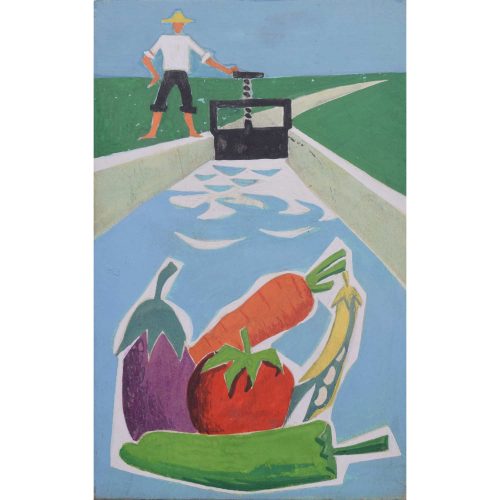
Soviet Union socialist irrigation Bulgarian propaganda poster design (circa 1950s)
Gouache on board 18 x 11 cm After a Communist takeover in 1945, Bulgaria was a Soviet ally during the Cold War, and maintained good relationships with Russia until the Revolutions of 1989. From 1945 to 1948, the country became entrenched within the Soviet sphere of influence under the control of the Bulgarian Communist Party (BCP) which oversaw a program of Stalinization in the late 1940s and 1950s. Both countries are Slavic nations, and are bound together by a common Orthodox Christian culture. This poster design features huge juicy vegetables, grown as the result of newly-implemented irrigation systems. Socialist farming practices in Bulgaria were commonplace during its time as a Soviet ally or 'satellite'; the government was keen to encourage well-yielding farming practices and to be seen as a protector of agricultural infrastructure turing this turbulent period of the 20th century. Condition: very good. If you’d like to know more, please email info@manningfineart.co.uk or call us on 07929 749056. -
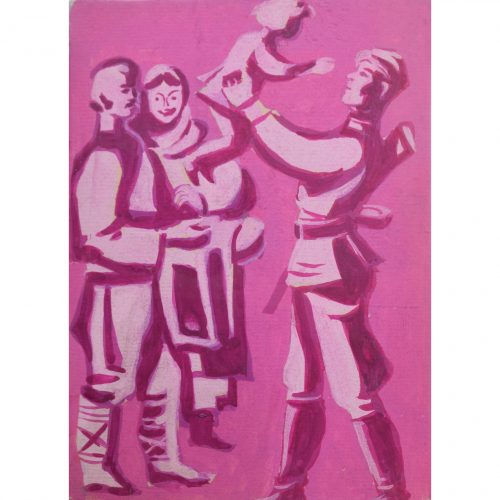
Bulgarian pro-natalist propaganda poster design (circa 1950s)
Gouache on board 17 x 12 cm After a Communist takeover in 1945, Bulgaria was a Soviet ally during the Cold War, and maintained good relationships with Russia until the Revolutions of 1989. From 1945 to 1948, the country became entrenched within the Soviet sphere of influence under the control of the Bulgarian Communist Party (BCP) which oversaw a program of Stalinization in the late 1940s and 1950s. Both countries are Slavic nations, and are bound together by a common Orthodox Christian culture. This poster design, painted in warm pink-purple tones and depicting a Bulgarian soldier holding a toddler aloft, was designed as post-war pro-natalist propaganda (likely from the 1950s). Bulgaria and its Soviet allies had lost a huge number of men during the war, and this design for a poster was intended to encourage Bulgarians to have more children. Condition: very good. If you’d like to know more, please email info@manningfineart.co.uk or call us on 07929 749056. -
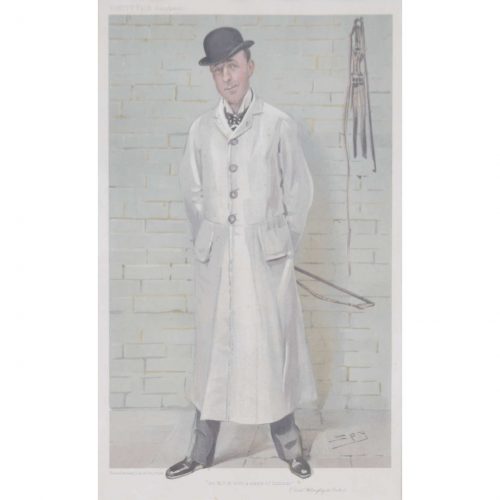
Sir Leslie 'Spy' Ward for Vanity Fair Magazine
An MFH with a sense of humour (1905)
Lithograph 36 x 21 cm Published in Vanity Fair on 23rd November 1905. The 'MFH with a sense of humour' depicted here is Richard Greville Verney, 19th Baron Willoughby de Broke (1869 - 1923), British peer, Conservative politician, and Master of Foxhounds. Verney was the son of Colonel Henry Verney, 18th Baron Willoughby de Broke and Geraldine Smith-Barry, and was educated at Eton College and New College, Oxford. The historian George Dangerfield described Verney as "a genial and sporting young peer, whose face bore a pleasing resemblance to the horse. ... He had quite a gift for writing, thought clearly, and was not more than two hundred years behind his time." He wrote a book on foxhunting called "Hunting the Fox", which was published in 1921 and remains an acclaimed text on the sport today. Verney represented Rugby, Warwickshire, as an MP from 1895–1900. In 1902 he succeeded his father as 19th Baron Willoughby de Broke. Condition: very good. If you’d like to know more, please email info@manningfineart.co.uk or call us on 07929 749056. -

Edward Bawden (1903 - 1989)
Aesop's Fables: Peacock and Magpie (1970)
Linocut print 63 x 75 cm Signed, numbered 11/50, and titled in pencil. A delightful print illustrating Aesop's fable of the Peacock and Magpie. In the fable, the birds are searching for a king, and the Peacock puts himself forward. The birds are about to make him king because of his charming plumage, but a Magpie asks the Peacock how he might defend the birds from predators. The Peacock has no answer. Aesop's moral is that those in power must be suited to the task, and not just vain pretenders. The artist's use of vibrant colour brings the tale to life. Edward Bawden was an English painter, illustrator and graphic artist, known for his prints, book covers, posters, and garden metalwork furniture. Bawden taught at the Royal College of Art, where he had been a student, worked as a commercial artist, and served as a war artist in World War II. He illustrated several books and painted various public murals, and his work and career are often associated with that of his contemporary, Eric Ravilious. Condition: generally very good; small stain to extremity that will be hidden under mount. If you’d like to know more, please email info@manningfineart.co.uk or call us on 07929 749056. -
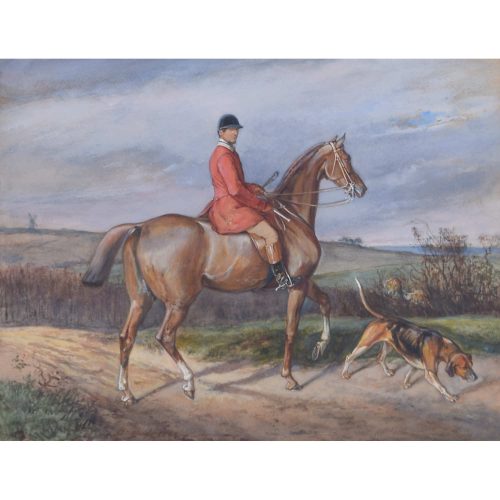
H. Fluiss
Charles Payne, Huntsman to the Pytchley Hounds on Redtape with the hound Trueman (1862)
Watercolour with body colour 36 x 43 cm A mid-nineteenth century watercolour depicting Charles Payne (1884–1967), huntsman to the Pytchley. Condition: very good. If you are interested, please email info@manningfineart.co.uk or call us on 07929 749056. -

John Stanton Ward CBE (1917 - 2007)
St John's College, Cambridge
Watercolour 30 x 47 cm John Stanton Ward CBE was an English portrait artist, landscape painter and illustrator. This view of St John's highlights the dreamlike quality of the college and its city. Ward depicts Cambridge on a winter afternoon; the trees are bare, and the afternoon sun sets gently over the city's lawns and high spires. Condition: very good. -
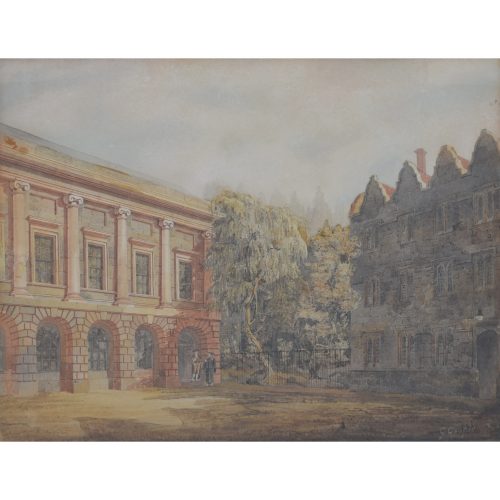
G. Cooper
Oriel College, Oxford
Watercolour 27 x 35 cm A view of Oriel's Second Quad, featuring the Wyatt Building on the left. Designed in the Neoclassical style by James Wyatt, it was built between 1788 and 1796 when the College's library doubled in size thanks to a generous gift by Edward, Baron Leigh, formerly High Steward of the university and an alumnus of Oriel. The building has rusticated arches on the ground floor and a row of Ionic columns above, dividing the façade into seven bays. Cooper's watercolour focuses on the architectural merit of the building, highlighting the sandy tone of Oxford's famous Headington stone. Two figures in academic dress take part in a spirited discussion just outside the building. Condition: generally very good. -
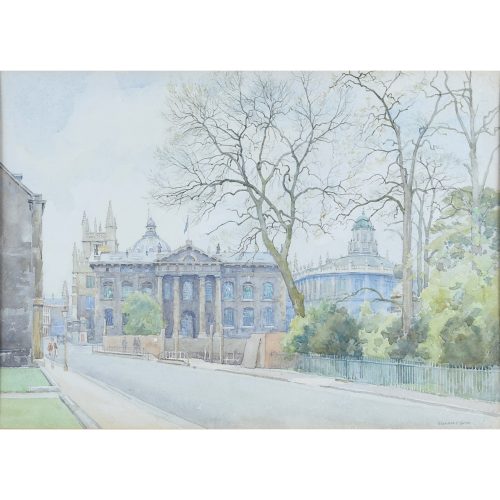
Bernard Cecil Gotch (1876-1964)
Clarendon Building and Sheldonian Theatre, Oxford
Watercolour 27 x 39 cm Signed lower right. Gotch's wintry view of the Clarendon and the Sheldonian captures both the most illustrious architecture of the University of Oxford, and the building works taking place to build a new library. Gotch paints his scene from a viewpoint just in front of Wadham College; the Radcliffe Camera and the spire of the University Church of St Mary the Virgin are visible behind the Sheldonian's roof. The building site visible across from Wadham is the site where the New Bodleian now stands. Bernard Cecil Gotch was a Winchester born artist who is best known for his atmospheric watercolours of Britain's towns and cities (most notably Oxford). He moved to Oxford in 1927, painting many watercolours of the interiors and exteriors of Oxford’s many buildings. His works concentrate on the grand exteriors and interiors of the University's colleges, and he exhibited frequently - including an exhibition every term at Oriel College. His first notable commission was for the publisher Methuen, illustrating 'A Shepherd’s Life' by W H Hudson. Whilst in London he was invited to illustrate a book on the Public Schools of England (which was sadly never completed). He exhibited watercolours at the Fine Art Society and Lincolns Inn, and also exhibited at the Royal Academy. In 1952 Gotch was given an Honorary MA by the University of Oxford, and, after his death in 1963, a memorial was held for him at Oriel. Condition: very good; original oak frame. -
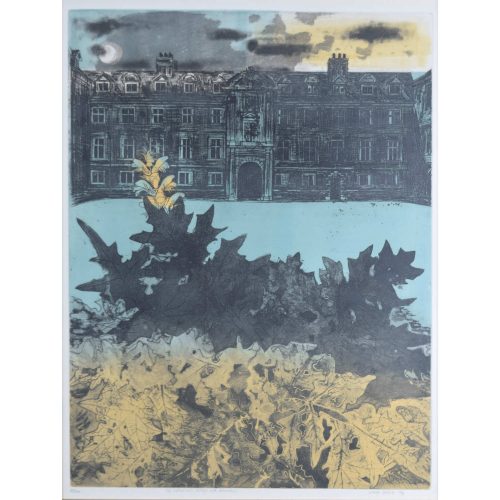
Walter Hoyle (1922-2000)
St Catharine's College, Cambridge (1973)
Linocut 72 x 56 cm Signed and dated '73 lower right, numbered 85 / 200 lower left, and signed below. Hoyle trained at Beckenham School of Art and the Royal College of Art. At the RA, he was strongly influenced by Edward Bawden, one of Britain’s greatest linocut printers. Bawden had been commissioned by the 1951 Festival of Britain to produce a mural for the South Bank, and chose Hoyle, a promising student, as his assistant. Hoyle moved to Great Bardfield in Essex and became part of the Great Bardfield group of artists: diverse in style, they created figurative work in stark contrast to the abstract art of the St Ives artists at the other end of the country. Hoyle taught at St Martin’s School of Art from 1951 - 1960, the Central School of Arts and Crafts from 1960 - 1964, and the Cambridge School of Art from 1964 - 1985, during which time he launched Cambridge Print Editions. His work is held in the collections of the Tate Gallery, the Victoria and Albert Museum, The British Museum, Kettle’s Yard, and the Fry Art Gallery. Condition: very good. If you are interested, please email info@manningfineart.co.uk or call us on 07929 749056. -
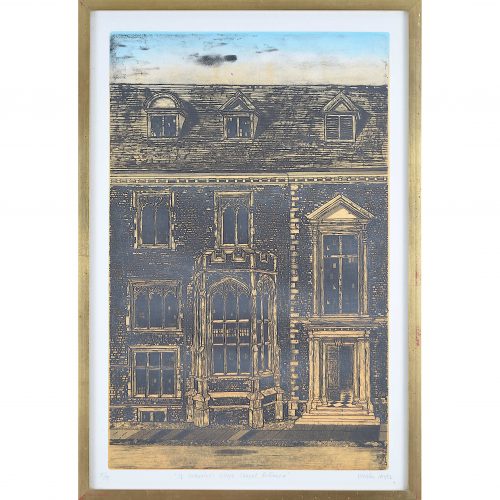
Walter Hoyle (1922-2000)
St Catharine's College, Cambridge (1956-66)
Linocut 59 x 39 cm Signed lower right; inscribed and numbered 35/75 in pencil. Hoyle trained at Beckenham School of Art and the Royal College of Art. At the latter he was strongly influenced by Edward Bawden, one of Britain’s greatest linocut printers. Bawden had been commissioned by the 1951 Festival of Britain to produce a mural for the South Bank, and chose Hoyle to assist on account of his great talent. Hoyle moved to Great Bardfield in Essex, becoming a part of the Great Bardfield group of artists; diverse in style, they created figurative work, in stark contrast to the abstract art of the St Ives artists at the opposite end of the country. Hoyle taught at St Martin’s School of Art from 1951-60, the Central School of Arts and Crafts from 1960-64, and the Cambridge School of Art from 1964-1985, during which time he launched Cambridge Print Editions. His work is held in the collections of the Tate Gallery, the Victoria and Albert Museum, The British Museum, Kettle’s Yard and the Fry Art Gallery. Condition: very good. -
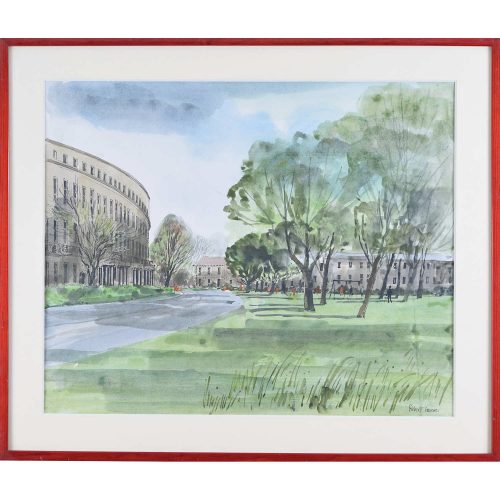
Robert Tavener (1920 - 2004)
Lansdown Parade, Cheltenham
Watercolour and pen 38 x 46 cm Signed lower right. The thin watercolour wash of the lawns and the fine ink pen expression of the college's architecture create a contrast between the natural and the man-made in this picture by Tavener. He painted several views of the city of Cheltenham and its architectural landmarks, including of Cheltenham College (this picture is available here). Condition: generally very good. -
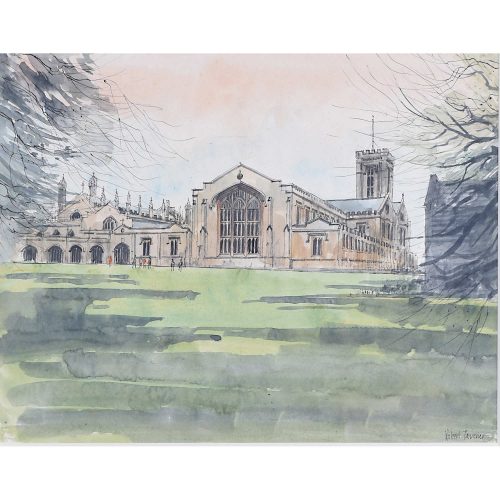
Robert Tavener (1920 - 2004)
Cheltenham College
Watercolour and pen 28 x 35 cm Signed lower right. What is particularly interesting about this picture is the contrast between the rugged watercolour wash of the lawn and the fine pen expression of the college's architecture. Tavener painted several views of the city of Cheltenham and its architectural landmarks; Cheltenham College is a public school just outside the city, and Tavener expertly elicits its mid-nineteenth century architectural style here. -
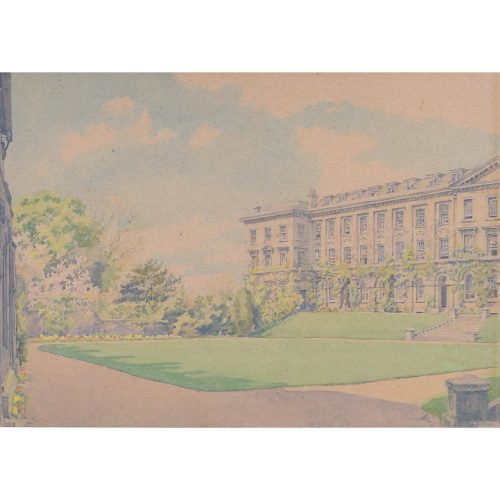
Bernard Cecil Gotch (1876-1964)
Worcester College, Oxford
Watercolour 26 x 38 cm Signed lower right. Gotch's watercolour highlights the verdant lawns and leafy foliage of one of Oxford's greenest and most beautiful colleges. Bernard Cecil Gotch was a Winchester born artist who is best known for his atmospheric watercolours of Britain's towns and cities (most notably Oxford). He moved to Oxford in 1927, painting many watercolours of the interiors and exteriors of Oxford’s many buildings. His works concentrate on the grand exteriors and interiors of the University's colleges, and he exhibited frequently - including an exhibition every term at Oriel College. His first notable commission was for the publisher Methuen, illustrating 'A Shepherd’s Life' by W H Hudson. Whilst in London he was invited to illustrate a book on the Public Schools of England (which was sadly never completed). He exhibited watercolours at the Fine Art Society and Lincolns Inn, and also exhibited at the Royal Academy. In 1952 Gotch was given an Honorary MA by the University of Oxford, and, after his death in 1963, a memorial was held for him at Oriel. Provenance: detailed on label to reverse. Condition: generally very good, painted on 'rough' paper; signed and titled to label. -
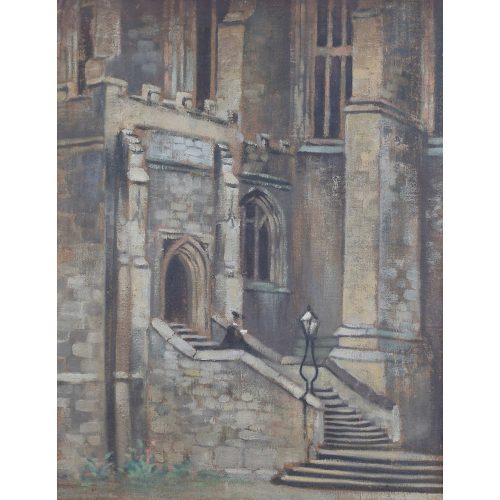
'Eton College, a scholar on the steps' (early 20th century)
Oil on canvas 62 x 49 One of our favourite paintings. A lone scholar descends the Chapel steps, a human focal point in an oil painting primarily concerned with the College's fine architecture. A blur of green and red sprouts at the bottom of the wall - flowers. In a handsome period hardwood frame. Condition: very good. -
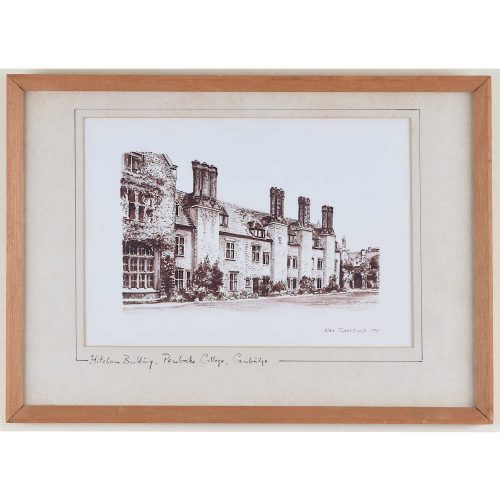
Ray Turrefield (active late 20th century)
Hitcham Building, Pembroke College, Cambridge (1978)
Print 18 x 25 cm Signed and dated lower right. A print of Pembroke College, Cambridge's Hitcham Building. Built in 1659, the Hitcham Building marks the first instance in Pembroke of the Classical Style, which was soon to find full expression in Wren’s Chapel. The building was intended for the Master’s use and was originally connected to the former Master’s Lodge. Both the poet Thomas Gray and the Prime Minister William Pitt lived in the building during their times at Pembroke. Condition: very good. -
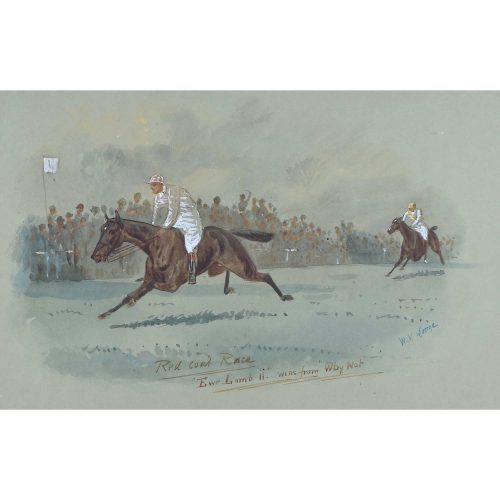
William Verner Longe (1857-1924)
Cottenham, December 1904
Watercolour 29 x 45 cm Signed and inscribed 'Red Coat Race, "Ewe Lamb ii" wins from "Why Not"'. A lively racing scene by William Verner Longe, and English artist noted for his scenes of racing, hunting, and other equestrian activities. He was educated at the Ipswich School of Arts and then the Royal Academy of Fine Arts in Antwerp. Condition: generally very good; original frame with antique glass. Some discolouration to margins. -
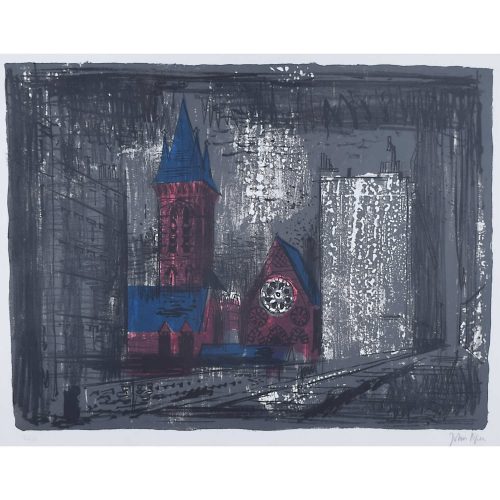
John Piper (1903-1992)
St James the Less, Westminster
Screenprint 65 x 49 cm From the 'Retrospect of Churches' series, numbered 24/70. Generally very good. Signed in pencil. John Piper CH was an English painter, printmaker, and designer of stained-glass windows. His work often focused on the British landscape, especially churches and monuments, and included tapestry designs, book jackets, screen-prints, photography, fabrics and ceramics. A Retrospect of Churches was issued as a suite of 24 original colour lithographs in colour, in an edition of 70 copies (70 numbered copies plus five artist's proofs). This poignant and dramatic representation of St James the Less is an evocative depiction of this part of London in the evening: wet pavements reflect the bright lights of the buildings, and the church is a warm, moody reddish-purple against the deep black of a dark night. Condition: Generally very good. -
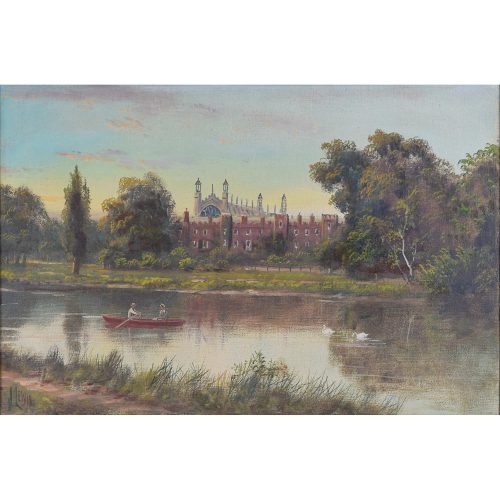
J. Lewis (fl. 1801-1808)
Eton College from the River
Oil on canvas 41 x 62 cm Signed lower left. While not a prolific artist, Lewis was noted for his views of the Thames - this view of Eton College is remarkable for its depiction of the river and wider environs of the school, as well as its architecture. Two snowy swans and boater-clad boys complete the view from the other sides of the Thames. Condition: very good. -
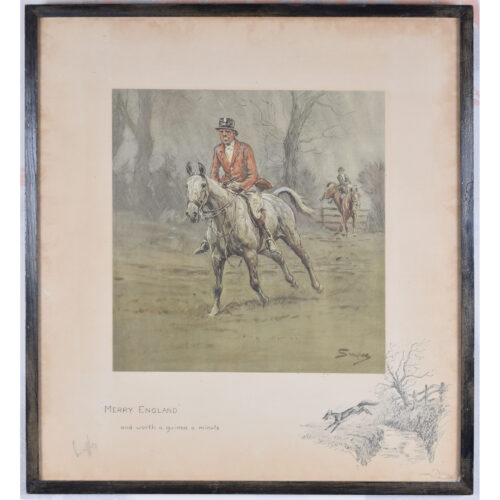
Charles "Snaffles" Johnson Payne (1884 - 1967)
"Merry England and worth a guinea a minute"
Lithograph 44 x 41 cm Signed in pencil lower left. Snaffles was one of the foremost sporting artists of his era, publishing many popular prints such as these: hunting pictures, racing scenes, and military subjects. Snaffles' distinctive drawing style is emphasised by his 'remarque' - sketches in the margin - and his witty titles. Condition: generally good; some age toning to backing paper. In original half-inch black frame. If you are interested, please email info@manningfineart.co.uk or call us on 07929 749056. Click here for other hunting pictures. -
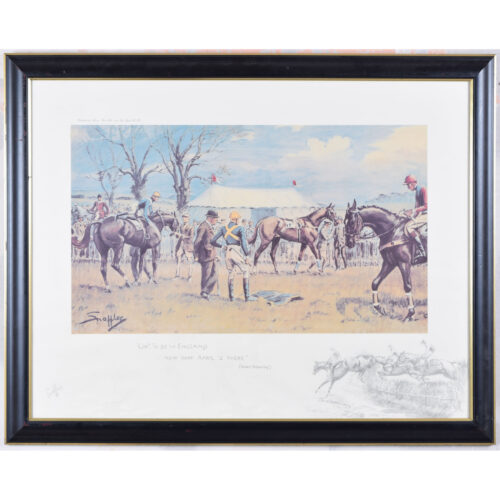
Charles "Snaffles" Johnson Payne (1884 - 1967)
"Oh! To Be In England Now That April's There"
Lithograph 51 x 67 cm Signed in pencil lower left. Snaffles was one of the foremost sporting artists of his era, publishing many popular prints such as these: hunting pictures, racing scenes, and military subjects. Snaffles' distinctive drawing style is emphasised by his 'remarque' - sketches in the margin - and his witty titles. Condition: generally very good; crease to top left corner; slight unevenness to bottom edge; a few scratches to frame. -
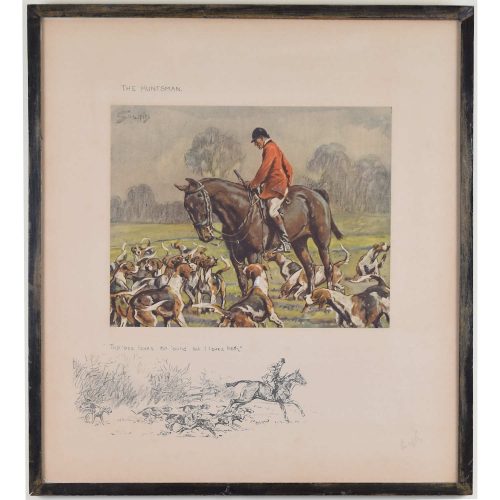
Charles "Snaffles" Johnson Payne (1884-1967)
The Huntsman: "The 'oss loves the 'ound but I loves both"
Lithograph 47 x 43 cm Signed in pencil with Snaffles' bit blindstamp, in original 1/2" frame. Snaffles was one of the foremost sporting artists of his era, publishing many popular prints such as these: hunting pictures, racing scenes, and military subjects. Snaffles' distinctive drawing style is emphasised by his 'remarque' - sketches in the margin - and his witty titles. Condition: very good. Small chip to bottom centre of frame. -
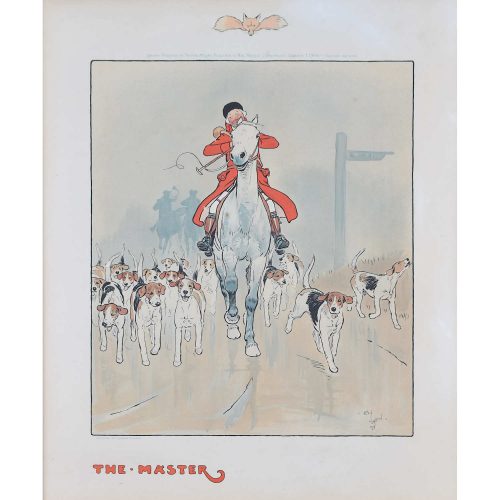
Cecil Aldin (1870 - 1935)
The Master
Lithograph 48 x 40 cm A jolly lithograph of an MFH and his hounds. Cecil Charles Windsor Aldin was a British artist and illustrator best known for his paintings and sketches of animals, sports, and rural life. Aldin executed village scenes and rural buildings in chalk, pencil, and also wash sketching. He was an enthusiastic sportsman and a Master of Fox Hounds, and many of his pictures illustrated hunting. Aldin's early influences included Randolph Caldecott and John Leech. Condition: generally very good, a few marks to margins, one or two marks to frame. -
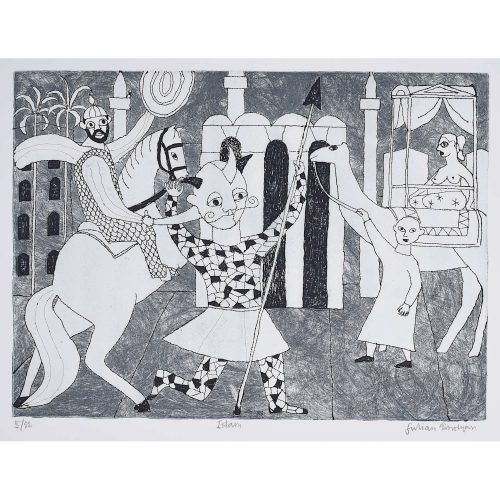 Julian Trevelyan (1910-1988) Islam Etching 35 x 48 cm (sheet size 55 x 68 cm) Nephew of the historian G M Trevelyan, Julian Trevelyan was educated at Bedales and then at Trinity College, Cambridge, where he read English. After moving to Paris, Trevelyan studied engraving at Stanley William Hayter’s school, working alongside artists such as Max Ernst, Joan Miro and Pablo Picasso. He married the potter Ursula Darwin in 1934, and in 1935 they moved to Hammersmith, buying Durham Wharf beside the River Thames which was Trevelyan’s studio – and home – for the rest of his life. His wartime service was – like so many artists – as a camoufleur. A Royal Engineer from 1940-43, he served in North Africa and Palestine, forcing the German Afrika Korps to use resources against a dummy army whilst real tanks were disguised as more harmless equipment. In the desert, nothing could be hidden - but it could be disguised. Following the dissolution of his marriage in 1950, he married the painter Mary Fedden. Teaching at Chelsea School of Art, Trevelyan eventually became head of the Etching Department and his pupils included David Hockney and Peter Ackroyd. Condition: mounted to board.
Julian Trevelyan (1910-1988) Islam Etching 35 x 48 cm (sheet size 55 x 68 cm) Nephew of the historian G M Trevelyan, Julian Trevelyan was educated at Bedales and then at Trinity College, Cambridge, where he read English. After moving to Paris, Trevelyan studied engraving at Stanley William Hayter’s school, working alongside artists such as Max Ernst, Joan Miro and Pablo Picasso. He married the potter Ursula Darwin in 1934, and in 1935 they moved to Hammersmith, buying Durham Wharf beside the River Thames which was Trevelyan’s studio – and home – for the rest of his life. His wartime service was – like so many artists – as a camoufleur. A Royal Engineer from 1940-43, he served in North Africa and Palestine, forcing the German Afrika Korps to use resources against a dummy army whilst real tanks were disguised as more harmless equipment. In the desert, nothing could be hidden - but it could be disguised. Following the dissolution of his marriage in 1950, he married the painter Mary Fedden. Teaching at Chelsea School of Art, Trevelyan eventually became head of the Etching Department and his pupils included David Hockney and Peter Ackroyd. Condition: mounted to board. -

Albert Walter Moore (1874 – 1965)
Design for 30 Fenchurch Street (1915)
Pencil and watercolour on paper 38.1 x 62 cm Signed and inscribed ‘Albert W Moore FRIBA Architect, 112 Fenchurch St, March 1915’. Provenance: Sotheby’s lot 166, 25 June 1981. A design for a fine building on the Plantation House site (the site was cleared in 2005 for a new building, '30 Fenchurch Street'). The architectural drawing is rendered carefully in pencil, with blue, yellow, and brown washes adding colour and depth to the picture. Moore was articled to George Hubbard, and the two became partners in 1898. He studied at the West London School of Art and was a member of the Architectural Association. Condition: very good; some losses to frame. -
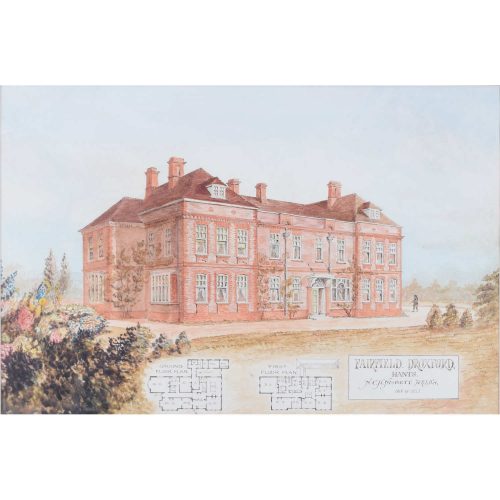
Norman Clayton Hadlow Nisbet ARIBA
Design for Fairfield House, Droxford, Hampshire (c. 1910)
Watercolour and pencil 33 x 51 cm Signed and extensively inscribed. Exhibited at the Royal Academy, 1910. A fine design for an Edwardian country house in England by Norman Nisbet ARIBA, an architect who at the time was practising at 45 Jewry Street, Winchester. The house still stands today, although it is subject to proposals for extension and conversion to a hotel. Condition: very good. -
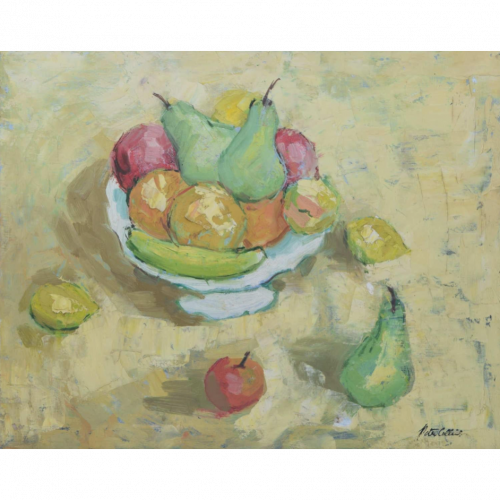
Peter Collins ARCA (1923-2001)
Still Life of a Fruit Bowl (c. 1960s)
Oil on canvas 40 x 51 cm Signed lower right. A stylish mid-century still life with fruit. Collins's first job was at an advertising agency, in the commercial studio. World War II interrupted his career and he joined the Royal Artillery (of the British Army), teaching painting and drawing in the Education Corps - whilst simultaneously teaching at St Martin's School of Art, part time. Following the war, Collins studied at the Royal College of Art, winning a scholarship. He then worked as a commercial artist, producing some well-known posters for clients including British Railways and British European Airways. He was the Art Director at Odhams Press and spent time designing for both ICI and Shell. With his wife Georgette, he created the 'Bacombe Galleries' in Sussex, converting a group of buildings into a gallery space. In 1975 they developed the Stanley Studios in Chelsea, which were scheduled for redevelopment, into a combined artists' studio and residence. Moving into the Stanley Studios allowed the Collinses to immerse themselves in Chelsea's art scene, and they proceeded to fill the studios with art, antiques, scupture, and other curios. Provenance: the artist's studio sale 2017, lot 2050. Condition: very good. -

Angela Stones (1914 - 1995)
Still Life with Fruit and Bottle
Oil on board 39 x 49 cm A stylish mid-century still life. Stones was educated at the Chelsea School of Art, and was a member of an artistic dynasty. Her mother Dorothy Bradshaw (1893-1983) studied under Jack Merriott – the artist famous for his British Rail posters, and her son, Christopher Assheton-Stones (1947-1999), was arguably the foremost pastel artist of his time. Provenance: the family of the artist. Condition: Generally very good. If you’d like to know more, please email info@manningfineart.co.uk or call us on 07929 749056.

